Table of Contents
- Cover
- Introduction
- Getting Started
- Charging the Battery
- Installing and Removing the Battery and Card
- Turning on the Power
- Setting the Date, Time, and Zone
- Selecting the Interface Language
- Attaching and Detaching a Lens
- Basic Operation
- Quick Control for Shooting Functions
- Menu Operations
- Formatting the Card
- Switching the LCD Monitor Display
- Feature Guide
- Basic Shooting and Image Playback
- Fully Automatic Shooting (Scene Intelligent Auto)
- Full Auto Techniques (Scene Intelligent Auto)
- Disabling Flash
- Creative Auto Shooting
- Shooting Portraits
- Shooting Landscapes
- Shooting Close-ups
- Shooting Moving Subjects
- Shooting Food
- Shooting Night Portraits
- Quick Control
- Shooting with Ambience Selection
- Shooting by Lighting or Scene Type
- Image Playback
- Creative Shooting
- Advanced Shooting
- Conveying the Subject’s Movement
- Changing the Depth of Field
- Manual Exposure
- Changing the Metering Mode
- Setting Exposure Compensation
- Auto Exposure Bracketing
- Locking the Exposure
- Locking the Flash Exposure
- Auto Correction of Brightness and Contrast
- Correcting the Image’s Dark Corners
- Customizing Image Characteristics
- Registering Preferred Image Characteristics
- Matching the Light Source
- Adjusting the Color Tone for the Light Source
- Setting the Color Reproduction Range
- Shooting with the LCD Monitor (Live View Shooting)
- Shooting Movies
- Handy Features
- Image Playback
- Post-Processing Images
- Printing Images
- Customizing the Camera
- Reference
- Software Start Guide / Downloading Images to a Computer
Canon 1300D + 18-55IS User Manual
Displayed below is the user manual for 1300D + 18-55IS by Canon which is a product in the Digital Cameras category. This manual has pages.
Related Manuals

2
The EOS REBEL T6 (W) or EOS 1300D (W) is a digital single-lens
reflex camera featuring a fine-detail CMOS sensor with approx. 18.0
effective megapixels, DIGIC 4+, high-precision and high-speed 9-point
AF, approx. 3.0 fps continuous shooting, Live View shooting, Full High-
Definition (Full HD) movie shooting, and wireless functions (Wi-Fi/NFC).
Before Starting to Shoot, Be Sure to Read the Following
To avoid botched pictures and accidents, first read the “Safety
Precautions” (p.20-22) and “Handling Precautions” (p.23-25). Also, read
this manual carefully to ensure that you use the camera correctly.
Refer to This Manual while Using the Camera to Further
Familiarize Yourself with the Camera
While reading this manual, take a few test shots and see how they
come out. You can then better understand the camera. Be sure to store
this manual safely, too, so that you can refer to it again when necessary.
Testing the Camera Before Use and Liability
After shooting, play images back and check whether they have been
properly recorded. If the camera or memory card is faulty and the
images cannot be recorded or downloaded to a computer, Canon
cannot be held liable for any loss or inconvenience caused.
Copyrights
Copyright laws in your country may prohibit the use of your recorded
images or copyrighted music and images with music in the memory
card for anything other than private enjoyment. Also be aware that
certain public performances, exhibitions, etc., may prohibit photography
even for private enjoyment.
Introduction

3
Before starting, check that all the following items are included with your
camera. If anything is missing, contact your dealer.
* Battery Charger LC-E10 or LC-E10E is provided. (The LC-E10E comes with a
power cord.)
The Instruction Manuals provided are listed on the next page.
If you purchased a Lens Kit, check that the lenses are included.
Depending on the Lens Kit type, lens instruction manuals may also be
included.
Be careful not to lose any of the above items.
Item Check List
Battery Pack LP-E10
(with protective cover)
Battery Charger
LC-E10/LC-E10E*
Strap
Camera
(with eyecup and body cap)
Interface Cable
When you need Lens Instruction Manuals, download them from the Canon
Web site (p.4).
The lens instruction manuals (PDF) are for lenses sold individually. Note
that when purchasing the Lens Kit, some of the accessories included with
the lens may not match those listed in the Lens Instruction Manual.

4
Camera and Wireless Function Basic Instruction
Manual
The booklet is the Basic Instruction Manual.
More detailed Instruction Manuals (PDF files) can be
downloaded from the Canon Web site.
1Download the Instruction Manuals (PDF files).
Connect to the Internet and access the following Canon Web site.
www.canon.com/icpd
Select your country or region of residence and download the
Instruction Manuals.
Instruction Manuals Available for Download
• Camera Instruction Manual
• Wireless Function Instruction Manual
• Camera and Wireless Function Basic Instruction Manual
• Lens Instruction Manuals
• Software Instruction Manuals
2View the Instruction Manuals (PDF files).
Double-click a downloaded Instruction Manual (PDF file) to open
it.
To view the Instruction Manuals (PDF files), Adobe Acrobat
Reader DC or other Adobe PDF viewer (most recent version
recommended) is required.
Adobe Acrobat Reader DC can be downloaded free from the
Internet.
To learn how to use a PDF viewer, refer to its Help section.
Instruction Manuals
Downloading and Viewing the Instruction Manuals (PDF Files)
Software can be downloaded from the Canon Web site (p.315).

5
The following cards can be used with the camera regardless of
capacity: If the card is new or was previously formatted by another
camera or computer, it is recommended that you format the card
with this camera (p.52).
• SD memory cards
• SDHC memory cards
• SDXC memory cards
When shooting movies, use a large-capacity SD card rated SD
Speed Class 6 “ ” or higher.
If you use a slow-writing card when shooting movies, the movie may
not be recorded properly. Also, if you play back a movie on a card
with a slow reading speed, the movie may not play back properly.
To check the card’s reading/writing speed, refer to the card
manufacturer’s Web site.
Compatible Cards
Cards that Can Record Movies
The camera can use UHS-I cards, but since it is not compatible with the
UHS-I standard, reading/writing speeds will be equivalent to SD Speed
Class 10 at most.
In this manual, “card” refers to SD memory cards, SDHC memory
cards, and SDXC memory cards.
*The camera does not come with a card for recording images/
movies. Please purchase it separately.

6
Quick Start Guide
1Insert the battery (p.36).
To charge the battery, see page 34.
2Insert the card (p.36).
With the card’s label facing toward
the back of the camera, insert it into
the card slot.
3Attach the lens (p.44).
Align the lens’s white or red mount
index with the camera’s mount index
of the same color.
4Set the lens’s focus mode
switch to <AF> (p.44).
5Set the power switch to <1>
(p.39).
When the LCD monitor displays the
date/time/zone setting screens, see
page 41.
White index Red index

7
Quick Start Guide
6Set the Mode Dial to <A>
(Scene Intelligent Auto) (p.58).
All the necessary camera settings
will be set automatically.
7Focus on the subject (p.47).
Look through the viewfinder and
aim the viewfinder center over the
subject.
Press the shutter button halfway, and
the camera will focus on the subject.
If necessary, the built-in flash will be
raised.
8Take the picture (p.47).
Press the shutter button completely
to take the picture.
9Review the picture.
The captured image will be
displayed for approx. 2 sec. on the
LCD monitor.
To display the image again, press
the <x> button (p.83).
To shoot while looking at the LCD monitor, see “Live View
Shooting” (p.139).
To view the images captured so far, see “Image Playback” (p.83).
To delete an image, see “Erasing Images” (p.230).

8
Icons in this Manual
<6> : Indicates the Main Dial.
<W><X><Y><Z> : Indicates the <S> cross keys on the top,
bottom, left, and right.
<0> : Indicates the Setting button.
0, 9, 7, 8: Indicates that each function remains active for
approx. 4 sec., 6 sec., 10 sec., or 16 sec. after
you let go of the button.
* In addition to the above, the icons and symbols used on the camera’s buttons
and displayed on the LCD monitor are also used in this manual when discussing
relevant operations and functionality.
3: Indicates a function that can be changed by pressing the
<M> button to change its settings.
M: When shown on the upper right of a page, it indicates that
the function is available only in the Creative Zone modes
(p.30).
(p.**) : Reference page numbers for more information.
: Warning to prevent shooting problems.
: Supplemental information.
: Tips or advice for better shooting.
: Troubleshooting advice.
Basic Assumptions
All operations explained in this manual assume that the power switch
is set to <1> (p.39).
It is assumed that all the menu settings and Custom Functions are
set to their defaults.
The illustrations in this manual show the camera attached with the
EF-S18-55mm f/3.5-5.6 IS II lens as an example.
Conventions Used in this Manual

9
For first-time DSLR users, Chapters 1 and 2 explain the camera’s
basic operations and shooting procedures.
Chapters
Introduction 2
Getting Started 33
Basic Shooting and Image Playback 57
Creative Shooting 85
Advanced Shooting 107
Shooting with the LCD Monitor (Live View
Shooting) 139
Shooting Movies 159
Handy Features 183
Image Playback 207
Post-Processing Images 235
Printing Images 241
Customizing the Camera 257
Reference 269
Software Start Guide /
Downloading Images to a Computer 313
1
2
3
4
5
6
7
8
9
10
11
12
13

10
Contents at a Glance
Shooting
Shoot automatically p.57-82 (Basic Zone modes)
Shoot continuously p.102 (i Continuous shooting)
Take a picture of yourself in a group
p.103 (j Self-timer)
Freeze the action p.108 (s Shutter-priority AE)
Blur the action
Blur the background p.64 (C Creative Auto)
Keep the background in sharp focus
p.110 (f Aperture-priority AE)
Adjust the image brightness (exposure)
p.116 (Exposure compensation)
Shoot in low light p.58, 104 (D Flash photography)
p.92 (ISO speed setting)
Shoot without flash p.63 (7 Flash Off)
p.75 (b Flash Off)
Shoot fireworks at night p.114 (Bulb exposure)
Shoot while viewing the LCD monitor
p.139 (A Live View shooting)
Shoot movies p.159 (k Movie shooting)
Image Quality
Shoot with image effects p.95 (Picture Style)
matching the subject
Make a large-size print of the picture
p.88 (73, 83, 1)

11
Take many pictures p.88 (7a, 8a, b, c)
Focusing
Change the point of focus p.99 (S AF point selection)
Shoot a moving subject p.70, 98 (AI Servo AF)
Playback
View the images on the camera p.83 (x Playback)
Search for pictures quickly p.208 (H Index display)
p.209 (I Image browsing)
Rate images p.212 (Ratings)
Prevent important images p.228 (K Image protect)
from accidental deletion
Delete unnecessary images p.230 (L Delete)
Auto play back photos and movies
p.222 (Slide show)
View the photos or movies on a TV set
p.226 (TV set)
Adjust the LCD monitor brightness
p.185 (LCD monitor brightness)
Apply special effect to images p.236 (Creative filters)
Printing
Print pictures easily p.241 (Direct printing)

12
Power
Battery
• Charging p.34
• Installing/Removing p.36
• Battery level p.40
Household power outlet p.270
Auto power off p.39
Cards
Installing/Removing p.36
Formatting p.52
Release shutter
without card p.184
Lens
Attaching/Detaching p.44
Zoom p.45
Basic Settings
Dioptric adjustment p.46
Language p.43
Date/Time/Zone p.41
Beeper p.184
LCD off/on button p.197
LCD brightness
adjustment p.185
Recording Images
Creating/Selecting
a folder p.186
File numbering p.188
Image Quality
Image-recording quality p.88
Picture Style p.95
White balance p.131
Color space p.137
Image enhancement features
• Auto Lighting Optimizer p.123
• Lens peripheral
illumination correction p.124
• Noise reduction for
long exposures p.262
• Noise reduction for
high ISO speeds p.263
• Highlight tone priority p.263
AF
AF operation p.97
AF point selection p.99
Manual focusing p.101
Drive
Drive mode p.28
Continuous shooting p.102
Self-timer p.103
Maximum burst p.90
Shooting
Shooting mode p.30
ISO speed p.92
Feature guide p.55
Bulb p.114
Metering mode p.115
Quick Control p.48
Index to Features

13
Index to Features
Exposure
Exposure compensation p.116
AEB p.118
AE lock p.120
Flash
Built-in flash p.104
• Flash exposure
compensation p.117
• FE lock p.121
External flash p.272
Flash control p.198
Live View Shooting
Live View shooting p.139
Autofocusing (AF)
methods p.148
Aspect ratio p.146
Grid p.145
Quick Control p.144
Movie Shooting
Movie shooting p.159
Sound recording p.178
Grid p.179
Manual exposure p.162
Quick Control p.167
Video snapshot p.170
Playback
Image review time p.184
Single-image display p.83
Shooting information
display p.232
Index display p.208
Image browsing
(Jump display) p.209
Magnified view p.210
Image rotate p.211
Rating p.212
Movie playback p.218
Editing out movie’s
first/last scene p.220
Slide show p.222
Viewing images on a
TV set p.226
Protect p.228
Erase p.230
Quick Control p.214
Image Editing
Creative filters p.236
Resize p.239
Printing
PictBridge p.244
Print Order (DPOF) p.251
Photobook Set-up p.255
Customization
Custom Functions (C.Fn) p.258
My Menu p.267
Software
Software Start Guide p.314
Software Instruction
Manuals p.316
Wireless Functions
Wireless Function Instruction
Manual

14
1
Introduction 2
Item Check List................................................................................. 3
Instruction Manuals .......................................................................... 4
Compatible Cards............................................................................. 5
Quick Start Guide ............................................................................. 6
Conventions Used in this Manual..................................................... 8
Chapters........................................................................................... 9
Contents at a Glance...................................................................... 10
Index to Features ........................................................................... 12
Safety Precautions ......................................................................... 20
Handling Precautions ..................................................................... 23
Nomenclature ................................................................................. 26
Getting Started 33
Charging the Battery ...................................................................... 34
Installing and Removing the Battery and Card............................... 36
Turning on the Power ..................................................................... 39
Setting the Date, Time, and Zone................................................... 41
Selecting the Interface Language................................................... 43
Attaching and Detaching a Lens..................................................... 44
Basic Operation.............................................................................. 46
Q Quick Control for Shooting Functions ....................................... 48
3 Menu Operations.................................................................. 50
Formatting the Card ....................................................................... 52
Switching the LCD Monitor Display ................................................ 54
Feature Guide ................................................................................ 55
Contents

15
Contents
3
2Basic Shooting and Image Playback 57
A Fully Automatic Shooting (Scene Intelligent Auto) ...................58
A Full Auto Techniques (Scene Intelligent Auto)..........................61
7 Disabling Flash .........................................................................63
C Creative Auto Shooting.............................................................64
2 Shooting Portraits ......................................................................67
3 Shooting Landscapes ...............................................................68
4 Shooting Close-ups....................................................................69
5 Shooting Moving Subjects ........................................................70
P Shooting Food ............................................................................71
6 Shooting Night Portraits .............................................................72
Q Quick Control.............................................................................74
Shooting with Ambience Selection..................................................76
Shooting by Lighting or Scene Type ...............................................80
x Image Playback ........................................................................83
Creative Shooting 85
d: Program AE...............................................................................86
Setting the Image-Recording Quality ..............................................88
i: Changing the ISO Speed to Suit the Light Level.....................92
A Selecting Optimal Image Characteristics for the Subject
(Picture Style)..................................................................................95
f: Changing the Autofocus Operation (AF operation) ..................97
S Selecting the AF Point ..............................................................99
Subjects Difficult to Focus on........................................................101
MF: Manual Focus .....................................................................101
i Continuous Shooting ...............................................................102
j Using the Self-timer .................................................................103
D Using the Built-in Flash .............................................................104

Contents
16
5
4Advanced Shooting 107
s: Conveying the Subject’s Movement ..................................... 108
f: Changing the Depth of Field .................................................110
Depth-of-Field Preview ...............................................................112
a: Manual Exposure ....................................................................113
q Changing the Metering Mode..................................................115
Setting Exposure Compensation...................................................116
Auto Exposure Bracketing.............................................................118
A Locking the Exposure ............................................................. 120
A Locking the Flash Exposure.................................................... 121
Auto Correction of Brightness and Contrast (Auto Lighting Optimizer)
... 123
Correcting the Image’s Dark Corners........................................... 124
A Customizing Image Characteristics (Picture Style) .............. 126
A
Registering Preferred Image Characteristics (Picture Style)
... 129
B: Matching the Light Source (White balance)......................... 131
u Adjusting the Color Tone for the Light Source......................... 135
Setting the Color Reproduction Range (Color space) .................. 137
Shooting with the LCD Monitor (Live View Shooting) 139
A Shooting with the LCD Monitor .............................................. 140
Shooting Function Settings .......................................................... 144
Menu Function Settings................................................................ 145
Using AF to Focus (AF Method)................................................... 148
MF: Focusing Manually ................................................................ 156

17
Contents
7
6Shooting Movies 159
k Shooting Movies .....................................................................160
Autoexposure Shooting..............................................................160
Manual Exposure Shooting ........................................................162
Shooting Function Settings ...........................................................167
Setting the Movie Recording Size.................................................168
Shooting Video Snapshots............................................................170
Menu Function Settings ................................................................176
Handy Features 183
Handy Features ............................................................................184
Disabling the Beeper..................................................................184
Card Reminder...........................................................................184
Setting the Image Review Time .................................................184
Setting the Auto Power-off Time ................................................185
Adjusting the LCD Monitor Brightness .......................................185
Creating and Selecting a Folder.................................................186
File Numbering Methods ............................................................188
Setting Copyright Information.....................................................190
Auto Rotation of Vertical Images ................................................192
Checking Camera Settings ........................................................193
Reverting the Camera to the Default Settings............................194
Turning the LCD Monitor Off/On ................................................197
Changing the Shooting Settings Screen Color...........................197
Setting the Flash ...........................................................................198
Appending Dust Delete Data ........................................................202
Manual Sensor Cleaning...............................................................204

Contents
18
10
9
8Image Playback 207
x Searching for Images Quickly ................................................ 208
u/y Magnified View ................................................................... 210
b Rotating the Image...................................................................211
Setting Ratings ............................................................................. 212
Q Quick Control for Playback ..................................................... 214
k Enjoying Movies ..................................................................... 216
k Playing Back Movies .............................................................. 218
X Editing a Movie’s First and Last Scenes ................................. 220
Slide Show (Auto Playback) ......................................................... 222
Viewing Images on a TV Set ........................................................ 226
K Protecting Images................................................................... 228
L Erasing Images........................................................................ 230
B Shooting Information Display .............................................. 232
Post-Processing Images 235
U Applying Creative Filters......................................................... 236
S Resizing JPEG Images........................................................... 239
Printing Images 241
Preparing to Print.......................................................................... 242
w Printing................................................................................... 244
Cropping the Image ................................................................... 249
W Digital Print Order Format (DPOF) ......................................... 251
W Direct Printing of Print-Ordered Images ................................. 254
p Specifying Images for a Photobook ......................................... 255

19
Contents
13
12
11
Customizing the Camera 257
Setting Custom Functions.............................................................258
Custom Function Settings.............................................................260
C.Fn I: Exposure ........................................................................260
C.Fn II: Image ............................................................................262
C.Fn III: Autofocus/Drive ............................................................264
C.Fn IV: Operation/Others..........................................................265
Registering My Menu....................................................................267
Reference 269
Using a Household Power Outlet..................................................270
F Using a Remote Switch.............................................................271
External Speedlites .......................................................................272
H Using Eye-Fi Cards .................................................................274
Function Availability Table by Shooting Mode...............................276
System Map ..................................................................................278
Menu Settings...............................................................................280
Troubleshooting Guide..................................................................286
Error Codes...................................................................................298
Specifications ................................................................................299
Software Start Guide /
Downloading Images to a Computer 313
Software Start Guide.....................................................................314
Downloading and Viewing the Software Instruction Manuals
(PDF Files)....................................................................................316
Downloading Images to a Computer.............................................317
Index .............................................................................................319

20
The following precautions are provided to prevent harm or injury to
yourself and others. Make sure to thoroughly understand and follow
these precautions before using the product.
If you experience any malfunctions, problems, or damage to the
product, contact the nearest Canon Service Center or the dealer
from whom you purchased the product.
Safety Precautions
Warnings: Follow the warnings below. Otherwise, death or
serious injuries may result.
To prevent fire, excessive heat, chemical leakage, explosions, and electrical shock,
follow the safeguards below:
• Do not use any batteries, power sources, or accessories not specified in the
Instruction Manual. Do not use any home-made or modified batteries, or the
product if it is damaged.
• Do not short-circuit, disassemble, or modify the battery. Do not apply heat or
solder to the battery. Do not expose the battery to fire or water. Do not subject the
battery to strong physical shock.
• Do not insert the battery’s plus and minus ends incorrectly.
• Do not recharge the battery in temperatures outside the allowable charging
(working) temperature range. Also, do not exceed the recharge time indicated in
the Instruction Manual.
• Do not insert any foreign metallic objects into the electrical contacts of the camera,
accessories, connecting cables, etc.
When disposing of a battery, insulate the electrical contacts with tape. Contact with
other metallic objects or batteries may cause a fire or an explosion.
If excessive heat, smoke, or fumes are emitted when recharging the battery,
immediately unplug the battery charger from the power outlet to stop recharging.
Otherwise, it may cause a fire, heat damage, or electrical shock.
If the battery leaks, changes color, deforms, or emits smoke or fumes, remove it
immediately. Be careful not to get burned in the process. It may cause a fire,
electrical shock or burns if you keep using it.
Prevent any battery leakage from contacting your eyes, skin, and clothing. It can
cause blindness or skin problems. If the battery leakage comes in contact with your
eyes, skin, or clothing, flush the affected area with lots of clean water without rubbing
it. See a physician immediately.
Do not leave any cords near a heat source. It can deform the cord or melt the
insulation and cause a fire or electrical shock.
Do not hold the camera in the same position for long periods of time. Even if the
camera does not feel too hot, prolonged contact with the same body part may cause
skin redness or blistering due to low-temperature contact burns. Using a tripod is
recommended for people with circulation problems or very sensitive skin, or when
using the camera in very hot places.
Do not fire the flash at anyone driving a car or other vehicle. It may cause an accident.

21
Safety Precautions
When the camera or accessories are not in use, make sure to remove the battery,
and disconnect the power plug and connecting cables from the equipment before
storing. This is to prevent electrical shock, excessive heat, fire, and corrosion.
Do not use the equipment where there is flammable gas. This is to prevent an
explosion or a fire.
If you drop the equipment and the casing breaks open to expose the internal parts,
do not touch the exposed internal parts. There is a possibility of an electrical shock.
Do not disassemble or modify the equipment. High-voltage internal parts can cause
electrical shock.
Do not look at the sun or an extremely bright light source through the camera or
lens. Doing so may damage your vision.
Keep equipment out of the reach of children and infants, including when in use. Straps
or cords may accidentally cause choking, electrical shock, or injury. Choking or injury
may also occur if a child or infant accidentally swallows a camera part or accessory. If
a child or infant swallows a part or accessory, consult a physician immediately.
Do not use or store the equipment in dusty or humid places. Likewise, keep the battery
away from metallic items and store it with its protective cover attached to prevent
short-circuit. This is to prevent fire, excessive heat, electrical shock, and burns.
Before using the camera inside an airplane or hospital, check if it is allowed.
Electromagnetic waves emitted by the camera may interfere with the plane’s
instruments or the hospital’s medical equipment.
To prevent a fire and electrical shock, follow the safeguards below:
• Always insert the power plug all the way in.
• Do not handle a power plug with wet hands.
• When unplugging a power plug, grasp and pull the plug instead of the cord.
• Do not scratch, cut, or excessively bend the cord or put a heavy object on the
cord. Also, do not twist or tie the cords.
• Do not connect too many power plugs to the same power outlet.
• Do not use a cord whose wire is broken or insulation is damaged.
Unplug the power plug periodically and clean off the dust around the power outlet
with a dry cloth. If the surrounding is dusty, humid, or oily, the dust on the power
outlet may become moist and short-circuit the outlet, causing a fire.
Do not connect the battery directly to an electrical outlet or a car’s cigarette lighter
outlet. The battery may leak, generate excessive heat or explode, causing fire,
burns, or injuries.
A thorough explanation of how to use the product by an adult is required when the
product is used by children. Supervise children while they are using the product.
Incorrect usage may result in electrical shock or injury.
Do not leave a lens or lens-attached camera in the sun without the lens cap
attached. Otherwise, the lens may concentrate the sun’s rays and cause a fire.
Do not cover or wrap the product with a cloth. Doing so may trap heat within and
cause the casing to deform or catch fire.
Be careful not to get the camera wet. If you drop the product in the water or if water
or metal get inside the product, promptly remove the battery. This is to prevent fire,
electrical shock, and burns.
Do not use paint thinner, benzene, or other organic solvents to clean the product.
Doing so may cause fire or a health hazard.

Safety Precautions
22
Cautions: Follow the cautions below. Otherwise, physical injury
or property damage may result.
Do not use or store the product in a high-temperature location such as inside a car
under the hot sun. The product may become hot and cause burns. Doing so may
also cause battery leakage or explosion, which will degrade the performance or
shorten the life of the product.
Do not carry the camera around when it is attached to a tripod. Doing so may cause
an injury or an accident. Also make sure the tripod is sturdy enough to support the
camera and lens.
Do not leave the product in a low-temperature environment for an extended period of
time. The product will become cold and may cause injury when touched.
Do not fire the flash near the eyes. It may hurt the eyes.

23
Camera Care
This camera is a precision instrument. Do not drop it or subject it to physical
shock.
The camera is not waterproof and cannot be used underwater. If you
accidentally drop the camera into water, promptly consult the nearest Canon
Service Center. Wipe off any water droplets with a dry and clean cloth. If the
camera has been exposed to salty air, wipe it with a well-wrung wet cloth.
Never leave the camera near anything having a strong magnetic field such
as a magnet or electric motor. Also, avoid using or leaving the camera near
anything emitting strong radio waves, such as a large antenna. Strong
magnetic fields can cause camera misoperation or destroy image data.
Do not leave the camera in excessive heat, such as in a car in direct
sunlight.
The camera contains precision electronic circuitry. Never attempt to
disassemble the camera yourself.
Do not block the built-in flash or mirror operation with your finger, etc. Doing
so may cause a malfunction.
Use only a commercially-available blower to blow away dust when it adheres
to the lens, viewfinder, reflex mirror, focusing screen, etc. Do not use
cleaners that contain organic solvents to clean the camera body or lens. For
stubborn dirt, take the camera to the nearest Canon Service Center.
Do not touch the camera’s electrical contacts with your fingers. This is to
prevent the contacts from corroding. Corroded contacts may cause camera
misoperation.
If the camera is suddenly brought in from the cold into a warm room,
condensation may form on the camera and internal parts. To prevent
condensation, first put the camera in a sealed plastic bag and let it adjust to
the warmer temperature before taking it out of the bag.
Handling Precautions

Handling Precautions
24
If condensation forms on the camera, do not use the camera. This is to avoid
damaging the camera. If there is condensation, remove the lens, card and
battery from the camera, and wait until condensation has evaporated before
using the camera.
If the camera will not be used for an extended period, remove the battery
and store the camera in a cool, dry, well-ventilated location. Even while the
camera is in storage, press the shutter button a few times once in a while to
check that the camera is still working.
Avoid storing the camera where there are chemicals that result in rust and
corrosion such as in a chemical lab.
If the camera has not been used for an extended period, test all its functions
before using it. If you have not used the camera for some time or if there is
an important shoot such as a foreign trip coming up, have the camera
checked by your nearest Canon Service Center or check the camera
yourself and make sure it is working properly.
If you use continuous shooting, Live View shooting, or movie shooting for a
prolonged period, the camera may become hot. This is not a malfunction.
If there is a bright light source inside or outside the image area, ghosting
may occur.
LCD Monitor
Although the LCD monitor is manufactured with very high precision
technology with over 99.99% effective pixels, there may be a few dead pixels
displaying only black or red, etc. among the remaining 0.01% or less pixels.
Dead pixels are not a malfunction. They do not affect the images recorded.
If the LCD monitor is left on for a prolonged period, screen burn-in may occur
where you see remnants of what was displayed. However, this is only
temporary and will disappear when the camera is left unused for a few days.
The LCD monitor display may seem slow in low temperatures, or look black
in high temperatures. It will return to normal at room temperature.

25
Handling Precautions
Cards
To protect the card and its recorded data, note the following:
Do not drop, bend, or wet the card. Do not subject it to excessive force,
physical shock, or vibration.
Do not touch the card’s electronic contacts with your fingers or anything
metallic.
Do not affix any stickers, etc., on the card.
Do not store or use the card near anything that has a strong magnetic field,
such as a TV set, speakers, or magnets. Also avoid places prone to having
static electricity.
Do not leave the card in direct sunlight or near a heat source.
Store the card in a case, etc.
Do not store the card in hot, dusty, or humid locations.
Lens
After detaching the lens from the camera, put down the lens
with the rear end up and attach the rear lens cap to avoid
scratching the lens surface and electrical contacts.
Smudges Adhering to the Front of the Sensor
Besides dust entering the camera from outside, in rare
cases lubricant from the camera’s internal parts may adhere
to the front of the sensor. If visible spots remain on the
image, having the sensor cleaned by a Canon Service
Center is recommended.
Contacts

26
* Used for wireless connections via the NFC function.
Nomenclature
Red-eye
reduction/
Self-timer lamp
(p.106/103)
Mode Dial (p.30)
Power switch (p.39)
<D> Flash button
(p.104)
<6> Main Dial
Shutter button
(p.47)
Grip
Mirror (p.204)
Contacts (p.25)
Lens mount
Lens lock pin
Built-in flash/AF-assist beam emitter
(p.104/100)
EF Lens mount index (p.44)
EF-S Lens mount index (p.44)
Flash sync contacts
Hot shoe (p.272)
Microphone
(p.160, 178)
<V> Focal plane
mark (p.69)
Speaker
(p.218)
Strap mount
(p.33)
p (N-Mark)*
Terminal cover
Lens release button
(p.45)
Remote control terminal (p.271)
Digital terminal (p.242, 317)
HDMI mini OUT terminal (p.226)
Body cap (p.44)

27
Nomenclature
<A> Live View shooting/
Movie shooting button (p.140/160)
Dioptric adjustment knob (p.46)
Eyecup (p.271)
Viewfinder eyepiece
LCD monitor
(p.50, 185)
<O/L> Aperture/
Exposure compensation button/
Erase button (p.113/116/230)
<Q> Quick Control
button (p.48)
Tripod socket
<M> Menu button (p.50)
<x> Playback button (p.83)
<0> Setting button (p.50)
<W><X><Y><Z>: <S> Cross keys (p.50)
<Wi> ISO speed setting button (p.92)
<XB> White balance selection button (p.131)
<Yi/j> Drive/Self-timer selection button
(p.102-103)
<Zf> AF operation selection button (p.97)
Battery compartment (p.36)
<B> Display button
(p.54, 83, 142, 164, 193)
<A/Hy> AE lock/
FE lock button/Index/
Reduce button
(p.120/121/208/210, 249)
<S/u> AF point
selection button/
Magnify button
(p.99/210, 249)
DC cord hole
(p.270)
Card slot/Battery
compartment cover (p.36)
Card slot/Battery compartment
cover release lever (p.36)
Card slot (p.36)
Access lamp (p.38)
<k> Wi-Fi lamp
Serial number

Nomenclature
28
Shooting Function Settings (in Creative Zone modes, p.30)
The display will show only the settings currently applied.
c Main Dial pointer (p.107)
Shooting mode
Exposure level indicator
Exposure
compensation
amount (p.116)
AEB range (p.118)
Picture Style (p.95)
AF operation (p.97)
X:
One-Shot AF
9:
AI Focus AF
Z:
AI Servo AF
MF:
Manual Focus
Quick Control icon
(p.48, 74)
Battery level (p.40)
zxcn
White balance (p.131)
QAuto: Ambience priority
Q
w
Auto: White priority
WDaylight
EShade
RCloudy
YTungsten light
UWhite fluorescent light
IFlash
OCustom
Drive/self-timer (p.102-103)
uSingle shooting
iContinuous shooting
jSelf-timer: 10 sec.
lSelf-timer: 2 sec.
qSelf-timer: Continuous
Shutter speed
Aperture
Auto Lighting Optimizer (p.123)
ISO speed (p.92)
Highlight tone priority
(p.263)
y Flash exposure
compensation (p.117)
0 External flash
exposure compensation
Raise built-in flash (p.49)
Image-recording quality
(p.88)
73 Large/Fine
83 Large/Normal
74 Medium/Fine
84 Medium/Normal
7aSmall 1/Fine
8aSmall 1/Normal
bSmall 2 (Fine)
cSmall 3 (Fine)
1+73
RAW+Large/Fine
1RAW
Possible shots
Possible shots during WB
bracketing
Self-timer countdown
u White balance correction (p.135)
B White balance bracketing (p.136)
Metering mode (p.115)
q Evaluative metering
w Partial metering
e
Center-weighted average metering
GPS connection indicator (p.282)
Eye-Fi transmission status (p.274)

29
Nomenclature
Viewfinder Information
The display will show only the settings currently applied.
Focusing screen
<A> AE lock/
AEB in-progress
<D> Flash-ready
Improper FE lock
warning
<e> High-speed sync
(FP flash)
<d> FE lock/
FEB in-progress
<y> Flash exposure
compensation
Shutter speed
FE lock (FEL)
Busy (buSY)
Built-in flash recycling (D buSY)
Card full warning (FuLL)
Card error warning (Card)
No card warning (Card)
AF point activation indicator <•>
AF point
<i>
ISO speed
<u>
White balance
correction
<o> Focus indicator
Maximum burst
<0> Monochrome
shooting
ISO speed
<A> Highlight tone priority
Exposure level indicator
Exposure compensation amount
AEB range
Red-eye reduction lamp ON
Aperture

Nomenclature
30
Mode Dial
The Mode Dial includes the Basic Zone modes, Creative Zone modes,
and the Movie shooting mode.
Creative Zone
These modes give you more control for
shooting various subjects as desired.
d: Program AE (p.86)
s: Shutter-priority AE (p.108)
f: Aperture-priority AE (p.110)
a: Manual exposure (p.113)
Basic Zone
All you do is press the shutter
button. The camera sets everything
to suit the subject or scene for
shooting.
A: Scene Intelligent Auto (p.58)
7: Flash Off (p.63)
C: Creative Auto (p.64)
Image Zone
2: Portrait (p.67)
3: Landscape (p.68)
4: Close-up (p.69)
5: Sports (p.70)
P: Food (p.71)
6: Night Portrait (p.72)
k: Movie Shooting
(p.159)

31
Nomenclature
Battery Charger LC-E10
Charger for Battery Pack LP-E10 (p.34)
Battery Charger LC-E10E
Charger for Battery Pack LP-E10 (p.34).
Power plug
Charge lamp
Full-charge lamp
Battery pack slot
IMPORTANT SAFETY INSTRUCTIONS-SAVE THESE INSTRUCTIONS.
DANGER-TO REDUCE THE RISK OF FIRE OR ELECTRIC SHOCK,
CAREFULLY FOLLOW THESE INSTRUCTIONS.
For connection to a supply not in the U.S.A., use an attachment plug adapter
of the proper configuration for the power outlet, if needed.
Power cord
Power cord socket
Battery pack slot
Charge lamp
Full-charge lamp

32
MEMO

33
1
Getting Started
This chapter explains preparatory steps before you start
shooting and basic camera operations.
Attaching the Strap
Pass the end of the strap through
the camera’s strap mount eyelet
from the bottom. Then pass it
through the strap’s buckle as shown
in the illustration. Pull the strap to
take up any slack and make sure
the strap will not loosen from the
buckle.
The eyepiece cover is attached to
the strap (p.271).
Eyepiece cover

34
1Remove the protective cover.
Detach the protective cover provided
with the battery.
2Attach the battery.
As shown in the illustration, attach the
battery securely to the charger.
To detach the battery, follow the
above procedure in reverse.
3Recharge the battery.
For LC-E10
As shown by the arrow, flip out the
battery charger’s prongs and insert
the prongs into a power outlet.
For LC-E10E
Connect the power cord to the
charger and insert the plug into a
power outlet.
Recharging starts and the charge
lamp lights up in orange.
When the battery is fully recharged,
the full-charge lamp will light up in
green.
It takes approx. 2 hours to fully recharge a completely
exhausted battery at room temperature (23°C / 73°F). The time
required to recharge the battery will vary greatly depending on
the ambient temperature and the battery’s remaining capacity.
For safety reasons, recharging in low temperatures (6°C - 10°C /
43°F - 50°F) will take longer (up to approx. 4 hours).
Charging the Battery
LC-E10
LC-E10E
Full-charge lamp
Charge lamp

35
Charging the Battery
Upon purchase, the battery is not fully charged.
Charge the battery before use.
Recharge the battery on the day before or on the day it is to be
used.
Even during storage, a charged battery will gradually drain and lose
its capacity.
After recharging the battery, detach it and disconnect the
charger from the power outlet.
When not using the camera, remove the battery.
If the battery is left in the camera for a prolonged period, a small
amount of power current is released, resulting in excess discharge
and shorter battery life. Store the battery with the protective cover
(provided) attached. Storing the battery when it is fully charged may
lower the battery’s performance.
The battery charger can also be used in foreign countries.
The battery charger is compatible with a 100 V AC to 240 V AC 50/
60 Hz power source. If necessary, attach a commercially-available
plug adapter for the respective country or region. Do not attach any
portable voltage transformer to the battery charger. Doing so can
damage the battery charger.
If the battery becomes exhausted quickly even after being fully
charged, the battery has reached the end of its service life.
Purchase a new battery.
Tips for Using the Battery and Charger
After disconnecting the charger’s power plug, do not touch the prongs for
at least 3 sec.
Do not charge any battery other than a Battery Pack LP-E10.
Battery Pack LP-E10 is dedicated to Canon products only. Using it with
an incompatible battery charger or product may result in malfunction or
accidents for which Canon cannot be held liable.

36
Load a fully charged Battery Pack LP-E10 into the camera. You can use
an SD, SDHC, or SDXC memory card (sold separately) with the
camera. The captured images are recorded onto the card.
Make sure the card’s write-protect switch is set upward to
enable writing and erasing.
1Open the cover.
Slide the lever as shown by the
arrows and open the cover.
2Insert the battery.
Insert the end with the electrical
contacts.
Insert the battery until it locks in
place.
3Insert the card.
As shown by the illustration, face
the card’s label side toward the
back of the camera and insert it
until it clicks in place.
4Close the cover.
Press the cover until it snaps shut.
When you set the power switch to
<1>, the number of possible shots
(p.40) will be displayed on the LCD
monitor.
Installing and Removing the Battery and Card
Installing the Battery and Card
Write-protect switch

37
Installing and Removing the Battery and Card
1Set the power switch to <2>
(p.39).
2Open the cover.
Make sure the access lamp is off,
then open the cover.
If [Recording...] is displayed, close
the cover.
3Remove the battery.
Press the battery lock lever as shown
by the arrow and remove the battery.
To prevent short circuiting of the
electrical contacts, be sure to attach
the provided protective cover (p.34)
to the battery.
4Remove the card.
Gently push in the card, then let go to
eject it.
Pull the card straight out.
5Close the cover.
Press the cover until it snaps shut.
Removing the Battery and Card
After opening the card slot/battery compartment cover, be careful not to
forcefully swing it back further. Otherwise, the hinge may break.
The number of possible shots depends on the remaining capacity of the
card, image-recording quality, ISO speed, etc.
Setting [z1: Release shutter without card] to [Disable] will prevent
you from shooting without a card inserted (p.184).

Installing and Removing the Battery and Card
38
When the access lamp is lit or blinking, it indicates that images are
being written to, read from, or erased from the card, or data is being
transferred. Do not open the card slot/battery compartment cover.
Also, never do any of the following while the access lamp is lit or
blinking. Otherwise, it can damage the image data, card, or camera.
• Removing the card.
• Removing the battery.
• Shaking or banging the camera around.
• Unplugging and connecting a power cord (when household power
outlet accessories (sold separately, p.270) are used).
If the card already contains recorded images, the image number may not
start from 0001 (p.188).
If a card-related error message is displayed on the LCD monitor, remove
and reinsert the card. If the error persists, use a different card.
If you can transfer all the images on the card to a computer, transfer all
the images and then format the card with the camera (p.52). The card
may then return to normal.
Do not touch the card’s contacts with your fingers or metal objects. Do
not expose the contacts to dust or water. If a smudge adheres to the
contacts, contact failure may result.
Multimedia cards (MMC) cannot be used (card error will be displayed).

39
If you turn on the power and the date/time/zone setting screen
appears, see page 41 to set the date/time/zone.
<1> : The camera turns on.
<2> : The camera is turned off and
does not function. Set to this
position when not using the
camera.
To save battery power, the camera turns off automatically after
approx. 30 seconds of non-operation. To turn on the camera again,
just press the shutter button halfway (p.47).
You can change the auto power off time with [51: Auto power off]
(p.185).
Turning on the Power
3 Auto Power Off
If you set the power switch to <2> while an image is being recorded to
the card, [Recording...] will be displayed and the power will turn off after the
recording finishes.

Turning on the Power
40
When the power is turned on, the battery level will be indicated in one of
the four levels.
z: Battery level is sufficient.
x: Battery level is low, but the
camera can still be used.
c: Battery will be exhausted soon.
(Blinks)
n: Recharge the battery.
Number of Possible Shots (Approx. number of shots)
The figures above are based on a fully-charged Battery Pack LP-E10, no Live
View shooting, and CIPA (Camera & Imaging Products Association) testing
standards.
z Battery Level Indicator
Temperature Room Temperature
(23°C / 73°F)
Low Temperatures
(0°C / 32°F)
No Flash 600 580
50% Flash Use 500 410
Doing any of the following will exhaust the battery faster:
• Pressing the shutter button halfway for a prolonged period.
• Activating the AF frequently without taking a picture.
• Using the lens Image Stabilizer.
• Using the LCD monitor frequently.
The number of possible shots may decrease depending on the actual
shooting conditions.
The lens operation is powered by the camera’s battery. Some lenses
may exhaust the battery faster than others.
For the number of possible shots with Live View shooting, see page 141.

41
When you turn on the power for the first time or if the date/time/zone
have been reset, the date/time/zone setting screen will appear. Follow
the steps below to set the time zone first. Set the camera to the time
zone in which you currently live so that, when you travel, you can simply
change the setting to the correct time zone for your destination, and the
camera will automatically adjust the date/time.
Note that the date/time appended to recorded images will be based
on this date/time setting. Be sure to set the correct date/time.
1Display the menu screen.
Press the <M> button to display
the menu screen.
2Under the [52] tab, select [Date/
Time/Zone].
Press the <Y> <Z> keys to select
the [52] tab.
Press the <W> <X> keys to select
[Date/Time/Zone], then press <0>.
3Set the time zone.
[London] is set by default.
Press the <Y> <Z> keys to select
the time zone box.
Press <0> so <a> is displayed.
Press the <W> <X> keys to select
the time zone, then press <0>.
(Returns to <b>.)
3 Setting the Date, Time, and Zone
The menu setting procedure is explained on pages 50-51.
In step 3, the time displayed on the upper right of the screen is the time
difference compared with Coordinated Universal Time (UTC). If you do
not see your time zone, set the time zone while referring to the difference
with UTC.

3 Setting the Date, Time, and Zone
42
4Set the date and time.
Press the <Y> <Z> keys to select
the number.
Press <0> so <a> is displayed.
Press the <W> <X> keys to set the
number, then press <0>. (Returns
to <b>.)
5Set the daylight saving time.
Set it if necessary.
Press the <
Y
> <
Z
> keys to select [
Y
].
Press <0> so <a> is displayed.
Press the <W> <X> keys to select
[Z], then press <0>.
When the daylight saving time is set
to [Z], the time set in step 4 will
advance by 1 hour. If [Y] is set, the
daylight saving time will be canceled
and the time will go back by 1 hour.
6Exit the setting.
Press the <Y> <Z> keys to select
[OK], then press <0>.
The date/time/zone and daylight
saving time will be set and the menu
will reappear.
The date/time/zone settings may be reset in the following cases. If this
happens, set the date/time/zone again.
• When the camera is stored without the battery.
• When the camera’s battery becomes exhausted.
• When the camera is exposed to below freezing temperatures for a
prolonged period.
The date/time that was set will start from when you press <0> in step 6.
After changing the time zone, check that the correct date and time are set.

43
1Display the menu screen.
Press the <M> button to display
the menu screen.
2Under the [52] tab, select
[LanguageK].
Press the <Y> <Z> keys to select
the [52] tab.
Press the <W> <X> keys to select
the [LanguageK], then press <0>.
3Set the desired language.
Press the <W> <X> keys to select
the language, then press <0>.
The interface language will change.
3 Selecting the Interface Language

44
The camera is compatible with all Canon EF and EF-S lenses. The
camera cannot be used with EF-M lenses.
1Remove the caps.
Remove the rear lens cap and the
body cap by turning them as shown
by the arrows.
2Attach the lens.
Align the lens’s red or white index
with the camera’s index matching the
same color. Turn the lens as shown
by the arrow until it clicks in place.
3Set the lens’s focus mode switch
to <AF>.
<AF> stands for autofocus.
If it is set to <MF> (manual focus),
autofocus will not operate.
4Remove the front lens cap.
Attaching and Detaching a Lens
Attaching a Lens
White index
Red index
Minimizing Dust
When changing lenses, do it quickly in a place with minimal dust.
When storing the camera without a lens attached, be sure to attach the
body cap to the camera.
Remove dust on the body cap before attaching it.

45
Attaching and Detaching a Lens
Turn the zoom ring on the lens
with your fingers.
If you want to zoom, do it before
focusing. Turning the zoom ring after
achieving focus may throw off the
focus.
While pressing the lens release
button, turn the lens as shown by
the arrow.
Turn the lens until it stops, then
detach it.
Attach the rear lens cap to the
detached lens.
Zooming
Detaching the Lens
Do not look at the sun directly through any lens. Doing so may cause
loss of vision.
When attaching or detaching a lens, set the camera’s power switch
to <2>.
If the front part (focusing ring) of the lens rotates during autofocusing, do
not touch the rotating part.
During viewfinder shooting or Live View shooting, if you use a TS-E lens
(except the TS-E17mm f/4L or TS-E24mm f/3.5L II) and shift or tilt the
lens or use an Extension Tube, the standard exposure may not be
obtained or the exposure may be irregular.
Angle of View
Since the image sensor size is
smaller than the 35mm film
format, the angle of view of an
attached lens will be
equivalent to that of a lens with
approx. 1.6x of the focal length
indicated.
Image sensor size (Approx.)
(22.3 x 14.9 mm / 0.88 x 0.59 in.)
35mm film size
(36 x 24 mm / 1.42 x 0.94 in.)

46
Turn the dioptric adjustment
knob.
Turn the knob left or right so that the
AF points (nine boxes) in the
viewfinder look the sharpest.
If the knob is difficult to turn, remove
the eyecup (p.271).
To obtain sharp images, hold the camera still to minimize camera shake.
1. Wrap your right hand around the camera grip firmly.
2. Hold the lens bottom with your left hand.
3. Rest your hand’s right index finger lightly on the shutter button.
4. Press your arms and elbows lightly against the front of your body.
5.
To maintain a stable stance, place one foot slightly ahead of the other.
6. Press the camera against your face and look through the viewfinder.
Basic Operation
Adjusting the Viewfinder Clarity
Holding the Camera
If the camera dioptric adjustment still cannot provide a sharp viewfinder
image, using E-series Dioptric Adjustment Lenses (sold separately) is
recommended.
Vertical shooting
Horizontal shooting
To shoot while looking at the LCD monitor, see page 139.

47
Basic Operation
The shutter button has two steps. You can press the shutter button
halfway. Then you can further press the shutter button completely.
Pressing Halfway
This activates autofocusing and the
automatic exposure system that sets the
shutter speed and aperture.
The exposure setting (shutter speed and
aperture) is displayed in the viewfinder
(0).
While you press the shutter button
halfway, the LCD monitor will turn off
(p.197).
Pressing Completely
This releases the shutter and takes the
picture.
Preventing Camera Shake
Hand-held camera movement during the moment of exposure is called
camera shake. It can cause blurred pictures. To prevent camera shake,
note the following:
• Hold and steady the camera as shown on the preceding page.
• Press the shutter button halfway to autofocus, then slowly press the
shutter button completely.
Shutter Button
If you press the shutter button completely without pressing it halfway
first, or if you press the shutter button halfway and then press it
completely immediately, the camera will take a moment before it takes
the picture.
Even during menu display, image playback, or image recording, you can
instantly go back to shooting-ready by pressing the shutter button
halfway.

48
You can directly select and set the shooting functions displayed on the
LCD monitor. This is called Quick Control.
1Press the <Q> button.
The Quick Control screen will appear
(7).
2Set the desired function.
Press the <S> cross keys to select a
function.
The settings of the selected function
and Feature guide (p.55) will appear.
Turn the <6> dial to change the
setting.
You can also select from a list by
selecting a function and pressing
<0>.
3Take the picture.
Press the shutter button completely to
take the picture.
The captured image will be displayed.
Q Quick Control for Shooting Functions
Basic Zone modes Creative Zone modes
For the functions settable in Basic Zone modes and their setting
procedures, see page 74.

49
Q Quick Control for Shooting Functions
Select the desired function and press
<0>. The function’s setting screen
will appear.
Press the <Y> <Z> keys or turn the
<6> dial to change some of the
settings. Also, some functions can be
set by pressing the <B> button.
Press <0> to finalize the setting and
return to the Quick Control screen.
Sample Quick Control Screen
Function Setting Screen
Shutter speed (p.108)
Flash exposure
compensation (p.117)
AF operation (p.97)
Shooting mode* (p.30) Highlight tone priority* (p.263)
Auto Lighting Optimizer
(p.123)
Metering mode (p.115)
Exposure compensation/
AEB setting (p.116, 118)
Picture Style (p.95)
ISO speed (p.92)
Image-recording quality
(p.88)
Aperture (p.110)
Raise built-in flash
White balance (p.131)
Drive/self-timer (p.102-103)
Functions marked with an asterisk * cannot be set with the Quick
Control.
When you select <s> and press <0>, the built-in flash will be raised.
<0>

50
You can set various settings with the menus such as the image-
recording quality, date and time, etc.
3 Menu Operations
<S> cross keys
LCD monitor
<0> button
The menu tabs and items displayed will differ depending on the
shooting mode.
Menu Screen
Creative Zone modes
<M> button
Basic Zone modes Movie shooting mode
Menu items
Menu settings
zShooting
5Set-up
9My Menu
3Playback
Tab

51
3 Menu Operations
1Display the menu screen.
Press the <M> button to display
the menu screen.
2Select a tab.
Press the <
Y
> <
Z
> cross keys to
select a tab (group of functions).
For example, in this manual, “the [
z3
]
tab” refers to the screen displayed
when the third
z
(Shooting) tab from
the left [
L
] is selected.
3Select the desired item.
Press the <W> <X> cross keys to
select the item, then press <0>.
4Select the setting.
Press the <
W
> <
X
> or <
Y
> <
Z
>
cross keys to select the desired setting.
(Some settings require you to press
either the <
W
> <
X
> or <
Y
> <
Z
> keys
to select those settings.)
The current setting is indicated in blue.
5Set the desired setting.
Press <0> to set it.
6Exit the setting.
Press the <M> button to return to
the shooting function settings display.
Menu Setting Procedure
In step 2, you can also turn the <6> dial to select a menu tab.
The explanation of menu functions hereafter assumes that you have
pressed the <M> button to display the menu screen.
To cancel the operation, press the <M> button.
For details about each menu item, see page 280.

52
If the card is new or was previously formatted by another camera or
computer, format the card with this camera.
1Select [Format card].
Under the [51] tab, select [Format
card], then press <0>.
2Format the card.
Select [OK], then press <0>.
The card will be formatted.
When the formatting is completed,
the menu will reappear.
For low-level formatting, press the
<L> button to add a checkmark [X]
to [Low level format], then select
[OK].
3 Formatting the Card
When the card is formatted, all images and data on the card will be
erased. Even protected images will be erased, so make sure there is
nothing you need to keep. If necessary, transfer the images and data to
a computer, etc., before formatting the card.

53
3 Formatting the Card
The card is new.
The card was formatted by a different camera or a computer.
The card is full with images or data.
A card-related error is displayed (p.298).
Format the card in the following cases:
Low-level Formatting
Perform low-level formatting if the card’s recording or reading speed seems
slow or if you want to totally erase data on the card.
Since low-level formatting will format all recordable sectors on the card, the
formatting will take slightly longer than normal formatting.
You can stop the low-level formatting by selecting [Cancel]. Even in this
case, normal formatting will be completed and you can use the card as
usual.
When the card is formatted or data is erased, only the file management
information is changed. The actual data is not completely erased. Be
aware of this when selling or discarding the card. When discarding the
card, execute low-level formatting or destroy the card physically to
prevent the personal data from being leaked.
Before using a new Eye-Fi card, the software on the card must be
installed on your computer. Then format the card with the camera.
The card capacity displayed on the card format screen may be smaller
than the capacity indicated on the card.
This device incorporates exFAT technology licensed from Microsoft.

54
The LCD monitor can display the shooting settings screen, menu
screen, captured images, etc.
When you turn on the power, the
shooting settings will be displayed.
When you press the shutter button
halfway, the display will turn off.
And when you let go of the shutter
button, the display will turn on.
You can also turn off the display by
pressing the <B> button. Press
the button again to turn on the
display.
Switching the LCD Monitor Display
Shooting Function Settings
Appears when you press the
<M> button. Press the
button again to return to the
shooting settings screen.
Appears when you press the
<x> button. Press the button
again to return to the shooting
settings screen.
Menu Functions Captured Image
You can set [52: LCD off/on btn] so that the shooting settings display
does not keep turning off and on (p.197).
Even when the menu screen or captured image is displayed, pressing
the shutter button will enable you to shoot immediately.

55
The Feature guide appears when you change the shooting mode or set
a shooting function, Live View shooting, movie shooting, or Quick
Control for playback, and displays a brief description of that mode,
function or option. It also displays a description when you select a
function or option with the Quick Control. The Feature guide turns off
when you further proceed with any operation.
Shooting mode (Sample)
Quick Control (Sample)
Select [Feature guide].
Under the [52] tab, select [Feature
guide], then press <0>.
Select [Disable], then press <0>.
Feature Guide
3 Disabling the Feature Guide
Shooting settings Live View shooting Playback

56
MEMO

57
2
Basic Shooting and
Image Playback
This chapter explains how to use the Basic Zone modes
on the Mode Dial for best results and how to play back
images.
With Basic Zone modes, all you do is point and shoot while the
camera sets everything automatically (p.75, 276). Also, to
prevent botched pictures due to mistaken operations,
advanced shooting function settings cannot be changed.
B
a
s
i
c
Z
o
n
e
Auto Lighting Optimizer
In Basic Zone modes, the Auto Lighting Optimizer (p.123) will
adjust the image automatically to obtain the optimum brightness
and contrast. It is also enabled by default in Creative Zone modes.

58
<A> is a fully automatic mode. The camera analyzes the scene
and sets the optimum settings automatically. It also adjusts focus
automatically by detecting whether the subject is still or moving (p.61).
1Set the Mode Dial to <A>.
2Aim any AF point over the
subject.
All the AF points will be used to focus,
and the camera will focus on the
closest object.
Aiming the center AF point over the
subject will make focusing easier.
3Focus on the subject.
Press the shutter button halfway. The
lens focusing ring will rotate to focus.
The dot inside the AF point achieving
focus flashes briefly in red. At the
same time, the beeper will sound and
the focus indicator <o> in the
viewfinder will light up.
If necessary, the built-in flash will be
raised automatically.
A
Fully Automatic Shooting (Scene Intelligent Auto)
AF point
Focus indicator

59
A Fully Automatic Shooting (Scene Intelligent Auto)
4Take the picture.
Press the shutter button completely to
take the picture.
The captured image will be displayed
for approx. 2 sec. on the LCD
monitor.
After you finish shooting, push down
the built-in flash with your fingers.
The focus indicator <o> blinks and focus is not achieved.
Aim the AF point over an area with good contrast, then press the
shutter button halfway (p.47). If you are too close to the subject,
move away and try again.
Multiple AF points flash simultaneously.
This indicates that focus is achieved at all those AF points. When the
AF point covering the desired subject flashes, take the picture.
The beeper continues to beep softly. (The focus indicator <o>
does not light up.)
It indicates that the camera is focusing continuously on a moving
subject. (The focus indicator <o> does not light up.) You can take
sharp pictures of a moving subject.
Note that the focus lock (p.61) will not work in this case.
Pressing the shutter button halfway does not focus on the
subject.
If the focus mode switch on the lens is set to <MF> (manual focus),
set it to <AF> (autofocus).
FAQ
The <A> mode makes the colors look more impressive in nature, outdoor,
and sunset scenes. If you did not obtain the desired color tones, change the
mode to a Creative Zone mode and select a Picture Style other than
<D>, then shoot again (p.95).

A Fully Automatic Shooting (Scene Intelligent Auto)
60
The flash fired even though it was daylight.
For a backlit subject, the flash may fire to help lighten the subject’s
dark areas. If you do not want the flash to fire, use the Flash off
mode (p.63). Other than the flash setting, the camera will shoot with
the same settings as with <A>.
The flash fired and the picture came out extremely bright.
Move further away from the subject and shoot. When shooting flash
photography, if the subject is too close to the camera, the picture
may come out extremely bright (overexposure).
In low light, the built-in flash fired a series of flashes.
Pressing the shutter button halfway may trigger the built-in flash to
fire a series of flashes to assist autofocusing. This is called the AF-
assist beam. Its effective range is approx. 4 meters / 13.1 feet.
When flash was used, the bottom part of the picture came out
unnaturally dark.
The shadow of the lens barrel was captured in the picture because
the subject was too close to the camera. Move further away from the
subject and shoot. If a hood is attached to the lens, remove it before
taking the flash picture.

61
Depending on the scene, position the subject toward the left or right to
create a balanced background and good perspective.
In the <A> mode, pressing the shutter button halfway to focus on a
still subject will lock the focus on that subject. Recompose the shot
while keeping the shutter button pressed halfway, and then press the
shutter button completely to take the picture. This is called “focus lock”.
Focus lock is also possible in other Basic Zone modes (except <5>).
In the <A> mode, if the subject moves (distance to camera changes)
while or after you focus, AI Servo AF will take effect to focus on the
subject continuously. (The beeper will continue beeping softly.) As long
as you keep aiming the AF point on the subject while pressing the
shutter button halfway, the focusing will be continuous. When you want
to take the picture, press the shutter button completely.
A
Full Auto Techniques (Scene Intelligent Auto)
Recomposing the Shot
Shooting a Moving Subject

A Full Auto Techniques (Scene Intelligent Auto)
62
You can shoot while viewing the image on the LCD monitor. This is
called “Live View shooting”. For details, see page 139.
1Display the Live View image on
the LCD monitor.
Press the <A> button.
The Live View image will appear on
the LCD monitor.
2Focus on the subject.
Aim the center AF point < > on the
subject.
Press the shutter button halfway to
focus.
When focus is achieved, the AF point
will turn green and the beeper will
sound.
If necessary, the built-in flash will be
raised automatically.
3Take the picture.
Press the shutter button completely.
The picture is taken and the captured
image is displayed on the LCD
monitor.
When the playback display ends, the
camera will return to Live View
shooting automatically.
Press the <A> button to exit the
Live View shooting.
A Live View Shooting

63
The camera analyzes the scene and sets the optimum settings
automatically. In places where flash photography is prohibited such as
in a museum or an aquarium, use the <7> (Flash Off) mode. This
mode is also effective for capturing the particular ambience of a scene,
such as candlelight scenes.
Prevent camera shake if the numeric display (shutter speed) in
the viewfinder blinks.
Under low light when camera shake is prone to occur, the
viewfinder’s shutter speed display will blink. Hold the camera steady
or use a tripod. When using a zoom lens, use a wide angle to reduce
blur caused by camera shake even with handheld shooting.
When shooting portraits without flash.
In low-light conditions, tell the subject to keep still until the picture is
taken. Any movement by the subject during shooting may result in
the subject being blurred in the picture.
7 Disabling Flash
Shooting Tips

64
In the <C> mode, you can easily change the depth of field, drive/self-
timer, and flash firing. You can also select and shoot with the ambience
you want to convey in your images. The default settings are the same
as the <A> mode.
* CA stands for Creative Auto.
1Set the Mode Dial to <C>.
2Press the <Q> button (7).
The Quick Control screen will appear.
3Set the desired function.
Press the <S> cross keys to select a
function.
The settings of the selected function
and Feature guide (p.55) will appear.
For the setting procedure and details
on each function, see pages 65-66.
4Take the picture.
Press the shutter button completely to
take the picture.
C Creative Auto Shooting

65
C Creative Auto Shooting
Pressing the <Q> button enables you to set the following:
(1) Ambience-based shots
You can select and shoot with the ambience you want to convey in
your images. Press the <Y> <Z> keys or turn the <6> dial to
select the ambience. You can also select it from a list by pressing
<0>. For details, see page 76.
(2) Blurring/sharpening the background
If you move the index mark toward the left, the background will look
more blurred. If you move it toward the right, the background will
look more in focus. If you want to blur the background, see “Shooting
Portraits” on page 67. Press the <Y> <Z> keys or turn the <6>
dial to select the desired degree of blur.
Depending on the lens and shooting conditions, the background
may not look so blurred.
This function cannot be set if you use flash. Also, the setting will not
be applied if <a> has been selected and the flash is fired.
Shutter speed (1)
(2)
(4)
Battery level Possible shots
ISO speed
Image-recording quality
Aperture
(3)

C Creative Auto Shooting
66
(3) Drive/self-timer: Press <0> and set it with the <Y> <Z> keys or
<6> dial.
<u>Single shooting: Shoot one image at a time.
<i>Continuous shooting:
While you hold down the shutter button
completely, shots will be taken
continuously. You can shoot up to
approx. 3 shots per second.
<j>Self-timer: 10 sec. : The picture is taken 10 seconds after
you press the shutter button.
<q>Self-timer: Continuous:
Press the <W> <X> keys to set the
number of multiple shots (2 to 10) to be
taken with the self-timer. 10 seconds
after you press the shutter button, the
set number of multiple shots will be
taken.
(4) Built-in flash firing: Press <0> and set it with the <Y> <Z> keys
or <6> dial.
<a>Auto built-in flash : The flash fires automatically when
necessary.
<I>Built-in flash on : The flash fires at all times.
<b>Built-in flash off : The flash is disabled.
When using the self-timer, see the notes on page 103.
When using <b>, see “Disabling Flash” on page 63.

67
The <2> (Portrait) mode blurs the background to make the human
subject stand out. It also makes skin tones and hair look softer.
Select the location where the distance between the subject and
the background is the farthest.
The further the distance between the subject and background, the
more blurred the background will look. The subject will also stand
out better against an uncluttered dark background.
Use a telephoto lens.
If you have a zoom lens, use the telephoto end to fill the frame with
the subject from the waist up. Move in closer if necessary.
Focus on the face.
Check that the AF point covering the face lights up. For close-ups of
the face, focus on the eyes.
2 Shooting Portraits
Shooting Tips
If you hold down the shutter button, you can shoot continuously (max.
approx. 3 shots/sec.) to capture changes in the subject’s facial
expression and pose.
If necessary, the built-in flash will fire automatically.

68
Use the <3> (Landscape) mode for wide scenery or to have
everything in focus from near to far. For vivid blues and greens, and
very sharp and crisp images.
With a zoom lens, use the wide-angle end.
When using the wide-angle end of a zoom lens, objects near and far
will be in focus better than at the telephoto end. It also adds breadth
to landscapes.
When shooting night scenes.
Since the built-in flash will be disabled, this
mode <3> is also good for night scenes.
Use a tripod to prevent camera shake.
If you want to shoot a person against a
night scene, set the Mode Dial to <6>
(Night Portrait) and use a tripod (p.72).
3 Shooting Landscapes
Shooting Tips
The built-in flash will not fire even in backlit or low-light conditions.
If you are using an external Speedlite, the Speedlite will fire.

69
When you want to shoot flowers or small things up close, use the <4>
(Close-up) mode. To make small things appear much larger, use a
macro lens (sold separately).
Use a simple background.
A simple background makes small objects such as flowers stand out
better.
Move in as close as possible to the subject.
Check the lens for its minimum focusing distance. Some lenses
have indications such as <MACRO 0.25m/0.8ft> on them. The lens
minimum focusing distance is measured from the <V> (focal
plane) mark on the top of the camera to the subject. If you are too
close to the subject, the focus indicator <o> will blink.
If you use flash and the bottom part of the picture comes out
unnaturally dark, move away from the subject and try again.
With a zoom lens, use the telephoto end.
If you have a zoom lens, using the telephoto end will make the
subject look larger.
4 Shooting Close-ups
Shooting Tips
If necessary, the built-in flash will fire automatically.

70
Use the <5> (Sports) mode to shoot a moving subject, such as a
running person or a moving vehicle.
Use a telephoto lens.
The use of a telephoto lens is recommended for shooting from a
distance.
Use the center AF point to focus.
Aim the center AF point over the subject, then press the shutter
button halfway to autofocus. During autofocusing, the beeper will
continue beeping softly. If focus cannot be achieved, the focus
indicator <o> will blink.
When you want to take the picture, press the shutter button
completely. If you hold down the shutter button, you can shoot
continuously (max. approx. 3 shots/sec.) while maintaining
autofocusing to capture changes in the subject’s movement.
5 Shooting Moving Subjects
Shooting Tips
The built-in flash will not fire even in backlit or low-light conditions.
Under low light when camera shake tends to occur, the viewfinder’s
shutter speed display on the bottom left will blink. Hold the camera
steady and shoot.
If you are using an external Speedlite, the Speedlite will fire.

71
When shooting food, use <P> (Food). The photo will look bright and
appetizing. Also, depending on the light source, the reddish tinge will be
suppressed in the pictures taken under tungsten lights, etc.
Change the color tone.
You can change [Color tone]. To increase the food’s reddish tinge,
set it toward [Warm]. Set it toward [Cool] if it looks too red.
Avoid using flash.
If you use flash, the light may reflect off the dish or food and results
in unnatural shadows. By default, <b> (Built-in flash off) is set. Try
to prevent camera shake when shooting in low-light conditions.
P Shooting Food
Shooting Tips
Since this mode lets you shoot the food in appetizing color tones, human
subjects may be shot in an unsuitable skin tone.
The warm color cast of subjects may fade.
When multiple light sources are included on the screen, the warm color
cast of the picture may not be lessened.
If you use flash, the [Color tone] setting will switch to the standard
setting.

72
To shoot people at night and obtain a natural-looking night scene in the
background, use the <6> (Night Portrait) mode. Using a tripod is
recommended.
Use a wide-angle lens and a tripod.
When using a zoom lens, use the wide-angle end to obtain a wide
night view. Also, use a tripod to prevent camera shake.
Check the subject’s brightness.
Under low light, the built-in flash will fire automatically to obtain a
good exposure of the subject.
It is recommended to play back the image after shooting to check
the image brightness. If the subject looks dark, move nearer and
shoot again.
Also shoot with the <A> (Scene Intelligent Auto) mode.
Since camera shake is prone to occur with night shots, shooting also
in the <A> mode is recommended.
6 Shooting Night Portraits
Shooting Tips

73
6 Shooting Night Portraits
During Live View shooting, it may be difficult to focus on dots of light such as
in a night scene. In such a case, it is recommended that you set the AF
method to [Quick mode] and shoot. If it is still difficult to focus, set the lens’s
focus mode switch to <MF> and focus manually.
Tell the subject to keep still even after the flash fires.
If you use the self-timer together with flash, the self-timer lamp will light
up briefly after the picture is taken.

74
In Basic Zone modes, when the shooting function settings are
displayed, you can press the <Q> button to display the Quick Control
screen. The tables on the next page show the functions that can be set
with the Quick Control screen in each Basic Zone mode.
1Set the Mode Dial to a Basic Zone
mode.
2Press the <Q> button (7).
The Quick Control screen will appear.
3Set the desired function.
Press the <S> cross keys to select a
function. (This step is not necessary
in the A/7 mode.)
The settings of the selected function
and Feature guide (p.55) will appear.
Press the <Y> <Z> keys or turn the
<6> dial to change some of the
settings.
You can also select from a list by
selecting a function and pressing
<0>.
Q Quick Control
Example: Portrait mode

75
Q Quick Control
Settable Functions in Basic Zone Modes
o: Default setting k: User selectable : Not selectable
* Use the <W> <X> keys to set the number of continuous shots.
Function A 7 C2 3 4 5 P 6
Drive/
self-timer
(p.102-103)
u: Single shooting ooo oo oo
i: Continuous
shooting ko o
j: 10 sec. kkkkkkkkk
q: Continuous
shooting* kkkkkkkkk
Built-in flash
firing
a: Automatic firing ooo o o
D: Flash on (Fires at
all times) k k
b: Flash off ok ooo
Ambience-based shots (p.76) kkkkkkk
Light/scene-based shots (p.80) kkkk
Blurring/sharpening the background
(p.65) k
Color tone (p.71) k
If you change the shooting mode or set the power switch to <2>, all the
functions will revert to the default settings (except the self-timer).

76
Except in the <A> and <7> Basic Zone modes, you can select the
ambience for shooting.
1Set the Mode Dial to any of the
following modes: <C>, <2>,
<3>, <4>, <5>, <P>, or <6>.
2Display the Live View image.
Press the <A> button to display the
Live View image.
3With Quick Control, select the
desired ambience.
Press the <Q> button (7).
Press the <W> <X> keys to select
[Standard setting]. [Ambience-
based shots] will appear on the
screen.
Press the <Y> <Z> keys or turn the
<6> dial to select the ambience.
The LCD monitor will display how the
image will look with the selected
ambience.
Shooting with Ambience Selection
Ambience A 7 C2 3 4 5 P 6 Ambience Effect
(1) Standard setting kkkkkkk No setting
(2) Vivid kkkkk kLow / Standard / Strong
(3) Soft kkkkk kLow / Standard / Strong
(4) Warm kkkkk kLow / Standard / Strong
(5) Intense kkkkk kLow / Standard / Strong
(6) Cool kkkkk kLow / Standard / Strong
(7) Brighter kkkkkkk
Low / Medium / High
(8) Darker kkkkkkk
Low / Medium / High
(9) Monochrome kkkkkkk
Blue / B/W / Sepia

77
Shooting with Ambience Selection
4Set the ambience effect.
Press the <W> <X> keys to select
the effect so that [Effect] appears at
the bottom.
Press the <Y> <Z> keys or turn the
<6> dial to select the desired
effect.
5Take the picture.
Press the shutter button completely to
take the picture.
To return to viewfinder shooting,
press the <A> button to exit Live
View shooting. Then press the shutter
button completely to take the picture.
If you change the shooting mode or
set the power switch to <2>, the
setting will revert back to [Standard
setting].
The Live View image shown with the ambience setting applied will not
look exactly the same as the actual photo.
Using flash may reduce the ambience effect.
In bright outdoors, the Live View image you see on the LCD monitor may
not have exactly the same brightness or ambience as the actual image.
Set [52: LCD brightness] to 4, and look at the Live View image so that
the LCD monitor is unaffected by outside light.
If you do not want the Live View image to be displayed when setting
functions, press the <Q> button after step 1 and set [Ambience-based
shots] and [Effect].

Shooting with Ambience Selection
78
Ambience Settings
(1) Standard setting
Standard image characteristics for the respective shooting mode.
Note that <2> has image characteristics geared for portraits and
<3> is geared for landscapes. Each ambience is a modification of
the respective shooting mode’s image characteristics.
(2) Vivid
The subject will look sharp and vivid. It makes the photo look more
impressive than with [Standard setting].
(3) Soft
The subject will look softer and more dainty. Good for portraits, pets,
flowers, etc.
(4) Warm
The subject will look softer with warmer colors. Good for portraits,
pets, and other subjects to which you want to give a warm look.
(5) Intense
While the overall brightness is slightly lowered, the subject is
emphasized for a more intense feeling. Makes the human or living
subject stand out more.
(6) Cool
The overall brightness is slightly lowered with a cooler color cast. A
subject in the shade will look more calm and impressive.

79
Shooting with Ambience Selection
(7) Brighter
The picture will look brighter.
(8) Darker
The picture will look darker.
(9) Monochrome
The picture will be monochrome. You can select the monochrome
color to be blue, black and white, or sepia. When [Monochrome] is
selected, <0> will appear in the viewfinder.

80
In the <2>, <3>, <4>, and <5> Basic Zone modes, you can shoot
with the settings matching the lighting or scene type. Normally, [Default
setting] is adequate, but if the settings match the lighting condition or
scene, the picture will look more accurate to your eyes.
For Live View shooting, if you set both [Light/scene-based shots] and
[Ambience-based shots] (p.76), you should first set [Light/scene-
based shots]. This will make it easier to see the resulting effect on the
LCD monitor.
1Set the Mode Dial to any of the
following modes: <2>, <3>,
<4>, or <5>.
2Display the Live View image.
Press the <A> button to display the
Live View image.
Shooting by Lighting or Scene Type
Lighting or Scene A 7 C2 3 4 5 P 6
(1) Default setting kkkk
(2) Daylight kkkk
(3) Shade kkkk
(4) Cloudy kkkk
(5) Tungsten light kkk
(6) Fluorescent light kkk
(7) Sunset kkkk

81
Shooting by Lighting or Scene Type
3With Quick Control, select the
lighting or scene type.
Press the <Q> button (7).
Press the <W> <X> keys to select
[Default setting]. [Light/scene-
based shots] will appear on the
screen.
Press the <Y> <Z> keys or turn the
<6> dial to select the lighting or
scene type.
The resulting image with the selected
lighting or scene type will be
displayed.
4Take the picture.
Press the shutter button completely to
take the picture.
To return to viewfinder shooting,
press the <A> button to exit Live
View shooting. Then press the shutter
button completely to take the picture.
If you change the shooting mode or
set the power switch to <2>, the
setting will revert back to [Default
setting].
If you use flash, the setting will switch to [Default setting]. (However, the
shooting information will display the lighting or scene type that is set.)
If you want to set this function together with [Ambience-based shots],
set the lighting or scene type that best matches the ambience you have
set. In the case of [Sunset], for example, warm colors will become
prominent so the ambience you set may not work well.
If you do not want the Live View image to be displayed when setting
functions, press the <Q> button after step 1 and set [Light/scene-based
shots].

Shooting by Lighting or Scene Type
82
Lighting or Scene Type Settings
(1) Default setting
Default setting suited for most subjects.
(2) Daylight
For subjects under sunlight. Gives more natural-looking blue skies
and greenery and reproduces light-colored flowers better.
(3) Shade
For subjects in the shade. Suitable for skin tones, which may look
too bluish, and for light-colored flowers.
(4) Cloudy
For subjects under overcast skies. Makes skin tones and
landscapes, which may otherwise look dull on a cloudy day, look
warmer. Also effective for light-colored flowers.
(5) Tungsten light
For subjects lit under tungsten lighting. Reduces the reddish-orange
color cast caused by tungsten lighting.
(6) Fluorescent light
For subjects under fluorescent lighting. Suited for all types of
fluorescent lighting.
(7) Sunset
Suitable when you want to capture the sunset’s impressive colors.

83
The easiest way to play back images is explained below. For more
details on the playback procedure, see page 207.
1Play back the image.
Press the <x> button.
The last image captured or played
back will appear.
2Select an image.
To view images starting with the last
captured image, press the <Y> key.
To view images starting with the first
(oldest) image, press the <Z> key.
Each time you press the <
B
> button,
the information display will change.
3Exit the image playback.
Press the <x> button to exit the
image playback and return to the
shooting function settings display.
x Image Playback
Basic information display
Histogram
Basic information +
Image quality/Playback number
Shooting information display

84
MEMO

85
3
Creative Shooting
In the Basic Zone modes, to prevent spoiled shots,
most advanced functions are set automatically and
cannot be changed. In the <d> (Program AE) mode,
you can set various functions and be more creative.
In the <d> mode, the camera sets the shutter speed and
aperture automatically to obtain the standard exposure.
The difference between the Basic Zone modes and <d> is
explained on pages 276-277.
The functions explained in this chapter can also be used in
the <s>, <f>, and <a> modes explained in Chapter
4.
The M icon at the upper right of the page title indicates that
the function is available only in Creative Zone modes
(p.30).

86
The camera automatically sets the shutter speed and aperture to suit
the subject’s brightness. This is called Program AE.
*<d> stands for Program.
*AE stands for Auto Exposure.
1Set the Mode Dial to <d>.
2Focus on the subject.
Look through the viewfinder and aim
the selected AF point over the
subject. Then press the shutter button
halfway.
The dot inside the AF point achieving
focus lights up briefly in red, and the
focus indicator <o> on the
viewfinder’s bottom right lights up (in
One-Shot AF mode).
The shutter speed and aperture will
be set automatically and displayed in
the viewfinder.
3Check the display.
The standard exposure will be
obtained as long as the shutter speed
and aperture display do not blink.
4Take the picture.
Compose the shot and press the
shutter button completely.
d: Program AE

87
d: Program AE
Change the ISO speed. Use the built-in flash.
To match the subject and ambient lighting level, you can change the
ISO speed (p.92) or use the built-in flash (p.104). In the <d> mode,
the built-in flash will not fire automatically. When indoors or during
low light shooting, it is recommended that you press the <I> (flash)
button to raise the built-in flash. (You can also raise the built-in flash
by selecting <s> with the Quick Control.)
Change the program using Program shift.
After pressing the shutter button halfway, turn the <6> dial to
change the shutter speed and aperture setting combination
(program). Program shift is canceled automatically after the picture
is taken. Program shift is not possible with flash.
Shooting Tips
If the “30"” shutter speed and the lowest f/number
blink, it indicates underexposure. Increase the ISO
speed or use flash.
If the “4000” shutter speed and the highest f/number
blink, it indicates overexposure. Decrease the ISO
speed.
Differences Between <d> and <A>
In the <A> mode, many functions, such as the AF operation and metering
mode, are set automatically to prevent spoiled shots. The functions you can
set are limited. With <d> mode, only the shutter speed and aperture are set
automatically. You can freely set the AF operation, metering mode, and
other functions (p.276).

88
You can select the pixel count and the image quality. Ten image-
recording quality settings are provided: 73, 83, 74, 84, 7a,
8a, b, c, 1+73, 1.
1Select the image-recording
quality.
Under the [z1] tab, select [Image
quality], then press <0>.
[Image quality] will appear.
2Set the image-recording quality.
The respective quality’s pixel count
and number of possible shots will be
displayed to help you select the
desired quality. Then press <0>.
3
Setting the Image-Recording Quality
Pixels recorded (pixel count)
Possible shots

89
3 Setting the Image-Recording Quality
* The file size, possible shots, and maximum burst during continuous shooting are
based on Canon’s testing standards (3:2 aspect ratio, ISO 100 and Standard
Picture Style) using an 8 GB card. These figures will vary by the subject,
card brand, aspect ratio, ISO speed, Picture Style, Custom Functions, and
other settings.
Guide to Image-Recording Quality Settings (Approx.)
Image Quality
Pixels
Recorded
(megapixels)
File Size
(MB)
Possible
Shots
Maximum
Burst
73 High
quality
JPEG
Approx. 17.9
(18M)
6.4 1110 1110
83 3.2 2190 2190
74 Medium
quality
Approx. 8.0
(8.0M)
3.4 2100 2100
84 1.7 4100 4100
7a
Low
quality
Approx. 4.5
(4.5M)
2.2 3270 3270
8a1.1 6210 6210
bApprox. 2.5
(2.5M) 1.3 5440 5440
cApprox. 0.35
(0.3M) 0.3 21060 21060
1+73 High
quality
Approx. 17.9
(18M)
24.5+6.4 230 5
124.5 290 6

3 Setting the Image-Recording Quality
90
I want to select the image-recording quality matching the paper
size for printing.
Refer to the diagram on the left when
choosing the image-recording quality. If
you want to crop the image, selecting a
higher quality (more pixels) such as 73,
83, 1+73, or 1 is recommended.
b is suitable for playing back the image
with a digital photo frame. c is suitable
for emailing the image or using it on a
Web site.
What’s the difference between 7 and 8?
These settings indicate the different levels of image quality caused
by different compression rates. The 7 setting produces a higher
image quality with the same number of pixels. Although 8 produces
a slightly lower image quality, this allows more images to be saved
on the card. Both b and c have 7 (Fine) quality.
I was able to take more shots than the number of possible shots
indicated.
Depending on the shooting conditions, you may be able to take
more shots than is indicated. It may also be fewer than indicated.
The number of possible shots displayed is only approximate.
Does the camera display the maximum burst?
The maximum burst is displayed on the viewfinder’s right side. Since
it is only a single-digit indicator 0 - 9, any number higher than 8 will
be displayed only as “9”. Note that this number will also be displayed
even when no card is installed in the camera. Be careful not to shoot
without a card in the camera.
When should I use 1?
1 images must be processed on a computer. For details, see
“1” and “1+73” on the next page.
FAQ
Paper size
A2 (59.4x42 cm/23.4x16.5 in.)
73
83
1+73
1
A3 (42x29.7 cm/
16.5x11.7 in.)
74
84
b
A4 (29.7x21 cm/11.7x8.3 in.)
12.7x8.9 cm/5.0x3.5 in.
7a
8a

91
3 Setting the Image-Recording Quality
1 is the raw image data before it is made into 73 or other images.
1 images cannot be viewed on a computer without the use of EOS
software, such as Digital Photo Professional (p.314). However, you can
perform various adjustments on them that are impossible with other
image types such as 73. 1 is effective when you want to precisely
adjust the image yourself or shoot an important subject.
1+73 records a 1 image and a 73 image with a single shot. The
two images are saved to the card simultaneously. The two images will
be saved in the same folder with the same file numbers (file extension
.JPG for JPEG and .CR2 for RAW). 73 images can be viewed or
printed even with a computer which does not have the EOS software
installed.
1
1+73
1 image
73 image
0001 . CR2
0001 . JPG
File number File extension
RAW Image Processing Software
To display RAW images on a computer, using Digital Photo Professional
(DPP, EOS software) is recommended (p.314).
Previous versions of DPP Ver.4.x cannot process RAW images taken
with this camera. If a previous version of DPP Ver.4.x is installed on your
computer, obtain and install the latest version of DPP from the Canon
Web site to update it (p.315). (The previous version will be overwritten.)
Note that DPP Ver.3.x or earlier cannot process RAW images taken with
this camera.
Commercially-available software may not be able to display RAW
images taken with this camera. For compatibility information, contact the
software manufacturer.

92
Set the ISO speed (image sensor’s sensitivity to light) to suit the
ambient light level. In Basic Zone modes, the ISO speed is set
automatically (p.93).
1Press the <Wi> button.
[ISO speed] will appear.
2Set the ISO speed.
Press the <Y> <Z> keys or turn the
<6> dial to select the desired ISO
speed, then press <0>.
With [AUTO] selected, the ISO speed
will be set automatically (p.93).
ISO Speed Guide
* High ISO speeds will result in grainier images.
i
: Changing the ISO Speed to Suit the Light Level
N
ISO Speed Shooting Situation
(No flash) Flash Range
ISO 100 - ISO 400 Sunny outdoors The higher the ISO
speed, the farther the
flash range will extend
(p.105).
ISO 400 - ISO 1600 Overcast skies or evening time
ISO 1600 - ISO 6400, H Dark indoors or night
Under [53: Custom Functions (C.Fn)], if [2: ISO expansion] is set to
[1: On], “H” (equivalent to ISO 12800) can also be selected (p.260).
Under [53: Custom Functions (C.Fn)], if [10: Flash button function]
is set to [1: ISO speed], you can set the ISO speed with the <D> button.
Under [53: Custom Functions (C.Fn)], if [6: Highlight tone priority] is
set to [1: Enable], ISO 100 and “H” (equivalent to ISO 12800) cannot be
selected (p.263).
Shooting in high temperatures may result in images that look grainier.
Long exposures can also cause irregular colors in the image.

93
i: Changing the ISO Speed to Suit the Light LevelN
If the ISO speed is set to [AUTO], the
actual ISO speed setting will be
displayed when you press the shutter
button halfway. As indicated on the next
page, the ISO speed will be set
automatically to suit the shooting mode.
ISO [AUTO]
When you shoot at high ISO speeds, noise (such as dots of light and
banding) may become noticeable.
If you use a high ISO speed and flash to shoot a close subject,
overexposure may result.
As “H” (equivalent to ISO 12800) is an expanded ISO speed setting,
noise (such as dots of light and banding) and irregular colors will be more
noticeable, and the resolution will be lower than usual.

i: Changing the ISO Speed to Suit the Light LevelN
94
*1: Depends on the maximum ISO speed limit set.
*2: If fill-in flash will cause overexposure, ISO speed may be reduced, down to a
possible minimum of ISO 100.
*3: If bounce flash is used with an external Speedlite in a Basic Zone (except
<6>) mode or <d>, ISO 800 - ISO 1600 (or up to the maximum limit) will be
set automatically.
*4: Fixed at ISO 400 in <P> mode. If bounce flash is used with an external
Speedlite in <P> mode, ISO 400 - ISO 1600 will be set automatically.
*5: Fixed at ISO 400 if the maximum limit is ISO 400.
For ISO Auto, you can set the maximum ISO speed limit within ISO 400 -
ISO 6400.
Under the [z3] tab, select [ISO Auto],
then press <0>. Select the ISO speed,
then press <0>.
Shooting Mode ISO Speed Setting
A/7/C/3/4/5/P/6Automatically set within ISO 100 - ISO 3200
d/s/f/aAutomatically set within ISO 100 - ISO 6400*1
2ISO 100
With flash ISO 800*2*3*4*5
With bulb exposures ISO 800*5
3 Setting the Maximum ISO Speed for [AUTO]N
When [AUTO] is set, the ISO speed is indicated in whole-stop
increments. However, the ISO speed is actually set in finer increments.
Therefore, in the image’s shooting information (p.232), you may find an
ISO speed such as ISO 125 or ISO 640 displayed as the ISO speed.
In the <2> mode, an ISO speed other than ISO 100 may be displayed,
but the actual ISO speed used is the one shown in the table above.

95
By selecting a Picture Style, you can obtain image characteristics
matching your photographic expression or the subject.
In Basic Zone modes, you cannot select the Picture Style.
1Select [Picture Style].
Under the [z2] tab, select [Picture
Style], then press <0>.
The Picture Style selection screen will
appear.
2Select a Picture Style.
Press the <W> <X> keys to select a
Picture Style, then press <0>.
The Picture Style will be set and the
menu will reappear.
DAuto
The color tone will be adjusted automatically to suit the scene. The
colors will look vivid for blue skies, greenery and sunsets,
particularly in nature, outdoor and sunset scenes.
PStandard
The image looks vivid, sharp, and crisp. This is a general-purpose
Picture Style suitable for most scenes.
QPortrait
For nice skin tones. The image looks softer. Suited for close-up
portraits.
By changing the [
Color tone
] (p.127), you can adjust the skin tone.
A
Selecting Optimal Image Characteristics
for the Subject
N
Picture Style Characteristics
If the desired color tone is not obtained with [
Auto
], use another Picture Style.

A Selecting Optimal Image Characteristics for the SubjectN
96
RLandscape
For vivid blues and greens, and very sharp and crisp images.
Effective for impressive landscapes.
SNeutral
This Picture Style is for users who prefer to process images with
their computer. For natural colors and subdued images with
modest brightness and color saturation.
UFaithful
This Picture Style is for users who prefer to process images with
their computer. The color of a subject that is captured in sunlight at
a color temperature of 5200K will be adjusted to match the
subject’s colorimetrical color. For subdued images with modest
brightness and color saturation.
VMonochrome
Creates black-and-white images.
WUser Def. 1-3
You can register a base style such as [Portrait], [Landscape], a
Picture Style file, etc., and adjust it as desired (p.129). Any User
Defined Picture Style that has not been set will have the same
default settings as the [Auto] Picture Style.
Black-and-white images shot in formats other than 1 cannot be
reverted to color. Be careful not to leave the [Monochrome] setting
on when you want to shoot photos in color again. When
[Monochrome] is selected, <0> will appear in the viewfinder.

97
You can select the AF (autofocus) operation characteristics suiting the
shooting conditions or subject. In Basic Zone modes, the optimum AF
operation is set automatically for the respective shooting mode.
1Set the lens’s focus mode switch
to <AF>.
2Press the <Zf> button.
[AF operation] will appear.
3Select the AF operation.
Press the <Y> <Z> keys or turn the
<6> dial to select the desired AF
operation, then press <0>.
4Focus on the subject.
Aim the AF point over the subject and
press the shutter button halfway. The
camera will then autofocus in the
selected AF operation.
Suited for still subjects. When you press the shutter button
halfway, the camera will focus only once.
When focus is achieved, the dot inside the AF point achieving focus
lights up briefly in red, and the focus indicator <o> appears in the
viewfinder.
With evaluative metering (p.115), the exposure setting will be set at
the same time focus is achieved.
While you hold down the shutter button halfway, the focus will be
locked. You can then recompose the shot if desired.
f: Changing the Autofocus OperationN
One-Shot AF for Still Subjects

f: Changing the Autofocus OperationN
98
This AF operation is suited for moving subjects when the focusing
distance keeps changing. While you hold down the shutter button
halfway, the camera will keep focusing on the subject
continuously.
The exposure is set at the moment the picture is taken.
When the AF point selection (p.99) is automatic, the camera first
uses the center AF point to focus. During autofocusing, if the subject
moves away from the center AF point, focus tracking continues as
long as the subject is covered by another AF point.
AI Focus AF switches the AF operation from One-Shot AF to AI
Servo AF automatically if a still subject starts moving.
After the subject is focused in One-Shot AF, if the subject starts
moving, the camera will detect the movement, change the AF
operation automatically to AI Servo AF, and start tracking the moving
subject.
AI Servo AF for Moving Subjects
AI Focus AF for Switching the AF Operation Automatically
If focus cannot be achieved, the focus indicator <o> in the viewfinder
will blink. If this occurs, the picture cannot be taken even if the shutter
button is pressed completely. Recompose the shot and try to focus
again, or see “Subjects Difficult to Focus on” (p.101).
If [z1: Beep] is set to [Disable], the beeper will not sound when focus
is achieved.
With AI Servo AF, the beeper will not sound even when focus is achieved.
Also, the focus indicator <o> in the viewfinder will not light up.
When focus is achieved in the AI Focus AF operation with the Servo mode
active, the beeper will sound softly. However, the focus indicator <o> in the
viewfinder will not light up. Note that focus will not be locked in this case.

99
In Basic Zone modes, the camera will normally focus on the closest
subject automatically. Therefore, it may not always focus on your target
subject.
In the <d>, <s>, <f>, and <a> modes, you can select one AF
point and focus only on the area covered by that AF point.
1Press the <S> button (9).
The selected AF point will be
displayed on the LCD monitor and in
the viewfinder.
2Select the AF point.
Use the <S> cross keys to select
the AF point.
While looking through the viewfinder,
you can select the AF point by turning
the <6> dial until the desired AF
point lights up in red.
When all the AF points light up,
automatic AF point selection will be
set. The AF point will be selected
automatically to focus on the subject.
Pressing <0> toggles the AF point
selection between the center AF point
and automatic AF point selection.
3Focus on the subject.
Aim the selected AF point over the
subject and press the shutter button
halfway to focus.
S Selecting the AF PointN

S Selecting the AF PointN
100
When shooting a portrait up close, use One-Shot AF and focus
on the eyes.
If you focus on the eyes first, you can then recompose and the face
will remain sharp.
If it is difficult to focus, select and use the center AF point.
The center AF point is the most sensitive among the nine AF points.
To make it easier to focus on a moving subject, set the camera
to automatic AF point selection and AI Servo AF (p.98).
The center AF point will first be used to focus on the subject. During
autofocusing, if the subject moves away from the center AF point,
focus tracking continues as long as the subject is covered by
another AF point.
Under low-light conditions, when you press the shutter button halfway,
the built-in flash may fire a brief burst of flashes. This illuminates the
subject to help autofocusing.
Shooting Tips
AF-Assist Beam with the Built-in Flash
AF-assist beam will not be emitted from the built-in flash in <7>, <3>,
or <5> mode, or when [Built-in flash firing] is set to <b> in <C> or
<P> mode.
The AF-assist beam will not be emitted with AI Servo AF operation.
The effective range of the AF-assist beam emitted by the built-in flash is
approx. 4 meters / 13.1 feet.
In Creative Zone modes, when you raise the built-in flash with the <I>
button (p.104), the AF-assist beam will be emitted when necessary. Note
that depending on the setting for [7: AF-assist beam firing] under [53:
Custom Functions (C.Fn)], AF-assist beam will not be emitted (p.264).
If you use an Extender (sold separately) and the maximum aperture
becomes higher than f/5.6, AF shooting will not be possible (except in
[FlexiZone - Single] and [u Live mode] during Live View shooting). For
details, refer to the Extender’s instruction manual.

101
Autofocus can fail to achieve focus (viewfinder’s focus indicator <o>
blinks) with certain subjects such as the following:
Subjects with very low contrast
(Example: Blue skies, solid-color flat surfaces, etc.)
Subjects in very low light
Strongly backlit and reflective subjects
(Example: Cars with highly reflective bodies, etc.)
Near and distant subjects framed close to an AF point
(Example: Animals in cages, etc.)
Subjects such as dots of light framed close to an AF point
(Example: Night scenes, etc.)
Repetitive patterns
(Example: Skyscraper windows, computer keyboards, etc.)
In such cases, focus by doing either of the following:
(1) With One-Shot AF, focus on an object at the same distance as the
subject and lock the focus, then recompose the shot (p.61).
(2) Set the lens’s focus mode switch to <MF> and focus manually.
1Set the lens’s focus mode switch
to <MF>.
2Focus on the subject.
Focus by turning the lens’s focusing
ring until the subject looks sharp in
the viewfinder.
Subjects Difficult to Focus on
MF: Manual Focus
Depending on the subject, focus may be achieved by slightly
recomposing the shot and performing AF operation again.
For subjects difficult to focus on during Live View shooting with
[FlexiZone - Single] and [u Live mode], see page 152.
Focusing ring
If you press the shutter button halfway during manual focusing, the AF point
achieving focus will light up briefly in red, the beeper will sound, and the
focus indicator <o> in the viewfinder will light up.

102
You can shoot up to approx. 3 shots per second. This is effective for
shooting a child running toward you or capturing different facial
expressions.
1Press the <Yij> button.
2Select <i>.
Press the <Y> <Z> keys or turn the
<6> dial to select continuous
shooting <i>, then press <0>.
3Take the picture.
The camera shoots continuously
while you hold down the shutter
button completely.
Also set the AF operation (p.97) matching the subject.
• For a moving subject
When AI Servo AF is set, focusing will be continuous during
continuous shooting.
• For a still subject
When One-Shot AF is set, the camera will focus only once during
continuous shooting.
i Continuous ShootingN
Shooting Tips
Under [53: Custom Functions (C.Fn)], if [5: High ISO speed noise
reduct’n] is set to [2: Strong] (p.263), the maximum burst during
continuous shooting will greatly decrease. Also, the continuous shooting
speed may be slower.
The continuous shooting speed may become slower if the remaining
battery level is low or if you shoot under low-light conditions.
In AI Servo AF operation, the continuous shooting speed may become
slightly slower depending on the subject and the lens used.

103
1Press the <Yij> button.
2Select the self-timer.
Press the <Y> <Z> keys or turn the
<6> dial to select the self-timer,
then press <0>.
j: Shoot in approx. 10 sec.
l: Shoot in approx. 2 sec.N
q:
Take the set number of shots
continuously in approx. 10 sec.
Press the <W> <X> keys
to set the number of
multiple shots (2 to 10) to
be taken with the self-timer.
3Take the picture.
Look through the viewfinder, focus on
the subject, then press the shutter
button completely.
You can check the self-timer operation with the self-timer lamp,
beeper, and countdown display (in seconds) on the LCD monitor.
2 sec. before the picture is taken, the self-timer lamp will light up and
the beeper will sound faster.
j Using the Self-timer
With <q>, the interval between the multiple shots may be prolonged
depending on the shooting functions settings such as the image-
recording quality or flash.
If you do not look through the viewfinder when you press the shutter
button, attach the eyepiece cover (p.271). If stray light enters the
viewfinder when the picture is taken, it may throw off the exposure.
After taking self-timer shots, playing back the image (p.83) to check
focus and exposure is recommended.
When using the self-timer to shoot yourself, use focus lock (p.61) on an
object at the same distance as where you will stand.
To cancel the self-timer after it starts, press the <Yij> button.

104
In indoor, low light or backlit conditions in daylight, just raise the built-in
flash and press the shutter button to take flash pictures. In the <d>
mode, the shutter speed (1/60 sec. - 1/200 sec.) will be set
automatically to prevent camera shake.
1Press the <D> button.
In Creative Zone modes, you can
press the <D> button anytime to take
flash pictures.
While the flash is recycling, “DbuSY”
is displayed in the viewfinder, and
[BUSYD] is displayed on the LCD
monitor.
2Press the shutter button halfway.
In the bottom left of the viewfinder,
check that the <D> icon is lit.
3Take the picture.
When focus is achieved and you
press the shutter button completely,
the flash will fire for the picture.
In bright light, decrease the ISO speed.
If the exposure setting in the viewfinder blinks, decrease the ISO
speed.
Detach the lens hood. Do not get too close to the subject.
If the lens has a hood attached or you are too close to the subject,
the bottom of the picture may look dark due to the obstructed flash.
For important shots, check the image on the LCD monitor to make
sure the flash exposure looks natural (not dark at the bottom).
D Using the Built-in Flash
Shooting Tips

105
D Using the Built-in Flash
Effective Range of Built-in Flash (Approx. in meters / feet)
* For fill-in flash, the ISO speed may be set lower than ISO 800.
ISO Speed
(p.92)
EF-S18-55mm f/3.5-5.6 IS II
Wide Angle Telephoto
f/3.5 f/5.6
ISO 100 1 - 2.6 / 3.3 - 8.5 1 - 1.6 / 3.3 - 5.2
ISO 400 1 - 5.3 / 3.3 - 17.4 1 - 3.3 / 3.3 - 10.8
ISO 800/AUTO* 1 - 7.4 / 3.3 - 24.3 1 - 4.6 / 3.3 - 15.1
ISO 1600 1.3 - 10.5 / 4.3 - 34.4 1 - 6.6 / 3.3 - 21.7
ISO 6400 2.6 - 21.0 / 8.5 - 68.9 1.6 - 13.1 / 5.2 - 43.0
When a high ISO speed is set and focusing distance is long, appropriate
exposure may not be obtained depending on the subject conditions, etc.
Do not perform flash photography when the built-in flash is held down
with your finger or not fully raised for some other reason.

D Using the Built-in Flash
106
Using the red-eye reduction lamp before taking a flash picture can
reduce red eye.
Red-eye reduction will function in any shooting mode except <7>,
<3>, <5>, or <k>.
Under the [z1] tab, select [Red-eye
reduc.], then press <0>.
Select [Enable], then press <0>.
For flash photography, when you
press the shutter button halfway, the
red-eye reduction lamp will light up.
Then when you press the shutter
button completely, the picture will be
taken.
3 Red-eye Reduction
The red-eye reduction feature is more effective when the subject looks at
the red-eye reduction lamp, when the room is well lit, or when you are
close to the subject.
When you press the shutter button halfway, the
scale display on the bottom of the viewfinder will
shrink and turn off. For best results, take the picture after this scale
display turns off.
The effectiveness of red-eye reduction varies depending on the
individual subject.

107
4
Advanced Shooting
This chapter builds on Chapter 3 and introduces more
ways to shoot creatively.
The first half of this chapter explains how to use the <s>,
<f>, and <a> modes on the Mode Dial.
All the functions explained in Chapter 3 can also be used in
the <s>, <f>, and <a> modes.
To see which functions can be used in each shooting mode,
see page 276.
The M icon at the upper right of the page title indicates that
the function is available only in Creative Zone modes
(p.30).
The pointer icon <c> displayed
together with the shutter speed, aperture
setting, or exposure compensation
amount indicates that you can turn the
<6> dial to adjust the respective
setting.
c Main Dial Pointer

108
You can either freeze the action or create motion blur with the <s>
(Shutter-priority AE) mode on the Mode Dial.
* <s> stands for Time value.
1Set the Mode Dial to <s>.
2Set the desired shutter speed.
See “Shooting Tips” for advice on
setting the shutter speed.
Turning the <6> dial to the right
sets a faster shutter speed, and
turning it to the left sets a slower one.
3Take the picture.
When you focus and press the
shutter button completely, the picture
will be taken at the selected shutter
speed.
s: Conveying the Subject’s Movement
Blurred motion
(Slow shutter speed: 1/30 sec.)
Frozen motion
(Fast shutter speed: 1/2000 sec.)
Shutter Speed Display
The LCD monitor displays the shutter speed as a fraction. However, the
viewfinder displays only the denominator. “0"5” indicates 0.5 sec. and “15"”
is 15 sec.

109
s: Conveying the Subject’s Movement
To freeze the motion of a fast-moving subject
Use a fast shutter speed such as 1/4000 sec. to 1/500 sec.
To blur a running child or animal and convey an impression of
motion
Use a medium shutter speed such as 1/250 sec. to 1/30 sec. Follow
the moving subject through the viewfinder and press the shutter
button to take the picture. If you use a telephoto lens, hold it steady
to prevent camera shake.
To blur a flowing river or fountain
Use a slow shutter speed of 1/30 sec. or slower. Use a tripod to
prevent hand-held camera shake.
Set the shutter speed so that the aperture display does not
blink.
If you press the shutter button halfway and change
the shutter speed while the aperture is displayed,
the aperture display will also change to maintain the
same exposure (amount of light reaching the image
sensor). If you exceed the adjustable aperture
range, the aperture display will blink to indicate that
the standard exposure cannot be obtained.
If the exposure will be too dark, the maximum aperture (lowest f/
number) will blink. If this happens, turn the <6> dial to the left to
set a slower shutter speed or increase the ISO speed.
If the exposure will be too bright, the minimum aperture (highest f/
number) will blink. If this happens, turn the <6> dial to the right to
set a faster shutter speed or decrease the ISO speed.
To obtain the correct flash exposure, the flash output will be set
automatically (autoflash exposure) to match the automatically-set
aperture. The shutter speed can be set from 1/200 sec. to 30 sec.
Shooting Tips
D Using the Built-in Flash

110
To blur the background or to make everything near and far look sharp,
set the Mode Dial to <f> (Aperture-priority AE) to adjust the depth of
field (range of acceptable focus).
*<f> stands for Aperture value, which is the size of the diaphragm hole inside
the lens.
1Set the Mode Dial to <f>.
2Set the desired aperture.
The higher the f/number, the wider
the depth of field where sharper focus
is obtained in both the foreground
and background.
Turning the <6> dial to the right will
set a higher f/number (smaller
aperture opening), and turning it to
the left will set a lower f/number
(larger aperture opening).
3Take the picture.
Focus and press the shutter button
completely. The picture will be taken
with the selected aperture.
f: Changing the Depth of Field
Sharp foreground and background
(With a high aperture f/number: f/32)
Blurred background
(With a low aperture f/number: f/5.6)
Aperture Display
The higher the f/number, the smaller the aperture opening will be. The
f/number displayed will differ depending on the lens. If no lens is attached to
the camera, “00” will be displayed for the aperture.

111
f: Changing the Depth of Field
When using an aperture with a high f/number or shooting in low
light scenes, note that camera shake can occur.
A higher aperture f/number will make the shutter speed slower.
Under low light, the shutter speed can be as long as 30 sec. In such
cases, increase the ISO speed and hold the camera steady or use a
tripod.
The depth of field depends not only on the aperture, but also on
the lens and on the subject distance.
Since wide-angle lenses have a wide depth of field (range of
acceptable focus in front of and behind the point of focus), you need
not set a high aperture f/number to obtain a sharp picture from the
foreground to the background. On the other hand, a telephoto lens
has a narrow depth of field.
And the closer the subject, the narrower the depth of field. A farther
subject will have a wider depth of field.
Set the aperture so that the shutter speed display does not
blink.
If you press the shutter button halfway and change
the aperture while the shutter speed is displayed,
the shutter speed display will also change to
maintain the same exposure (amount of light
reaching the image sensor). If you exceed the
adjustable shutter speed range, the shutter speed
display will blink to indicate that the standard
exposure cannot be obtained.
If the picture will be too dark, the “30"” (30 sec.) shutter speed
display will blink. If this happens, turn the <6> dial to the left to set
a lower f/number or increase the ISO speed.
If the picture will be too bright, the “4000” (1/4000 sec.) shutter
speed display will blink. If this happens, turn the <6> dial to the
right to set a higher f/number or decrease the ISO speed.
Shooting Tips

f: Changing the Depth of Field
112
To obtain a correct flash exposure, the flash output will be set
automatically to match the set aperture (autoflash exposure). The
shutter speed will be set automatically between 1/200 sec. - 30 sec. to
suit the scene’s brightness.
In low light, the main subject is exposed with the auto flash metering,
and the background is exposed with a slow shutter speed set
automatically. Both the subject and background look properly exposed
with a touch of atmosphere (automatic slow-speed flash sync). If you
are handholding the camera, keep it steady to prevent camera shake.
Using a tripod is recommended.
To prevent a slow shutter speed, under [53: Custom Functions
(C.Fn)], set [3: Flash sync. speed in Av mode] to [1: 1/200-1/60sec.
auto] or [2: 1/200sec. (fixed)] (p.261).
The aperture opening (diaphragm) changes only at the moment when
the picture is taken. Otherwise, the aperture remains fully open.
Therefore, when you look at the scene through the viewfinder or on the
LCD monitor, the depth of field will look narrow. With the procedure
below, you can check the depth of field before taking the picture.
1Enable depth-of-field preview to be used.
Under [53: Custom Functions (C.Fn)], set [9: Assign SET
button] to [4: Depth-of-field preview] (p.266).
For details about Custom Function settings, see page 258.
2Exit the menu.
Press the <M> button two times to exit the menu.
3Press the <0> button.
The aperture will be stopped down so you can see the depth of field.
D Using the Built-in Flash
3 Depth-of-Field PreviewN
While looking at the Live View image (p.140) and holding down the <
0
>
button, you can change the aperture and see how the depth of field changes.

113
You can set both the shutter speed and aperture manually as desired.
While referring to the exposure level indicator in the viewfinder, you can
set the exposure as desired. This method is called manual exposure.
* <a> stands for Manual.
1Set the Mode Dial to <a>.
2Set the ISO speed (p.92).
3
Set the shutter speed and aperture.
To set the shutter speed, turn the
<6> dial.
To set the aperture, hold down the
<
O
> button and turn the <
6
> dial.
4Focus on the subject.
Press the shutter button halfway.
The exposure setting will be
displayed in the viewfinder.
The exposure level mark <
h
> indicates
how far the current exposure level is
from the standard exposure level.
5Set the exposure and take the picture.
Set the shutter speed and aperture as desired.
If the exposure level exceeds ±2 stops from the standard
exposure, the end of the exposure level indicator will display <I>
or <J> in the viewfinder. (On the LCD monitor, if the exposure
level exceeds ±3 stops, the <N> icon will blink at where <-3> or
<+3> is displayed.)
a: Manual Exposure
<O> + <6>
<6>
Exposure level mark
Standard exposure index
If [z2: Auto Lighting Optimizer] (p.123) is set to any setting other
than [Disable], the image may still look bright even if a darker exposure
has been set.
If ISO Auto is set, the ISO speed setting will change to suit the shutter
speed and aperture in order to obtain the standard exposure. Therefore,
you may not obtain the desired exposure effect.

a: Manual Exposure
114
To obtain a correct flash exposure, the flash output will be set
automatically (autoflash exposure) to match the manually-set aperture.
The shutter speed can be set from 1/200 sec. to 30 sec. or to bulb.
A bulb exposure keeps the shutter open
for as long as you hold down the shutter
button. It can be used to shoot fireworks
and other subjects requiring long
exposures.
In step 3 on the preceding page, turn the
<6> dial to the left to set <BULB>.
The elapsed exposure time will be
displayed on the LCD monitor.
I Using the Built-in Flash
BULB: Bulb Exposures
Elapsed exposure time
Do not point the camera toward an intense light source, such as the sun
or an intense artificial light source. Doing so may damage the image
sensor or the camera’s internal components.
Since bulb exposures produce more noise than usual, the image may
look slightly grainy.
You can reduce the noise due to long exposures by setting [4: Long exp.
noise reduction] under [53: Custom Functions (C.Fn)] to [1: Auto] or
[2: On] (p.262).
If ISO Auto is set for a bulb exposure, the ISO speed will be fixed at ISO
800 (p.94).
For bulb exposures, using a tripod and a remote switch (sold separately,
p.271) is recommended.

115
Three methods (metering modes) to measure the subject’s brightness
are provided. Normally, evaluative metering is recommended.
In Basic Zone modes, metering mode is set automatically.
1Select [Metering mode].
Under the [z2] tab, select [Metering
mode], then press <0>.
2Set the metering mode.
Select the desired metering mode,
then press <0>.
q Evaluative metering
General-purpose metering mode suited even
for backlit subjects. The camera sets the
exposure automatically to suit the scene.
w Partial metering
Effective where there are much brighter lights
around the subject due to backlight, etc. The
gray area in the left figure is where the
brightness is metered to obtain the standard
exposure.
e Center-weighted average metering
The brightness is metered at the image center
and then averaged for the entire scene. This
metering mode is for advanced users.
q Changing the Metering ModeN
With q (Evaluative metering), the exposure setting will be locked when you
press the shutter button halfway and focus is achieved. In the w (Partial
metering) and e (Center-weighted average metering) modes, the
exposure is set at the moment the picture is taken. (Pressing the shutter
button halfway does not lock the exposure.)

116
Set exposure compensation if the exposure (without flash) does not
come out as desired. This feature can be used in Creative Zone modes
(except <a>). You can set the exposure compensation up to ±5 stops
in 1/3-stop increments.
Making it brighter
Hold down the <O> button and
turn the <6> dial to the right
(increased exposure).
Making it darker
Hold down the <O> button and
turn the <6> dial to the left
(decreased exposure).
As shown in the figure, the exposure
level is displayed on the LCD monitor
and in the viewfinder.
After taking the picture, cancel the
exposure compensation by setting
it back to 0.
Setting Exposure CompensationN
O Setting Exposure Compensation
Increased exposure for a brighter image
Decreased exposure for a darker image
The exposure compensation amount displayed in the viewfinder goes up
to only ±2 stops. If the exposure compensation amount exceeds ±2
stops, the end of the exposure level indicator will display <I> or <J>.
If you want to set exposure compensation exceeding ±2 stops, setting it
with [z2: Expo.comp./AEB] (p.118) or with the Quick Control (p.48) is
recommended.
Dark exposure Increased exposure for a brighter image

117
Setting Exposure CompensationN
Set flash exposure compensation if the flash exposure of the subject
does not come out as desired. You can set the flash exposure
compensation up to ±2 stops in 1/3-stop increments.
1Press the <Q> button (7).
The Quick Control screen will appear
(p.48).
2Select [y].
Press the <S> cross keys to select
[y*].
[Flash exposure comp.] will be
displayed at the bottom.
3Set the flash exposure
compensation amount.
If the exposure is too dark, turn the
<6> dial to the right (for increased
exposure).
If the exposure is too bright, turn the
<6> dial to the left (for decreased
exposure).
When you press the shutter button halfway, the <y> icon will
appear in the viewfinder.
After taking the picture, cancel the flash exposure
compensation by setting it back to 0.
y Setting Flash Exposure Compensation
If [z2: Auto Lighting Optimizer] (p.123) is set to any setting other than
[Disable], the image may still look bright even if a decreased exposure
compensation or decreased flash exposure compensation is set.
You can also set flash exposure compensation with [Built-in flash func.
setting] in [z1: Flash control] (p.199).

118
This feature takes exposure compensation a step further by varying the
exposure automatically (up to ±2 stops in 1/3-stop increments) with
three shots as shown below. You can then choose the best exposure.
This is called AEB (Auto Exposure Bracketing).
1Select [Expo.comp./AEB].
Under the [
z2
] tab, select
[
Expo.comp./AEB
], then press <
0
>.
2Set the AEB range.
Turn the <6> dial to set the AEB
range.
Press the <Y> <Z> keys to set the
exposure compensation amount. If
AEB is combined with exposure
compensation, AEB will be applied
centering on level of exposure
compensation.
Press <0> to set it.
When you press the <M> button
to exit the menu, the AEB range will
be displayed on the LCD monitor.
3Take the picture.
Focus and press the shutter button
completely. The three bracketed
shots will be taken in this sequence:
standard exposure, decreased
exposure, and increased exposure.
3 Auto Exposure BracketingN
Standard exposure Darker exposure
(Decreased exposure)
Brighter exposure
(Increased exposure)
AEB range

119
3 Auto Exposure BracketingN
Follow steps 1 and 2 to turn off the AEB range display.
The AEB setting will also be canceled automatically if the power
switch is set to <2>, flash recycling is completed, etc.
Using AEB with continuous shooting
If <i> continuous shooting (p.102) is set and you press the shutter
button completely, the three bracketed shots will be taken
continuously in this sequence: standard exposure, decreased
exposure, and increased exposure.
Using AEB with single shooting (u)
Press the shutter button three times to take the three bracketed
shots. The three bracketed shots will be taken in the following
sequence: standard exposure, decreased exposure, and increased
exposure.
Using AEB with the self-timer
With the self-timer <j> <l> (p.103), you can take three
continuous shots after a delay of approx. 10 sec. or approx. 2 sec.
With <q> (p.103) set, the number of continuous shots will be three
times the number set.
Canceling AEB
Shooting Tips
AEB will not work with flash or bulb exposures.
If [z2: Auto Lighting Optimizer] (p.123) is set to any setting other
than [Disable], the effect of AEB may be reduced.

120
You can lock the exposure when the area of focus is to be different from
the exposure metering area or when you want to take multiple shots at
the same exposure setting. Press the <A> button to lock the exposure,
then recompose and take the picture. This is called AE lock. It is
effective for shooting backlit subjects, etc.
1Focus on the subject.
Press the shutter button halfway.
The exposure setting will be displayed.
2Press the <A> button (0).
The <A> icon lights up in the
viewfinder to indicate that the
exposure setting is locked (AE lock).
Each time you press the <A> button,
the current exposure setting is
locked.
3Recompose and take the picture.
If you want to take more pictures
while maintaining the AE lock, keep
holding down the <A> button and
press the shutter button to take
another picture.
* When the lens’s focus mode switch is set to <MF>, AE lock is applied to the
center AF point.
A Locking the ExposureN
AE Lock Effects
Metering Mode
(p.115)
AF Point Selection Method (p.99)
Automatic Selection Manual Selection
q*AE lock is applied at the AF
point that achieved focus.
AE lock is applied at the
selected AF point.
we AE lock is applied to the center AF point.
AE lock is not possible with bulb exposures.

121
If the subject is on the side of the frame and you use flash, the subject
may turn out to be too bright or dark depending on the background, etc.
Use FE lock in such a case. After setting the proper flash exposure for
the subject, you can recompose (put the subject toward the side) and
shoot. This feature can also be used with a Canon EX-series Speedlite.
* FE stands for Flash Exposure.
1Press the <D> button.
The built-in flash will be raised.
Press the shutter button halfway and
look in the viewfinder to check that
the <D> icon is lit.
2Focus on the subject.
3Press the <A> button (8).
Aim the viewfinder center over the
subject where you want to lock the
flash exposure, then press the <A>
button.
The flash will fire a preflash and the
required flash output is calculated
and retained in memory.
In the viewfinder, “FEL” is displayed
for a moment and <d> will light up.
Each time you press the <A> button,
a preflash is fired and the required
flash output is calculated and retained
in memory.
4Take the picture.
Compose the shot and press the
shutter button completely.
The flash is fired, and the picture is
taken.
A Locking the Flash ExposureN

A Locking the Flash ExposureN
122
If the subject is too far away and beyond the effective range of the flash,
the <
D
> icon will blink. Move closer to the subject and repeat steps 2 to 4.
FE lock is not possible during Live View shooting.

123
If the image comes out dark or the contrast is low, the brightness and
contrast can be corrected automatically. This function is called Auto
Lighting Optimizer. The default setting is [Standard]. With JPEG
images, the correction is applied when the image is captured.
In Basic Zone modes, [Standard] is set automatically.
1Select [Auto Lighting Optimizer].
Under the [z2] tab, select [Auto
Lighting Optimizer], then press
<0>.
2Select the setting.
Select the desired setting, then press
<0>.
3Take the picture.
The image will be recorded with the
brightness and contrast corrected if
necessary.
3
Auto Correction of Brightness and Contrast
N
Under [53: Custom Functions (C.Fn)], if [6: Highlight tone priority] is
set to [1: Enable], the Auto Lighting Optimizer will be set automatically to
[Disable] and the setting cannot be changed.
If the Auto Lighting Optimizer’s effect is too strong and the image is too
bright, set [Low] or [Disable].
If a setting other than [Disable] is set and you use exposure
compensation or flash exposure compensation to darken the exposure,
the image may still come out bright. If you want a darker exposure, set
this function to [Disable].
Depending on the shooting conditions, noise may increase.

124
Due to the lens characteristics, the four corners of the picture may look
darker. This phenomenon is called lens light fall-off or drop in peripheral
illumination and can be corrected. The default setting is [Enable]. With
JPEG images, the correction is applied when the image is captured. For
RAW images, it can be corrected with Digital Photo Professional (EOS
software, p.314).
1Select [Peripheral illumin.
correct.].
Under the [z1] tab, select
[Peripheral illumin. correct.], then
press <0>.
2Select the setting.
Check that [Correction data
available] is displayed for the
attached lens.
If [Correction data not available] is
displayed, see “Lens Correction Data”
on the next page.
Select [Enable], then press <0>.
3Take the picture.
The image will be recorded with the
peripheral illumination corrected.
3
Correcting the Image’s Dark Corners
Correction disabled Correction enabled

125
3 Correcting the Image’s Dark Corners
The camera already contains lens peripheral illumination correction
data for approx. 30 lenses. In step 2, if you select [Enable], the
peripheral illumination correction will be applied automatically for any
lens whose correction data has been registered in the camera.
With EOS Utility (EOS software, p.314), you can check which lenses
have their correction data registered in the camera. You can also
register the correction data for unregistered lenses. For details, refer to
the EOS Utility Instruction Manual.
Lens Correction Data
Peripheral illumination correction cannot be applied to JPEG images
already taken.
Depending on shooting conditions, noise may appear on the image
periphery.
When using a non-Canon lens, setting the corrections to [Disable] is
recommended, even if [Correction data available] is displayed.
If you use the magnified view during Live View shooting, the peripheral
illumination correction will not be reflected in the image displayed on the
screen.
If the effect of the correction is not visible, magnify the image after
shooting and check it again.
Corrections can be applied even when an Extender or Life-size
Converter is attached.
If the correction data for the attached lens is not registered to the
camera, the result will be the same as when the correction is set to
[Disable].
The correction amount applied will be lower than the maximum
correction amount settable with Digital Photo Professional (EOS
software).
The correction amount will be less if the lens used does not have
distance information.
The higher the ISO speed, the lower the correction amount will be.

126
You can customize a Picture Style by adjusting individual parameters
such as [Sharpness] and [Contrast] from the default. To see the
resulting effects, take test shots. To customize [Monochrome], see
page 128.
1Select [Picture Style].
Under the [z2] tab, select [Picture
Style], then press <0>.
The Picture Style selection screen will
appear.
2Select a Picture Style.
Select a Picture Style, then press the
<B> button.
3Select a parameter.
Select a parameter such as
[Sharpness], then press <0>.
4Set the parameter.
Press the <Y> <Z> keys to adjust
the parameter as desired, then press
<0>.
Press the <M> button to save the
adjusted parameters. The Picture
Style selection screen will reappear.
Any parameter settings different from
the default will be displayed in blue.
A Customizing Image CharacteristicsN
By selecting [Default set.] in step 3, you can revert the parameter
settings of the respective Picture Style to their defaults.
To shoot with the Picture Style you adjusted, follow step 2 on page 95 to
select the adjusted Picture Style, then shoot.

127
A Customizing Image CharacteristicsN
Sharpness
Adjusts the sharpness of the subject.
To make it less sharp, set it toward the E end. The closer it is to E,
the softer the image will look.
To make it sharper, set it toward the F end. The closer it is to F, the
sharper the image will look.
Contrast
Adjusts the image contrast and the vividness of colors.
To decrease the contrast, set it toward the minus end. The closer it is
to G, the more muted the image will look.
To increase the contrast, set it toward the plus end. The closer it is to
H, the crisper the image will look.
Saturation
Adjusts the color saturation in the image.
To decrease the color saturation, set it toward the minus end.
The closer it is to G, the more diluted the colors will look.
To increase the color saturation, set it toward the plus end. The
closer it is to H, the bolder the colors will look.
Color tone
Adjusts the color tone of skin.
To make the skin tone redder, set it toward the minus end. The
closer it is to G, the redder the skin tone will look.
To reduce skin redness, set it toward the plus end. The closer it is to
H, the more yellow the skin tone will look.
Parameter Settings and Effects

A Customizing Image CharacteristicsN
128
For Monochrome, you can also set [Filter effect] and [Toning effect] in
addition to [Sharpness] and [Contrast] explained on the preceding
page.
kFilter Effect
With a filter effect applied to a
monochrome image, you can make
white clouds or green trees stand out
more.
lToning Effect
By applying a toning effect, you can
create a monochrome image in that
color. It can make the image look more
impressive.
The following can be selected: [N:None],
[S:Sepia], [B:Blue], [P:Purple] or
[G:Green].
V Monochrome Adjustment
Filter Sample Effects
N: None Normal black-and-white image with no filter effects.
Ye: Yellow The blue sky will look more natural, and the white clouds will look
crisper.
Or: Orange The blue sky will look slightly darker. The sunset will look more
brilliant.
R: Red The blue sky will look quite dark. Fall leaves will look crisper and
brighter.
G: Green Skin tones and lips will appear muted. Green tree leaves will look
crisper and brighter.
Increasing the [Contrast] will make the filter effect more pronounced.

129
You can select a base Picture Style such as [Portrait] or [Landscape],
adjust its parameters as desired and register it under [User Def. 1],
[User Def. 2], or [User Def. 3].
You can create multiple Picture Styles with different settings for
parameters such as sharpness and contrast.
You can also adjust the parameters of a Picture Style that is registered
to the camera with EOS Utility (EOS software, p.314).
1Select [Picture Style].
Under the [z2] tab, select [Picture
Style], then press <0>.
The Picture Style selection screen will
appear.
2Select [User Def. *].
Select [User Def. *], then press the
<B> button.
The Detail setting screen will appear.
3Press <0>.
With [Picture Style] selected, press
<0>.
4Select the base Picture Style.
Press the <
W
> <
X
> keys to select the
base Picture Style, then press <
0
>.
To adjust the parameters of a Picture
Style that is registered to the camera
with EOS Utility (EOS software),
select the Picture Style here.
A
Registering Preferred Image Characteristics
N

A Registering Preferred Image CharacteristicsN
130
5Select a parameter.
Select a parameter such as
[Sharpness], then press <0>.
6Set the parameter.
Press the <Y> <Z> keys to adjust
the parameter as desired, then press
<0>.
For details, see “Customizing Image
Characteristics” on pages 126-128.
Press the <
M
> button to register the
modified Picture Style. The Picture Style
selection screen will then reappear.
The base Picture Style will be
indicated on the right of [User Def. *].
If the settings in a Picture Style
registered under [User Def. *] have
been modified from the base Picture
Style settings, the Picture Style’s
name will be displayed in blue.
If a Picture Style has already been registered under [User Def. *],
changing the base Picture Style in step 4 will nullify the parameter
settings of the registered Picture Style.
If you perform [Clear all camera settings] (p.194), all the [User Def. *]
settings will revert to their defaults. Any Picture Style registered via EOS
Utility (EOS software) will have only its modified parameters reverted to
the default setting.
To shoot with a registered Picture Style, follow step 2 on page 95 to
select [User Def. *], then shoot.
Regarding the procedure to register a Picture Style file to the camera,
refer to the EOS Utility Instruction Manual.

131
The function adjusting the color tone so that white objects look white in
the picture is called white balance (WB). Normally, the Auto [Q]
(Ambience priority) or [Qw] (White priority) setting will obtain the
correct white balance. If natural-looking colors cannot be obtained with
Auto, you can select the white balance to match the light source or set it
manually by shooting a white object.
In Basic Zone modes, [Q] (Ambience priority) is set automatically. (In
the <P> mode, [Qw] (White priority) is set.)
1Press the <XB> button.
[White balance] will appear.
2Select a white balance setting.
Press the <Y> <Z> keys or turn the
<6> dial to select the desired
setting, then press <0>.
The “Approx. ****K” (K: Kelvin)
displayed for the white balance
settings <W>, <E>, <R>, <Y>
or <U> is the respective color
temperature.
B: Matching the Light SourceN

B: Matching the Light SourceN
132
With [Q] (Ambience priority), you can increase the intensity of the
image’s warm color cast when shooting a tungsten-light scene. If you
select [Qw] (White priority), you can reduce the intensity of the
image’s warm color cast.
If you want to match the Auto white balance of previous EOS DIGITAL
camera models, select [Q] (Ambience priority).
1Press the <XB> button.
[White balance] will appear.
2Select [Q].
Select [Q], then press the <B>
button.
3Select the desired item.
Select [Auto: Ambience priority] or
[Auto: White priority], then press
<0>.
Q: Auto: Ambience priority
Qw: Auto: White priority
Q Setting the Auto White Balance
Cautions for Setting [Qw] (White priority)
The warm color cast of subjects may fade.
When multiple light sources are included on the screen, the warm color
cast of the picture may not be lessened.
When using flash, the color tone will be the same as [Q] (Ambience
priority).

133
B: Matching the Light SourceN
Custom white balance enables you to manually set the white balance
for a specific light source. Make sure to perform this procedure under
the light source at the actual location of the shoot.
1Shoot a white object.
A plain, white object should fill the
viewfinder’s center.
Focus manually and shoot with the
standard exposure set for the white
object.
You can use any white balance
setting.
2Select [Custom White Balance].
Under the [z2] tab, select [Custom
White Balance], then press <0>.
The custom white balance selection
screen will appear.
3Import the white balance data.
Select the image that was captured in
step 1, then press <0>.
On the dialog screen that appears,
select [OK] and the data will be
imported.
When the menu reappears, press the
<M> button to exit the menu.
O Custom White Balance

B: Matching the Light SourceN
134
4Select [O (Custom)].
Press the <XB> button.
Select [O (Custom)], then press
<0>.
If the exposure obtained in step 1 differs greatly from the standard
exposure, a correct white balance may not be obtained.
In step 3, the following images cannot be selected: Images captured with
the Picture Style set to [Monochrome] (p.96), images processed with a
Creative filter, or images shot with another camera.
Instead of a white object, a gray chart or 18% gray reflector
(commercially-available) can produce a more accurate white balance.
The personal white balance registered with EOS Utility (EOS software,
p.314) will be registered under [O]. If you perform step 3, the data for
the registered personal white balance will be erased.

135
You can correct the white balance that is set. This adjustment will have
the same effect as using a commercially-available color temperature
conversion filter or color compensating filter. Each color can be
corrected to one of nine levels.
This function is for advanced users, particularly for those users who
understand the use of color temperature conversion and color
compensating filters and their effects.
1Select [WB Shift/Bkt.].
Under the [z2] tab, select [WB
Shift/Bkt.], then press <0>.
The WB correction/WB bracketing
screen will appear.
2Set the white balance correction.
Press the <S> cross keys to move
the “ ” mark to the desired position.
B is for blue, A for amber, M for
magenta, and G for green. The image’s
color balance will be adjusted toward
the color in the direction of the move.
On the right of the screen, “Shift”
indicates the direction and correction
amount, respectively.
Pressing the <
B
> button will
cancel all the [
WB Shift/Bkt.
] settings.
Press <0> to exit the setting and
return to the menu.
u
Adjusting the Color Tone for the Light Source
N
White Balance Correction
Sample setting: A2, G1
When the white balance is corrected, <u> will be displayed in the
viewfinder and on the LCD monitor.
One level of the blue/amber correction is equivalent to approx. 5 mireds
of a color temperature conversion filter. (Mired: Measuring unit indicating
the density of a color temperature conversion filter.)

u Adjusting the Color Tone for the Light SourceN
136
With just one shot, three images with different color tones can be recorded
simultaneously. Based on the color temperature of the current white balance
setting, the image will be bracketed with a blue/amber bias or magenta/
green bias. This is called white balance bracketing (WB Bkt.). White balance
bracketing is possible up to ±3 levels in single-level increments.
Set the white balance bracketing
amount.
In step 2 for “White Balance
Correction”, when you turn the <6>
dial, the “ ” mark on the screen will
change to “ ” (3 points).
Turning the dial to the right sets the B/
A bracketing, and turning it to the left
sets the M/G bracketing.
On the right, “
Bracket
” indicates the
bracketing direction and correction amount.
Pressing the <
B
> button will
cancel all the [
WB Shift/Bkt.
] settings.
Press <0> to exit the setting and
return to the menu.
Bracketing Sequence
The images will be bracketed in the following sequence: 1. Standard
white balance, 2. Blue (B) bias, and 3. Amber (A) bias, or 1. Standard
white balance, 2. Magenta (M) bias, and 3. Green (G) bias.
White Balance Auto Bracketing
B/A bias ±3 levels
During WB bracketing, the maximum burst for continuous shooting will be lower and the
number of possible shots will also decrease to approx. one-third the normal number.
You can also set white balance correction and AEB together with white
balance bracketing. If you set AEB in combination with white balance
bracketing, a total of nine images will be recorded for a single shot.
Since three images are recorded for one shot, it takes longer to record
the image on the card.
During Live View shooting, the white balance icon will blink.
“Bkt.” stands for bracketing.

137
The range of reproducible colors is called “color space”. With this
camera, you can set the color space for captured images to sRGB or
Adobe RGB. For normal shooting, sRGB is recommended.
In Basic Zone modes, sRGB is set automatically.
1Select [Color space].
Under the [z2] tab, select [Color
space], then press <0>.
2Set the desired color space.
Select [sRGB] or [Adobe RGB], then
press <0>.
This color space is mainly used for commercial printing and other
industrial uses. This setting is not recommended if you are not familiar
with image processing, Adobe RGB, and Design rule for Camera File
System 2.0 (Exif 2.21 or higher). The image will look very subdued in a
sRGB computer environment and with printers not compliant to Design
rule for Camera File System 2.0 (Exif 2.21 or higher). Post-processing
of the image with computer software will therefore be required.
3
Setting the Color Reproduction Range
N
Adobe RGB
If the captured still photo was shot in the Adobe RGB color space, the
first character in the file name will be an underscore “_”.
The ICC profile is not appended. For explanations about the ICC profile,
refer to the Digital Photo Professional Instruction Manual.

138
MEMO

139
5
Shooting with the LCD Monitor
(Live View Shooting)
You can shoot while viewing the picture on the camera’s
LCD monitor. This is called “Live View shooting”.
Live View shooting is effective for still subjects which do
not move.
If you handhold the camera and shoot while viewing the
LCD monitor, camera shake can cause blurred images.
Using a tripod is recommended.
Remote Live View Shooting
With EOS Utility (EOS software, p.314) installed on your computer,
you can connect the camera to the computer and shoot remotely
while viewing the computer screen. For details, refer to the EOS
Utility Instruction Manual.

140
1Display the Live View image.
Press the <A> button.
The Live View image will appear on
the LCD monitor.
The Live View image will closely
reflect the brightness level of the
actual image you capture.
2Focus on the subject.
When you press the shutter button
halfway, the camera will focus with
the current AF method (p.148).
3Take the picture.
Press the shutter button completely.
The picture is taken and the captured
image is displayed on the LCD
monitor.
When the playback display ends, the
camera will return to Live View
shooting automatically.
Press the <A> button to exit the
Live View shooting.
A Shooting with the LCD Monitor
The image’s field of view is approx. 100% (with the image-recording
quality set to JPEG 73).
During Live View shooting, the camera will shoot with One-Shot AF
(p.97) in all shooting modes.
The metering mode will be fixed to evaluative metering for Live View
shooting.
In Creative Zone modes, you can check the depth of field by setting [9:
Assign SET button] under [53: Custom Functions (C.Fn)] to [4:
Depth-of-field preview] and pressing <0>.
During continuous shooting, the exposure set for the first shot will also
be applied to the subsequent shots.

141
A Shooting with the LCD Monitor
Set [Live View shoot.] to [Enable].
In Basic Zone modes, the Live View
menu options will be displayed under
[z2], and in Creative Zone modes, they
will be displayed under [z4].
Number of Possible Shots with Live View Shooting
(Approx. number of shots)
The figures above are based on a fully-charged Battery Pack LP-E10 and CIPA
(Camera & Imaging Products Association) testing standards.
With a fully-charged Battery Pack LP-E10, continuous Live View shooting is
possible for approx. 1 hr. 25 min. at room temperature (23°C / 73°F).
Enabling Live View Shooting
Temperature Room Temperature
(23°C / 73°F)
Low Temperatures
(0°C / 32°F)
No Flash 190 180
50% Flash Use 180 170
Do not point the camera toward an intense light source, such as the sun
or an intense artificial light source. Doing so may damage the image
sensor or the camera’s internal components.
General Live View Shooting Cautions are on pages 157-158.
When flash is used, there will be two shutter sounds, but only one shot
will be taken. Also, the time it takes to capture an image after you press
the shutter button completely will be slightly longer than with viewfinder
shooting.
If the camera is not operated for a prolonged period, the power will turn
off automatically after the time set in [51: Auto power off] (p.185). If
[51: Auto power off] is set to [Disable], Live View shooting will end
automatically after approx. 30 min. (camera power remains on).
With an HDMI cable (sold separately), you can display the Live View
image on a TV set (p.226). Note that no sound will be output.

A Shooting with the LCD Monitor
142
Each time you press the <B> button, the information display will
change.
Information Display
AF method
•d: FlexiZone - Single
•c: u Live mode
•f: Quick mode
Magnifying frame
ISO speed
Exposure level indicator/AEB range
Aperture
Shutter speed
Picture Style
Battery level
Exposure
simulation
Image-recording
quality
White balance
yFlash exposure
compensation
0External flash exposure
compensation
AF point (Quick mode)
FEB
AEB
Highlight tone priority
Histogram display
Drive/self-timer
AE lock
D Flash-ready
b Flash Off
e High-speed sync
Auto Lighting
Optimizer
Possible shots
GPS connection indicator
Shooting mode
Eye-Fi card transmission status
Temperature
warning
When <g> is displayed in white, it indicates that the Live View image
brightness is close to what the captured image will look like.
If <
g
> is blinking, it indicates that the Live View image is displayed at a
brightness that differs from the actual shooting result because of low- or
bright-light conditions. However, the actual image recorded will reflect the
exposure setting. Note that noise may be more noticeable than the actual
image recorded.
If flash is used or bulb exposure is set, the <g> icon and histogram
will be grayed out (for your reference). The histogram may not be
properly displayed in low- or bright-light conditions.

143
A Shooting with the LCD Monitor
Final image simulation is a function that shows the Live View image as
it will look with the current settings for Picture Style, white balance, and
other shooting functions applied.
During shooting, the Live View image will automatically reflect the
function settings listed below. However, it may be slightly different from
the resulting image.
Final Image Simulation During Live View Shooting
Picture Style
* All settings such as sharpness, contrast, color saturation, and color tone will
be reflected.
White balance
White balance correction
Ambience-based shots
Lighting/scene based shots
Color tone (in <P> mode)
Exposure
Depth of field (with C.Fn-9-4 set and <0> ON)
Auto Lighting Optimizer
Peripheral illumination correction
Highlight tone priority
Aspect ratio (shooting range confirmation)
Final Image Simulation

144
Function settings particular to Live View shooting are explained here.
If you press the <Q> button while the image is displayed on the LCD
monitor in a Creative Zone mode, you can set any of the following: AF
method, Drive/self-timer, White balance, Picture Style, Auto Lighting
Optimizer, Image-recording quality, and ISO speed. In Basic Zone
modes, you can set the functions shown in the table on page 75, as well
as the functions in bold above.
1Press the <Q> button.
The functions settable with Quick
Control will appear on the left of the
screen.
If the AF method is <f>, the AF
point will also be displayed. You can
also select the AF point (p.154).
2Select a function and set it.
Press the <W> <X> keys to select a
function.
The settings of the selected function
and Feature guide (p.55) will appear.
Press the <Y> <Z> keys or turn the
<6> dial to set the function.
Pressing <0> will display the
respective function setting screen.
To set Auto white balance, select
[Q], press <0>, then press the
<B> button.
3Exit the setting.
Press the <Q> button to return to
Live View shooting.
Shooting Function Settings
Q Quick Control
In Creative Zone modes, if [10: Flash button function] is set to [1: ISO
speed] under [53: Custom Functions (C.Fn)], you can raise the built-in
flash with Quick Control. The ISO speed will be set with the <D> button.

145
The menu options displayed are as
follows.
The settable functions on this menu
screen apply only to Live View
shooting. They do not work with
viewfinder shooting (settings are
disabled).
In Basic Zone modes, the Live View
menu options will be displayed under
[z2], and in Creative Zone modes, they
will be displayed under [z4].
Live View shooting
You can set Live View shooting to [Enable] or [Disable].
AF method
You can select [FlexiZone - Single], [u Live mode], or [Quick
mode]. See pages 148-155 for more about the AF method.
Grid display
With [Grid 1l] or [Grid 2m], you can display grid lines. You can
check horizontal or vertical tilt when shooting.
Menu Function Settings

Menu Function Settings
146
Aspect ratioN
The image’s aspect ratio can be set to [3:2], [4:3], [16:9], or [1:1].
The area surrounding the Live View image is masked in black when
the following aspect ratios are set: [4:3] [16:9] [1:1].
JPEG images will be saved with the set aspect ratio. RAW images
will always be saved with the [3:2] aspect ratio. The selected aspect
ratio information is added to the RAW image file. When you process
the RAW image with the EOS software, this allows you to generate
an image with the same aspect ratio that was set for shooting. In the
case of the [4:3], [16:9], and [1:1] aspect ratios, the lines to indicate
the aspect ratio will appear during image playback, but they are not
actually drawn on the image.
Image
Quality
Aspect Ratio and Pixel Count (Approx.)
3:2 4:3 16:9 1:1
35184x3456
(17.9 megapixels)
4608x3456
(16.0 megapixels)
5184x2912*
(15.1 megapixels)
3456x3456
(11.9 megapixels)
43456x2304
(8.0 megapixels)
3072x2304
(7.0 megapixels)
3456x1944
(6.7 megapixels)
2304x2304
(5.3 megapixels)
a2592x1728
(4.5 megapixels)
2304x1728
(4.0 megapixels)
2592x1456*
(3.8 megapixels)
1728x1728
(3.0 megapixels)
b1920x1280
(2.5 megapixels)
1696x1280*
(2.2 megapixels)
1920x1080
(2.1 megapixels)
1280x1280
(1.6 megapixels)
c720x480
(350,000 pixels)
640x480
(310,000 pixels)
720x400*
(290,000 pixels)
480x480
(230,000 pixels)
The asterisked image-recording quality settings do not match the
respective aspect ratio exactly.
The shooting range displayed for the asterisked aspect ratio is slightly
larger than the recorded area. Check the captured images on the LCD
monitor when shooting.
If you use a different camera to directly print images shot with this
camera in the 1:1 aspect ratio, the images may not be correctly printed.

147
Menu Function Settings
Metering timerN
You can change how long the exposure setting is displayed (AE lock
time). In Basic Zone modes, metering timer is fixed at 8 sec.
Any of the following operations will stop Live View shooting. To start Live
View shooting again, press the <A> button again.
• Selecting [z3: Dust Delete Data], [52: Clean manually], [53: Clear
settings], or [53: Firmware Ver.]
• Switching the shooting mode (between a Basic Zone mode and a Creative
Zone mode).

148
You can select an AF method to suit the shooting conditions and your
subject. The following AF methods are provided: [FlexiZone - Single],
[u Live mode] (face detection, p.149), and [Quick mode] (p.154).
If you want to achieve precise focus, set the lens’s focus mode switch to
<MF>, magnify the image, and focus manually (p.156).
Select the AF method.
Under the [z4] tab, select [AF
method]. (In Basic Zone modes, it is
under the [z2] tab.)
Select the desired AF method, then
press <0>.
While the Live View image is
displayed, you can also press the
<Q> button to select the AF method
with the Quick Control (p.144).
The image sensor is used to focus. Although AF is possible with the
Live View image displayed, the AF operation will take longer than
with the Quick mode. Also, achieving focus may be more difficult than
with the Quick mode.
1Display the Live View image.
Press the <A> button.
The Live View image will appear on
the LCD monitor.
The AF point < > will appear.
2Move the AF point.
Press the <S> cross keys to move
the AF point to where you want to
focus. (It cannot be moved to the
edge of the screen.)
Press <0> to return the AF point to the center. (If C.Fn-9 is set,
hold down the <O/L> button and press <0>.)
Using AF to Focus (AF Method)
Selecting the AF Method
FlexiZone - Single: d
AF point

149
Using AF to Focus (AF Method)
3Focus on the subject.
Aim the AF point over the subject and
press the shutter button halfway.
When focus is achieved, the AF point
will turn green and the beeper will
sound.
If focus is not achieved, the AF point
will turn orange.
4Take the picture.
Check the focus and exposure, then
press the shutter button completely to
take the picture (p.140).
Human faces are detected and focused on with the same AF method as
FlexiZone - Single. Have the person whose picture you want to take
face the camera.
1Display the Live View image.
Press the <A> button.
The Live View image will appear on
the LCD monitor.
2Check the AF point.
When a face is detected, the <p>
frame will appear on the face for
focusing.
If multiple faces are detected, <q>
will be displayed. Use the <Y> <Z>
keys to move the <q> frame over
the face you want to focus on.
u (Face detection) Live Mode: c

Using AF to Focus (AF Method)
150
3Focus on the subject.
Press the shutter button halfway and
the camera will focus on the face
covered by the <p> frame.
When focus is achieved, the AF point
will turn green and the beeper will
sound.
If focus is not achieved, the AF point
will turn orange.
If a face cannot be detected, the AF
point < > will be displayed and AF
will be executed at the center.
4Take the picture.
Check the focus and exposure, then
press the shutter button completely to
take the picture (p.140).
If the subject’s face is significantly out of focus, face detection will not be
possible. If the lens enables manual focusing even while the lens’s focus
mode switch is set to <f>, turn the focusing ring to attain rough focus.
The face will then be detected and <p> will be displayed.
An object other than a human face may be detected as a face.
Face detection will not work if the face is very small or large in the picture,
too bright or too dark, tilted horizontally or diagonally, or partially hidden.
The <p> may cover only a part of the face.
When you press <0>, the AF method will switch to [FlexiZone - Single]
(p.148). You can press the <S> cross keys to move the AF point. Press
<0> again to return to [u(Face detection) Live Mode]. (If C.Fn-9 is
set, hold down the <O/L> button and press <0>.)
Since AF is not possible with a face detected near the edge of the
picture, the <p> will be grayed out. Then if you press the shutter button
halfway, the center AF point < > will be used to focus.

151
Using AF to Focus (AF Method)
AF Operation
Focusing will take longer than with [Quick mode].
Even when focus is achieved, pressing the shutter button halfway
will focus again.
You cannot focus on a moving subject continuously.
The image brightness may change during and after the AF
operation.
If the light source changes while the Live View image is displayed,
the screen may flicker and focusing may be difficult. If this happens,
exit Live View shooting and execute AF under the actual light
source.
When [FlexiZone - Single] is set and you press the <u> button, the
area covered by the AF point will be magnified. Press the shutter
button halfway to focus in the magnified view. This is effective when
the camera is attached to a tripod and you need to attain very
precise focus. If focusing is difficult in magnified view, return to the
normal display and use AF. Note that the AF speed may differ
between the normal and magnified views.
If you magnify the view after focusing with [FlexiZone - Single] in
the normal view, precise focus may not be achieved.
If [u Live mode] is set, magnified view is not possible.
Notes for [FlexiZone - Single] and [u Live mode]
Magnified View

Using AF to Focus (AF Method)
152
Shooting Conditions that Make Focusing Difficult
Low-contrast subjects such as the blue sky, solid-color flat surfaces
or when highlight or shadow details are lost.
Subjects in low light.
Stripes and other patterns where there is contrast only in the
horizontal direction.
Subjects with repetitive patterns (Example: Skyscraper windows,
computer keyboards, etc.).
Fine lines and subject outlines.
Under a light source whose brightness, color, or pattern keeps
changing.
Night scenes or points of light.
The image flickers under fluorescent or LED lighting.
Extremely small subjects.
Subjects at the edge of the picture.
Strongly backlit or reflective subjects (Example: Car with a highly
reflective body, etc.).
The AF point covers both near and distant subjects (Example:
Animal in a cage, etc.).
Subjects that keep moving within the AF point and cannot keep still
due to camera shake or subject blur.
A subject approaching or moving away from the camera.
Autofocusing while the subject is very far out of focus.
Soft focus effect is applied with a soft focus lens.
A special effect filter is used.
Noise (dots of light, banding, etc.) appears on the screen during AF.

153
Using AF to Focus (AF Method)
If focus is not achieved with the shooting conditions on the preceding
page, set the lens’s focus mode switch to <MF> and focus manually.
If you use AF with any of the following lenses, using [Quick mode] is
recommended. Autofocusing with [FlexiZone - Single] or [u Live
mode] may take longer or correct focus may not be achieved.
EF50mm f/1.4 USM, EF50mm f/1.8 II, EF50mm f/2.5 Compact Macro,
EF100mm f/2.8 Macro USM, EF75-300mm f/4-5.6 III,
EF75-300mm f/4-5.6 III USM
For information on other lenses, refer to the Canon Web site.
If you shoot a peripheral subject and it is slightly out of focus, aim the
center AF point over the subject to focus, focus again and then take the
picture.
The AF-assist beam will not be emitted. However, if an EX-series
Speedlite (sold separately) equipped with an LED light is used, the LED
light will turn on for AF-assist when necessary.
In magnified view, focusing may be difficult due to camera shake. Using
a tripod is recommended.

Using AF to Focus (AF Method)
154
The dedicated AF sensor is used to focus in One-Shot AF (p.97), using
the same AF method as with viewfinder shooting.
Although you can focus on the target subject quickly, the Live View
image will be interrupted momentarily during the AF operation.
You can use nine AF points to focus (automatic selection). You can also
select one AF point to focus and focus only on the area covered by that
AF point (manual selection).
1Display the Live View image.
Press the <A> button.
The Live View image will appear on
the LCD monitor.
The small boxes on the screen are
the AF points, and the larger box is
the magnifying frame.
2Select the AF point.N
Press the <Q> button (7) to
display the Quick Control screen.
The settable functions will be
displayed on the left of the screen.
Press the <W> <X> keys to make the
AF point selectable.
Turn the <6> dial to select the AF
point.
Quick Mode: f
AF point
Magnifying frame

155
Using AF to Focus (AF Method)
3Focus on the subject.
Aim the AF point over the subject and
press the shutter button halfway.
The Live View image will turn off, the
reflex mirror will go back down, and
AF will be executed. (No picture is
taken.)
When focus is achieved, the AF point
that achieved focus will turn green
and the Live View image will
reappear.
If focus is not achieved, the AF point
will turn orange and blink.
4Take the picture.
Check the focus and exposure, then
press the shutter button completely to
take the picture (p.140).
You cannot take a picture during autofocusing. Take the picture while the
Live View image is displayed.

156
You can magnify the image and focus precisely with manual focus.
1Set the lens’s focus mode switch
to <MF>.
Turn the lens focusing ring to focus
roughly.
2Move the magnifying frame.
Press the <S> cross keys to move
the magnifying frame to the position
where you want to focus.
Press <0> to return the magnifying
frame to the center. (If C.Fn-9 is set,
hold down the <O/L> button and
press <0>.)
3Magnify the image.
Press the <u> button.
The area within the magnifying frame
will be magnified.
Each time you press the <u> button,
the magnification of the image will
change in the following sequence:
4Focus manually.
While looking at the magnified image,
turn the lens focusing ring to focus.
After achieving focus, press the <u>
button to return to the normal view.
5Take the picture.
Check the focus and exposure, then
press the shutter button to take the
picture (p.140).
MF: Focusing Manually
Magnifying frame
AE lock
Magnified area position
Magnification
5x 9 10x 9 Normal view

157
General Live View Shooting Cautions
Image Quality
When you shoot at high ISO speeds, noise (such as dots of light and
banding) may become noticeable.
Shooting in high temperatures may cause noise and irregular colors in
the image.
If Live View shooting is used continuously for a prolonged period, the
camera’s internal temperature may rise, and image quality may
deteriorate. Always exit Live View shooting when you are not shooting.
If you shoot a long exposure while the camera’s internal temperature is
high, image quality may deteriorate. Exit Live View shooting and wait a
few minutes before shooting again.
White <s> and Red <E> Internal Temperature Warning Icons
If the camera’s internal temperature increases due to prolonged Live
View shooting or under a high ambient temperature, a white <s> or red
<E> icon will appear.
The white <s> icon indicates that the image quality of still photos will
deteriorate. It is recommended that you temporarily exit Live View
shooting and allow the camera to cool down before shooting again.
The red <E> icon indicates that the Live View shooting will soon stop
automatically. If this happens, you will not be able to shoot again until the
camera’s internal temperature decreases. Exit the Live View shooting or
turn off the power and let the camera rest for a while.
Using Live View shooting at a high temperature for a prolonged period
will cause the <s> or <E> icon to appear earlier. When you are not
shooting, always turn off the camera.
If the camera’s internal temperature is high, the quality of images shot
with high ISO speed or long exposure may deteriorate even before the
white <s> icon is displayed.
Shooting Results
If you take the picture in magnified view, the exposure may not come out
as desired. Return to the normal view before taking the picture. In
magnified view, the shutter speed and aperture will be displayed in
orange. Even if you take the picture in magnified view, the image area for
the normal veiw will be captured.
If you use a TS-E lens (except the TS-E17mm f/4L or TS-E24mm f/3.5L
II) and shift or tilt the lens or use an Extension Tube, the standard
exposure may not be obtained or an irregular exposure may result.

158
General Live View Shooting Cautions
Live View Image
Under low- or bright-light conditions, the Live View image may not reflect
the brightness of the captured image.
Even if a low ISO speed is set, noise may be noticeable in the displayed
Live View image under low light. However, when you shoot, the image
recorded will have less noise. (The image quality of the Live View image
is different from that of the recorded image.)
If the light source (illumination) within the image changes, the screen
may flicker. If this happens, exit Live View shooting and resume Live
View shooting under the actual light source.
If you point the camera in a different direction, it may throw off the Live
View image’s correct brightness momentarily. Wait until the brightness
level stabilizes before shooting.
If there is a very bright light source in the image, the bright area may
appear black on the LCD monitor. However, the actual captured image
will correctly show the bright area.
In low light, if you set the [52: LCD brightness] to a bright setting, noise
or irregular colors may appear in the Live View image. However, the
noise or irregular colors will not be recorded in the captured image.
When you magnify the image, the image sharpness may look more
pronounced than in the actual image.
Custom Functions
During Live View shooting, some Custom Function settings will not take
effect (p.259).
Lens and Flash
During Live View shooting, focus preset for super telephoto lenses
cannot be used.
FE lock will not work when the built-in flash or an external Speedlite is
used. Modeling flash will not work if an external Speedlite is used.
Do not hold the camera in the same position for long periods of time.
Even if the camera does not feel too hot, prolonged contact with the same
body part may cause skin redness or blistering due to low-temperature
contact burns. Using a tripod is recommended for people with circulation
problems or very sensitive skin, or when using the camera in very hot
places.

160
Connecting the camera to a TV set is recommended to play back the
movies shot (p.226).
1Set the Mode Dial to <k>.
The reflex mirror will make a sound,
then the image will appear on the
LCD monitor.
2Focus on the subject.
Before shooting a movie, focus with
AF or manual focus (p.148-156).
When you press the shutter button
halfway, the camera will focus with
the current AF method.
3Shoot the movie.
Press the <A> button to start
shooting a movie. To stop movie
shooting, press <A> again.
While the movie is being shot, the [o]
mark will be displayed on the upper
right of the screen.
Sound will be recorded by the built-in
microphone.
k Shooting Movies
Autoexposure Shooting
Recording movie
Built-in microphone

161
k Shooting Movies
General Movie Shooting Cautions are on pages 181-182.
If necessary, also read General Live View Shooting Cautions on
pages 157-158.
The ISO speed (ISO 100 - ISO 6400), shutter speed, and aperture are
set automatically.
You can press the <A> button (p.120) to lock the exposure (AE lock).
The exposure setting will be displayed for the number of seconds set
with [k2: Metering timer]. After applying AE lock during movie
shooting, you can cancel it by pressing the <S> button. (AE lock setting
is retained until you press the <S> button.)
By holding down the <O> button and turning the <6> dial, you can
set the exposure compensation.
If you shoot a movie with autoexposure, the ISO speed, shutter speed,
and aperture will not be recorded in the movie’s Exif information.
With autoexposure movie shooting, the camera will automatically turn on
the Speedlite’s LED light under low-light conditions. For details, refer to
the Speedlite’s instruction manual.

k Shooting Movies
162
You can manually set the shutter speed, aperture, and ISO speed for
movie shooting. Using manual exposure to shoot movies is for
advanced users.
1Set the Mode Dial to <k>.
The reflex mirror will make a sound,
then the image will appear on the
LCD monitor.
2Select [Movie exposure].
Press the <M> button and under
the [k1] tab, select [Movie
exposure], then press <0>.
3Select [Manual].
Select [Manual], then press <0>.
4Set the shutter speed and
aperture.
To set the shutter speed, turn the
<6> dial. The settable shutter
speeds vary depending on the frame
rate <9>.
•6 5 4: 1/4000 sec. - 1/30 sec.
•8 7: 1/4000 sec. - 1/60 sec.
To set the aperture, hold down the
<O> button and turn the <6>
dial.
5 Set the ISO speed.
Press the <D> button and press the
<Y> <Z> keys or turn the <6>
dial to select the ISO speed.
For details on the ISO speed, see the
next page.
Manual Exposure Shooting
<6>
<O> + <6>

163
k Shooting Movies
6Focus and shoot the movie.
The procedure is the same as steps 2
and 3 for “Autoexposure Shooting”
(p.160).
ISO Speed During Manual Exposure Shooting
With [Auto], the ISO speed will be set automatically within ISO 100 -
ISO 6400.
You can set the ISO speed manually within ISO 100 - ISO 6400 in
whole-stop increments.
If [k1: k Highlight tone priority] is set to [Enable], the ISO
speed will be ISO 200 - ISO 6400.
AE lock and exposure compensation cannot be set.
Changing the shutter speed or aperture during movie shooting is not
recommended since the changes in the exposure will be recorded.
If you change the shutter speed while shooting a movie under
fluorescent or LED lighting, image flicker may be recorded.
With ISO Auto, the movie shooting can record a suitable exposure even
when the ambient brightness changes.
By pressing the <B> button, you can display the histogram.
When shooting a movie of a moving subject, a shutter speed of 1/30 sec.
to 1/125 sec. is recommended. The faster the shutter speed, the less
smooth the subject’s movement will look.

k Shooting Movies
164
Each time you press the <B> button, the information display will
change.
Information Display
Movie shooting remaining time / Elapsed time
Recording movie
Magnifying
frame
AF point (Quick mode)
ISO speed
Exposure level indicator
Aperture
AE lock
White balance
Movie recording
size
Auto Lighting
Optimizer
Shutter speed
Picture Style
AF method
•d: FlexiZone - Single
•c: u Live mode
•f: Quick mode
Battery level
Frame rate
Movie shooting mode
Eye-Fi card transmission status
LED light
Highlight tone priority
GPS connection indicator
Exposure mode
L: Autoexposure
K: Manual
exposure
Recording level:
Manual
Video snapshot
Video snapshot shooting time
Temperature
warning
If there is no card in the camera, the movie shooting remaining time will
be displayed in red.
When movie shooting starts, the movie shooting remaining time will
change to the elapsed time.

165
k Shooting Movies
Notes for Movie Shooting
Do not hold the camera in the same position for long periods of time.
Even if the camera does not feel too hot, prolonged contact with the same
body part may cause skin redness or blistering due to low-temperature
contact burns. Using a tripod is recommended for people with circulation
problems or very sensitive skin, or when using the camera in very hot
places.
When [k1: AF w/ shutter button during k] is set to [Enable]
(p.176), pressing the shutter button halfway during movie shooting will
perform autofocusing. However, the following may occur.
• Focus may become far off momentarily.
• The brightness of the recorded movie may change.
• The recorded movie may be momentarily still.
• The movie may record the lens operation sound.
Do not point the camera toward an intense light source, such as the sun
or an intense artificial light source. Doing so may damage the image
sensor or the camera’s internal components.
If <Q> or <Qw> is set and the ISO speed or aperture changes during
movie shooting, the white balance may also change.
If you shoot a movie under fluorescent or LED lighting, the movie may
flicker.
Shooting a few test movies is recommended where you will perform
zooming during movie shooting. Zooming during movie shooting may
result in recording of changes in exposure or mechanical sound of the
lens, or images may be out of focus.
During movie shooting, you cannot magnify the image even if you press
the <u> button.
If you connect or disconnect the HDMI cable during movie shooting, the
movie shooting will end.
Be careful not to cover the built-in microphone (p.160) with your finger,
etc.
General Movie Shooting Cautions are on pages 181-182.
If necessary, also read General Live View Shooting Cautions on
pages 157-158.

k Shooting Movies
166
Final image simulation is a function that shows the movie as it will look
with the current settings for Picture Style, white balance and other
shooting functions applied.
During movie shooting, the image displayed will automatically show the
effects of the settings listed below.
Final Image Simulation for Movie Shooting
Picture Style
* All settings such as sharpness, contrast, color saturation, and color tone will
be reflected.
White balance
Exposure
Depth of field
Auto Lighting Optimizer
Peripheral illumination correction
Highlight tone priority
Still photo shooting is not possible in movie shooting mode. To
shoot still photos, turn the Mode Dial to change the shooting mode.
Final Image Simulation
Still Photo Shooting
Movie-related settings are under the [k1], [k2], and [k3] tabs
(p.176).
A movie file is recorded each time you shoot a movie (p.169).
The movie image’s field of view is approx. 100% (with movie recording
size set to [A]).
Monaural sound is recorded by the camera’s built-in microphone (p.160).
With a fully-charged Battery Pack LP-E10, the total movie shooting time
will be as follows: approx. 1 hr. 15 min. at room temperature (23°C/73°F),
and approx. 1 hr. 10 min. at low temperatures (0°C/32°F).
During movie shooting, focus preset for super telephoto lenses cannot
be used.

167
Function settings particular to movie shooting are explained here.
If you press the <Q> button while the image is displayed on the LCD
monitor, you can set any of the following: AF method, White balance,
Picture Style, Auto Lighting Optimizer, Movie-recording size, and Video
snapshot.
1Press the <Q> button (7).
The settable functions will be
displayed.
If the AF method is <f>, the AF
point will also be displayed. You can
also select the AF point (p.154).
2Select a function and set it.
Press the <W> <X> keys to select a
function.
The settings of the selected function
and Feature guide (p.55) will appear.
Press the <Y> <Z> keys or turn the
<6> dial to set the function.
Pressing <0> will display the
respective function setting screen.
To set Auto white balance, select
[Q], press <0>, then press the
<B> button.
3Exit the setting.
Press the <Q> button to return to
movie shooting.
Shooting Function Settings
Q Quick Control
For manual exposures, ISO speed can also be set.

168
The menu option [k2: Movie rec. size]
enables you to select the movie’s image
size [****x****] and frame rate [9]
(frames recorded per second). The 9
(frame rate) switches automatically
depending on the [k2: Video system]
setting.
Image Size
[1920x1080] (A) : Full High-Definition (Full HD) recording quality.
The aspect ratio is 16:9.
[1280x720] (B) : High-Definition (HD) recording quality. The
aspect ratio is 16:9.
[640x480] (C) : Standard-definition recording quality. The
aspect ratio is 4:3.
Frame Rate (fps: frame per second)
6/8: For areas where the TV system is NTSC (North America,
Japan, South Korea, Mexico, etc.).
5/7: For areas where the TV system is PAL (Europe, Russia,
China, Australia, etc.).
4: Mainly for motion pictures.
3 Setting the Movie Recording Size

169
3 Setting the Movie Recording Size
Total Movie Recording Time and File Size Per Minute (Approx.)
Movie Files Exceeding 4 GB
Due to the file system, movie shooting will stop automatically if the
file size of a single movie clip reaches 4 GB. You can start shooting a
movie again by pressing the <A> button. (The movie will be
recorded as a new movie file.)
Movie Shooting Time Limit
The maximum recording time of one movie clip is 29 min. 59 sec. If
the movie shooting time reaches 29 min. 59 sec., the movie shooting
will stop automatically. You can start shooting a movie again by
pressing the <A> button. (The movie will be recorded as a new
movie file.)
Movie recording
Size
Total Recording Time on Card File Size
4 GB 16 GB 64 GB
[1920x1080]
6
11 min. 44 min. 2 hr. 59 min. 340 MB/min.5
4
[1280x720]811 min. 44 min. 2 hr. 59 min. 340 MB/min.
7
[640x480]642 min. 2 hr. 50 min. 11 hr. 20 min. 90 MB/min.
5
An increase of the camera’s internal temperature may cause movie shooting
to stop before the maximum recording time shown in the table above
(p.181).

170
You can shoot a series of short movie clips lasting approx. 2 sec., 4
sec., or 8 sec. called video snapshots. The video snapshots can be
joined together into a single movie called a video snapshot album. You
can thereby show quick highlights of a trip or event.
A video snapshot album can also be played back together with
background music (p.174, 219).
1Select [Video snapshot].
Under the [k2] tab, select [Video
snapshot], then press <0>.
2Select the [Video snapshot]
shooting time.
Select the shooting time for one video
snapshot, then press <0>.
Press the <M> button to exit the
menu, and return to the movie
shooting screen.
3 Shooting Video Snapshots
Setting the Video Snapshot Shooting Duration
Video Snapshot Album Concept
Video snapshot album
Video
snapshot 1
Video
snapshot 2
Video
snapshot **

171
3 Shooting Video Snapshots
3 Shoot the first video snapshot.
Press the <A> button, then shoot.
The blue bar indicating the shooting
duration will gradually decrease. After
the set shooting duration elapses, the
shooting stops automatically.
The confirmation screen will appear
(p.172).
4Save as a video snapshot album.
Select [J Save as album], then
press <0>.
The movie clip will be saved as the
video snapshot album’s first video
snapshot.
5Continue to shoot more video
snapshots.
Repeat step 3 to shoot the next video
snapshot.
Select [J Add to album], then press
<0>.
To create another video snapshot
album, select [W Save as a new
album].
Repeat step 5 as necessary.
6Exit the video snapshot shooting.
Set [Video snapshot] to [Disable].
To return to normal movie
shooting, be sure to set [Disable].
Press the <M> button to exit the
menu, and return to the normal movie
shooting.
Creating a Video Snapshot Album
Shooting duration

3 Shooting Video Snapshots
172
Options in Steps 4 and 5
[Playback video snapshot] Operations
*With [Skip backward] and [Skip forward], the skipping length corresponds to the
number of seconds set under [Video snapshot] (approx. 2 sec., 4 sec., or 8 sec.).
Function Description
J Save as album
(Step 4)
The movie clip will be saved as the video snapshot
album’s first video snapshot.
J Add to album
(Step 5)
The video snapshot just recorded will be added to
the album recorded immediately before.
W
Save as a new album
(Step 5)
A new video snapshot album is created and the
movie clip is saved as the first video snapshot. Select
[
OK
] on the confirmation dialog. The new album will
be a different file from the previously recorded album.
1
Playback video snapshot
(Step 4 and 5)
The video snapshot just recorded will be played
back. For playback operations, see the table below.
r Do not save to album
(Step 4)
r
Delete without saving
to album
(Step 5)
The video snapshot just recorded will be erased
instead of being saved to the album. Select [OK] on
the confirmation dialog.
Function Playback Description
2 Exit The previous screen will reappear.
7 Play By pressing <0>, you can play back or pause the video
snapshot recorded immediately before.
5 First frame Displays the first scene of the album’s first video snapshot.
P Skip backward* Each time you press <0>, the video snapshot skips back
by a few seconds.
3 Previous frame Each time you press <0>, the previous frame is
displayed. If you hold down <0>, it will rewind the movie.
6 Next frame
Each time you press <
0
>, the movie will play frame-by-
frame. If you hold down <
0
>, it will fast forward the movie.
O Skip forward* Each time you press <0>, the video snapshot skips
forward by a few seconds.
4 Last frame Displays the last scene of the album’s last video snapshot.
Playback position
mm' ss" Playback time (minutes:seconds)
9 Volume Turn the <6> dial to adjust the volume of the built-in
speaker (p.218).

173
3 Shooting Video Snapshots
Cautions for Shooting Video Snapshots
You can add to an album only video snapshots with the same duration
(approx. 2 sec., 4 sec., or 8 sec. each).
Note that if you do any of the following while shooting video snapshots, a
new album will be created for subsequent video snapshots.
• Changing the [Movie rec. size] (p.168).
• Changing the [Video snapshot]’s shooting time (p.170).
• Changing the [Sound rec.] setting from [Auto]/[Manual] to [Disable]
or from [Disable] to [Auto]/[Manual] (p.178).
• Opening the card slot/battery compartment cover.
• Updating the firmware.
The sequence of snapshots in an album cannot be changed.
Video snapshots taken afterward cannot be added to an existing album.
The shooting duration of a video snapshot is only approximate.
Depending on the frame rate, the shooting duration displayed during
playback may not be exact.

3 Shooting Video Snapshots
174
You can play back a video snapshot album in the same way as a normal
movie (p.218).
1Play back the movie.
Press the <x> button to display an
image.
2Select the album.
In the single-image display, the
[ts] icon displayed on the upper
left of the screen indicates a video
snapshot album.
Press the <Y> <Z> keys to select a
video snapshot album, then press
<0>.
3Play back the album.
On the movie playback panel
displayed, select [7] (Play), then
press <0>.
Playing back an Album

175
3 Shooting Video Snapshots
Background Music
You can play background music when you play back albums, normal
movies, and slide shows on the camera (p.174, 219). To play
background music, you must first copy the background music to the card
using EOS Utility (EOS software). For information on how to copy the
background music, refer to the EOS Utility Instruction Manual.
Music recorded on the memory card must be used only for private
enjoyment. Do not violate the rights of the copyright holder.

176
Menu options under the [k1], [k2], and [k3] tabs are explained
below.
[k1]
Movie exposure
Normally, set this to [Auto].
Setting it to [Manual] will enable you to manually set the ISO speed,
shutter speed, and aperture for movie shooting (p.162).
AF method
The AF methods are the same as described on pages 148-155. You
can select [FlexiZone - Single], [u Live mode], or [Quick mode].
Note that continuous focusing of a moving subject is not possible.
AF with shutter button during k
When [Enable] is set, AF is possible during movie shooting.
However, continuous autofocusing is not possible. If you autofocus
during movie shooting, the focus may be momentarily thrown off or
the exposure may be changed. The movie will also record the lens
operation sound.
During movie shooting, if the AF method is set to [Quick mode], AF
will be executed in [FlexiZone - Single].
3 Menu Function Settings
The settings under the [k1], [k2], and [k3] menu tabs will take
effect only in the <k> mode. They will not be applied in shooting
modes other than the <k> mode.
The [AF method] setting will also be applied to Live View shooting.

177
3 Menu Function Settings
kShutter/AE lock button
You can change the function assigned to the shutter button’s halfway
position and to the AE lock button.
• AF/AE lock:
Normal function. Press the shutter button halfway to execute AF.
Press the <A> button for AE lock.
• AE lock/AF:
Press the shutter button halfway for AE lock. For AF, press the
<A> button. This is convenient when you want to focus and meter
separately.
• AF/AF lock, no AE lock:
Press the shutter button halfway to execute AF. While you
autofocus by pressing the shutter button halfway, you can pause
the autofocus by holding down the <A> button. You can resume
the autofocus by letting go of the <A> button. AE lock is not
possible.
• AE/AF, no AE lock:
Press the shutter button halfway for metering. For AF, press the
<A> button. AE lock is not possible.
kHighlight tone priority
If [Enable] is set, highlight detail will be improved. The dynamic
range is expanded from the standard 18% gray to bright highlights.
The gradation between the grays and highlights becomes smoother.
The settable ISO speed range will be ISO 200 - ISO 6400. The Auto
Lighting Optimizer will also be set automatically to [Disable] and
cannot be changed.

3 Menu Function Settings
178
[k2]
Movie recording size
You can set the movie recording size (image size and frame rate).
For details, see page 168.
Sound recording
Sound will be recorded by the built-in
monaural microphone. An external
microphone cannot be used.
[Sound rec.] and [Rec. level] options
[Auto] : The sound-recording level is adjusted automatically.
Auto level control will operate automatically in
response to the sound level.
[Manual] : For advanced users. You can adjust the sound-
recording level to one of 64 levels.
Select [Rec. level] and look at the level meter while
pressing the <Y> <Z> keys to adjust the sound-
recording level. Look at the peak hold indicator, and
adjust so that the level meter sometimes lights up on
the right of the “12” (-12 dB) mark for the loudest
sounds. If it exceeds “0”, the sound will be distorted.
[Disable] : Sound will not be recorded.
Level meter

179
3 Menu Function Settings
[Wind filter]
When set to [Enable], it reduces wind noise when there is wind
outdoors.
Note that [Enable] will also reduce low bass sounds, so set this
function to [Disable] when there is no wind. It will record a more
natural sound than with [Enable].
Metering timer
You can change how long the exposure setting is displayed (AE lock
time).
Grid display
With [Grid 1l] or [Grid 2m], you can display grid lines. You can
check horizontal or vertical tilt when shooting.
Video snapshot
You can shoot video snapshots. For details, see page 170.
Video system
Select [NTSC] or [PAL] to suit your TV set’s video system (p.168).
Sound is recorded at a sampling rate of 48 kHz/16-bit.
The Metering timer and Grid display settings will also be reflected in Live
View shooting.

3 Menu Function Settings
180
[k3]
Exposure compensation
The exposure compensation amount can be set up to ±3 stops.
Auto Lighting Optimizer
The Auto Lighting Optimizer can be set as explained on page 123.
If the [k1] menu tab’s [kHighlight tone priority] is set to
[Enable], the Auto Lighting Optimizer will be set automatically to
[Disable] and cannot be changed.
Custom White Balance
As explained on page 133, the image for custom white balance can
be selected.
Picture Style
The Picture Style can be set as explained on page 95.

181
General Movie Shooting Cautions
Red <E> Internal Temperature Warning Icon
If the camera’s internal temperature increases due to prolonged movie
shooting or under a high ambient temperature, a red <E> icon will
appear.
The red <E> icon indicates that movie shooting will soon be terminated
automatically. If this happens, you will not be able to shoot again until the
camera’s internal temperature decreases. Turn off the power and let the
camera rest for a while.
Shooting a movie at a high temperature for a prolonged period will cause
the <E> icon to appear earlier. When you are not shooting, always turn
off the camera.
Recording and Image Quality
If the attached lens has an Image Stabilizer and you set the Image
Stabilizer (IS) switch to <1>, the Image Stabilizer will operate at all
times even if you do not press the shutter button halfway. The Image
Stabilizer consumes battery power and may shorten the total movie
shooting time. If you use a tripod or if the Image Stabilizer is not
necessary, it is recommended to set the IS switch to <2>.
The camera’s built-in microphone will also pick up camera operation
sound.
If the brightness changes during autoexposure movie shooting, the
movie may freeze temporarily. In such cases, shoot movies with manual
exposure.
If there is a very bright light source in the image, the bright area may
appear black on the LCD monitor. The movie will be recorded almost
exactly as it appears on the LCD monitor.
In low light, noise or irregular colors may appear in the image. The movie
will be recorded almost exactly as it appears on the LCD monitor.

182
General Movie Shooting Cautions
Recording and Image Quality
If you use a card with a slow writing speed, a five-level
indicator may appear on the right of the screen during movie
shooting. It indicates how much data has not yet been
written to the card (remaining capacity of the internal buffer
memory). The slower the card, the faster the indicator will
climb upward. If the indicator becomes full, movie shooting
will stop automatically.
If the card has a fast writing speed, the indicator will either
not appear or the level (if displayed) will hardly go upward.
First, shoot a few test movies to see if the card can write fast enough.
Playback and TV Connection
If you connect the camera to a TV set with an HDMI cable (p.226) and
shoot a movie at [1920x1080] or [1280x720], the movie being shot will
be displayed in a small size on the TV set. The movie will still be
recorded in the movie-recording size that was set.
If you connect the camera to a TV set (p.226) and shoot a movie, the TV
set will not output any sound during the shooting. However, the sound
will be properly recorded.
Indicator

183
7
Handy Features
Disabling the Beeper (p.184)
Card Reminder (p.184)
Setting the Image Review Time (p.184)
Setting the Auto Power-off Time (p.185)
Adjusting the LCD Monitor Brightness (p.185)
Creating and Selecting a Folder (p.186)
File Numbering Methods (p.188)
Setting Copyright Information (p.190)
Auto Rotation of Vertical Images (p.192)
Checking Camera Settings (p.193)
Reverting the Camera to the Default Settings (p.194)
Turning the LCD Monitor Off/On (p.197)
Changing the Shooting Settings Screen Color (p.197)
Setting the Flash (p.198)
Appending Dust Delete Data (p.202)
Manual Sensor Cleaning (p.204)

184
You can prevent the beeper from sounding when focus is achieved or
during self-timer operation.
Under the [z1] tab, select [Beep], then
press <0>. Select [Disable], then press
<0>.
This setting prevents shooting if there is no card in the camera.
Under the [z1] tab, select [Release
shutter without card], then press <0>.
Select [Disable], then press <0>.
If there is no card inserted in the camera
and you press the shutter button, “Card”
will be displayed in the viewfinder, and
you cannot release the shutter.
You can set how long the image is displayed on the LCD monitor
immediately after shooting. If [Off] is set, the image will not be displayed
immediately after shooting. If [Hold] is set, the image review will be
displayed up until the [51: Auto power off] time has elapsed.
During image review, if you operate any camera controls such as
pressing the shutter button halfway, the image review will end.
Under the [z1] tab, select [Image
review], then press <0>. Select the
desired setting, then press <0>.
Handy Features
3 Disabling the Beeper
3 Card Reminder
3 Setting the Image Review Time

185
Handy Features
To save battery power, the camera turns off automatically after the set
time of idle operation elapses. You can set this auto power-off time.
When the camera has turned off due to auto power off, you can turn it
on again by pressing the shutter button halfway or pressing any of the
following buttons: <M>, <B>, <x>, <A>, etc.
If [Disable] is set, either turn off the camera or press the <B>
button to turn off the LCD monitor to save battery power.
Even when [Disable] is set, if the camera is not used for 30 min.,
the LCD monitor will turn off automatically. To turn on the LCD
monitor again, press the <B> button.
Under the [51] tab, select [Auto power
off], then press <0>. Select the desired
setting, then press <0>.
You can adjust the brightness of the LCD monitor to make it easier to view.
Under the [52] tab, select [LCD
brightness], then press <0>. Press the
<Y> <Z> keys to adjust the brightness
on the adjustment screen, then press
<0>.
When checking the exposure of an
image, set the LCD monitor brightness to
4 and prevent the ambient light from
affecting the image.
3 Setting the Auto Power-off Time
3 Adjusting the LCD Monitor Brightness

Handy Features
186
You can freely create and select the folder where the captured images
are to be saved.
This operation is optional since a folder will be created automatically for
saving captured images.
Creating a Folder
1Select [Select folder].
Under the [51] tab, select [Select
folder], then press <0>.
2Select [Create folder].
Select [Create folder], then press
<0>.
3Create a new folder.
Select [OK], then press <0>.
A new folder with the folder number
increased by one is created.
3 Creating and Selecting a Folder

187
Handy Features
Selecting a Folder
With the folder selection screen
displayed, select a folder and press
<0>.
The folder where the captured
images will be saved is selected.
Subsequent captured images will be
recorded into the selected folder.
Number of images in folder
Folder name
Lowest file number
Highest file number
Folders
As with “100CANON” for example, the folder name starts with three digits
(the folder number) followed by five alphanumeric characters. A folder can
contain up to 9999 images (file number 0001 - 9999). When a folder
becomes full, a new folder with the folder number increased by one is
created automatically. Also, if manual reset (p.189) is executed, a new
folder will be created automatically. Folders numbered from 100 to 999 can
be created.
Creating Folders with a Computer
With the card open on the screen, create a new folder named “DCIM”. Open
the DCIM folder and create as many folders as necessary to save and
organize your images. The folder name must follow the format
“100ABC_D”. The first three digits are the folder number, from 100 to 999.
The last five characters can be any combination of upper- and lower-case
letters from A to Z, numerals, and the underscore “_”. The space cannot be
used. Also note that two folder names cannot share the same three-digit
folder number (for example, “100ABC_D” and “100W_XYZ”), even if the last
five characters in each name are different.

Handy Features
188
The image files will be numbered from 0001 to 9999 in the order the
images are taken, then saved in a folder. You can change how the file
number is assigned.
The file number will appear on your computer in this format:
IMG_0001.JPG.
Under the [51] tab, select [File
numbering], then press <0>. The
available settings are described below.
Select the option, then press <0>.
[Continuous]: The file numbering continues in sequence even
after you replace the card or create a folder.
Even after you replace the card or create a new folder, the file
numbering continues in sequence up to 9999. This is useful when
you want to save images numbered anywhere between 0001 to
9999 on multiple cards or in multiple folders into one folder on a
computer.
If the replacement card or existing folder already contains images
recorded previously, the file numbering of the new images may
continue from the file numbering of the existing images on the card
or in the folder. If you want to use continuous file numbering, it is
recommended that you use a newly-formatted card each time.
3 File Numbering Methods
File numbering after
replacing the card
Next sequential file number
File numbering after
creating a folder
Card-1 Card-2
0051 0052
Card-1
100 101
0051 0052

189
Handy Features
[Auto reset]: The file numbering restarts from 0001 each time
the card is replaced or a new folder is created.
When you replace the card or create a folder, the file numbering
restarts from 0001 for the new images saved. This is useful if you
want to organize images by cards or folders.
If the replacement card or existing folder already contains images
recorded previously, the file numbering of the new images may
continue from the file numbering of the existing images on the card
or in the folder. If you want to save images with the file numbering
starting from 0001, use a newly formatted card each time.
[Manual reset]: To reset the file numbering to 0001 manually or
to start from file number 0001 in a new folder.
When you reset the file numbering manually, a new folder is created
automatically and the file numbering of images saved to that folder
starts from 0001.
This is useful, for example, when you want to use different folders for
the images taken yesterday and the ones taken today. After the
manual reset, the file numbering returns to continuous or auto reset.
(There will be no manual reset confirmation dialog.)
File numbering after
replacing the card
File numbering is reset
File numbering after
creating a folder
Card-1 Card-2
0051 0001
Card-1
100 101
0051 0001
If the file number in folder 999 reaches 9999, shooting will not be possible
even if the card still has storage capacity. The LCD monitor will display a
message telling you to replace the card. Replace it with a new card.
For both JPEG and RAW images, the file name will start with “IMG_”. Movie
file names will start with “MVI_”. The extension will be “.JPG” for JPEG
images, “.CR2” for RAW images, and “.MOV” for movies.

Handy Features
190
When you set the copyright information, it will be appended to the
image as Exif information.
1Select [Copyright information].
Under the [53] tab, select [Copyright
information], then press <0>.
2Select the option to be set.
Select [Enter author’s name] or
[Enter copyright details], then press
<0>.
The text entry screen will appear.
Select [Display copyright info.] to
check the copyright information
currently set.
Select [Delete copyright
information] to delete the copyright
information currently set.
3Enter text.
See “Text Entry Procedure” on the
next page and enter the copyright
information.
Enter up to 63 alphanumeric
characters and symbols.
4Exit the setting.
After entering the text, press the
<M> button to exit.
3 Setting Copyright InformationN

191
Handy Features
Text Entry Procedure
Changing the entry area
Press the <Q> button to toggle
between the top and bottom entry
areas.
Moving the cursor
Press the <Y> <Z> keys to move
the cursor.
Entering text
In the bottom area, press the <S> cross keys or turn the <6> dial
to select a character, then press <0> to enter it.
Deleting a character
Press the <L> button to delete one character.
Finishing the text entry
After entering the text, press the <M> button to finalize the text
entry and return to the screen in step 2.
Canceling the text entry
To cancel the text entry, press the <B> button to cancel it and
return to the screen in step 2.
You can also set or check the copyright information with EOS Utility (EOS
software, p.314).
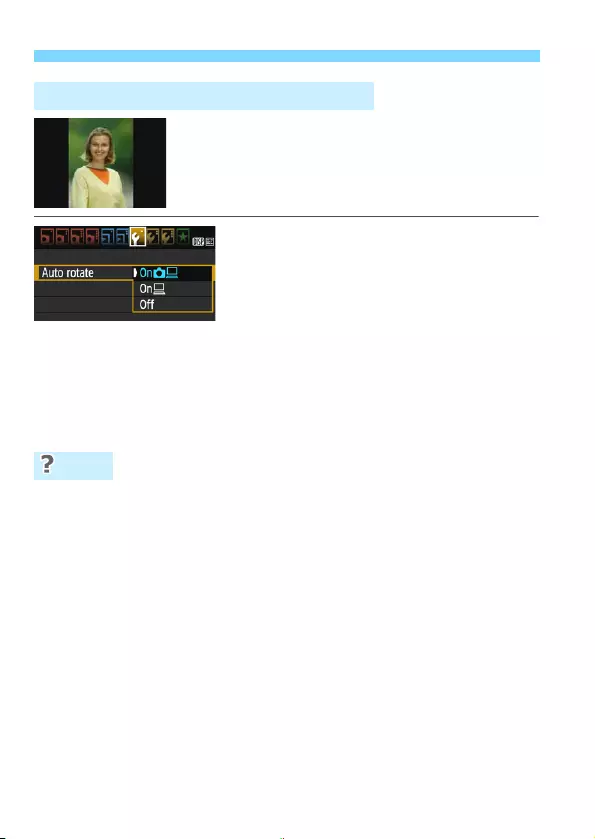
Handy Features
192
Vertical images are rotated automatically so they
are displayed vertically on the camera’s LCD
monitor and on the computer instead of
horizontally. You can change the setting for this
feature.
Under the [51] tab, select [Auto rotate],
then press <0>. The available settings
are described below. Select the desired
setting, then press <0>.
[OnzD]:
The vertical image is automatically rotated during playback
on both the camera’s LCD monitor and on the computer.
[OnD]:The vertical image is automatically rotated only on the
computer.
[Off] : The vertical image is not automatically rotated.
The vertical image is not rotated during the image review
immediately after shooting.
Press the <x> button and the image playback will display the
rotated image.
[OnzD] is set, but the image does not rotate during playback.
Auto rotate will not work with vertical images captured while [
Auto
rotate
] was set to [
Off
]. If the vertical image is taken while the camera
is pointed up or down, the image may not be rotated automatically for
playback. In such a case, see “Rotating the Image” on page 211.
On the camera’s LCD monitor, I want to rotate an image
captured when [OnD] had been set.
Set [OnzD], then play back the image. It will be rotated.
The vertical image does not rotate on the computer screen.
The software used is not compatible with image rotation. Use EOS
software instead.
3 Auto Rotation of Vertical Images
FAQ
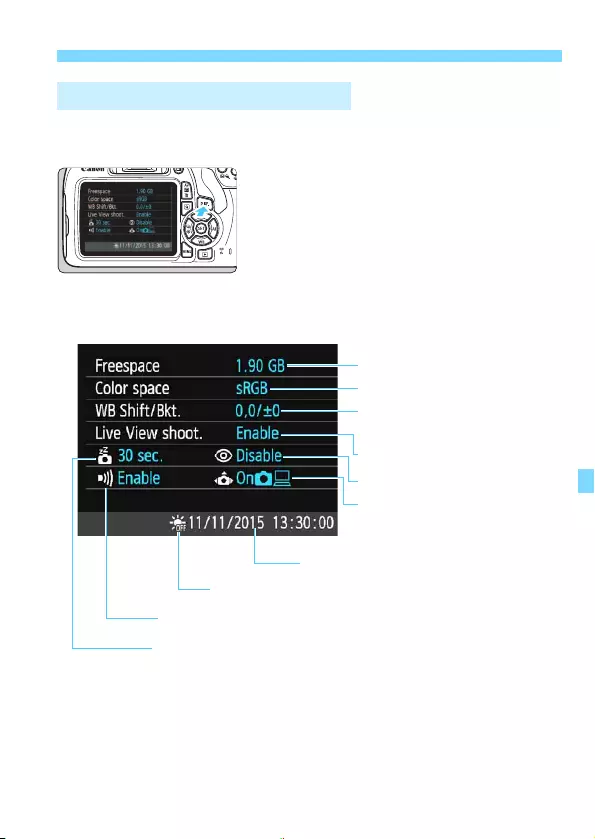
193
Handy Features
While the menu is displayed, press the <B> button to display the
camera’s major function settings.
While the menu is displayed, press
the <B> button to display the
settings.
Press the <B> button again to
return to the menu.
B Checking Camera Settings
Date/Time (p.41)
WB correction (p.135)/
WB bracketing (p.136)
Color space (p.137)
Auto rotate display (p.192)
Auto power off (p.185)
Remaining card capacity
Settings display
Red-eye reduction (p.106)
Beeper (p.184)
Live View shooting (p.139)
Daylight saving time (p.42)
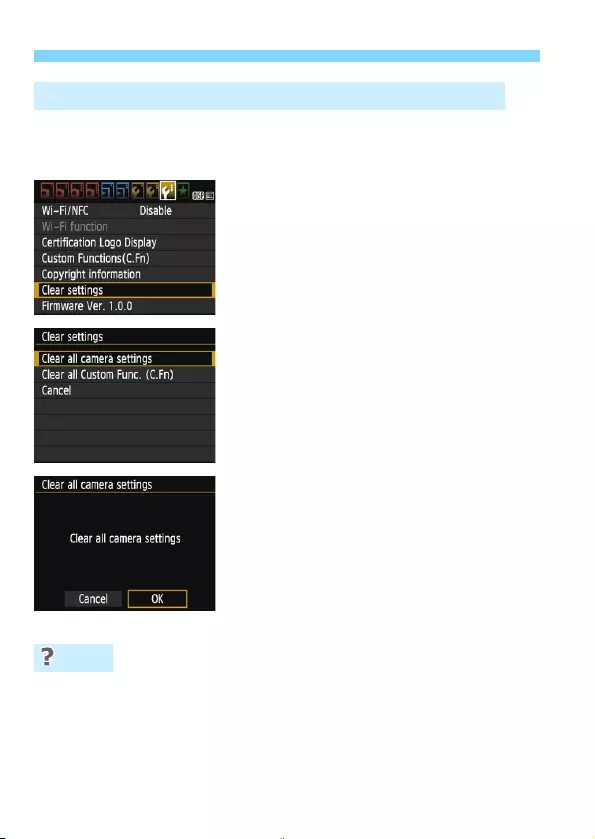
Handy Features
194
The camera’s shooting function settings and menu settings can be
reverted to their defaults. This option is available in Creative Zone
modes.
1Select [Clear settings].
Under the [53] tab, select [Clear
settings], then press <0>.
2Select [Clear all camera settings].
Select [Clear all camera settings],
then press <0>.
3Select [OK].
Select [OK], then press <0>.
Setting [Clear all camera settings]
will reset the camera to the default
settings as shown on the next pages.
Clearing all camera settings
After the procedure above, select [Clear all Custom Func. (C.Fn)]
in [53: Clear settings] to clear all the Custom Function settings
(p.258).
3 Reverting the Camera to the Default SettingsN
FAQ

195
Handy Features
Shooting Function Settings Image Recording Settings
AF operation One-Shot AF Image quality 73
AF point selection Automatic
selection
Picture Style Auto
Auto Lighting
Optimizer Standard
Drive/self-timer u (Single
shooting) Peripheral
illumination
correction
Enable /
Correction
data retained
Metering mode q (Evaluative
metering)
ISO speed AUTO (Auto) Color space sRGB
ISO Auto Maximum 3200 White balance Q (Ambience
priority)
Exposure
compensation/AEB Canceled
Custom White
Balance Canceled
Flash exposure
compensation 0 (Zero)
White balance
correction Canceled
Custom Functions Unchanged
White balance
bracketing Canceled
File numbering Continuous
Dust Delete Data Erased
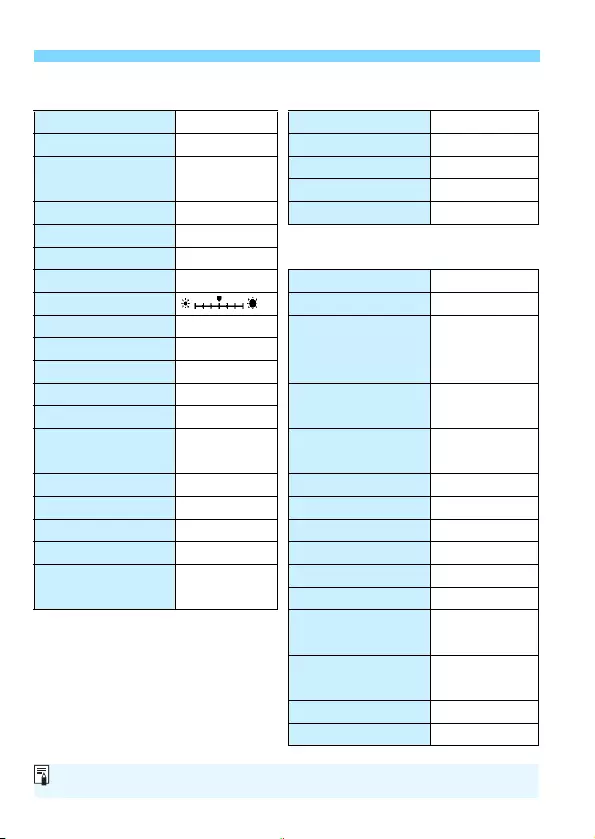
Handy Features
196
Camera Settings Live View Shooting Settings
Auto power off 30 sec. Live View shooting Enable
Beep Enable AF method
FlexiZone - Single
Release shutter
without card Enable Grid display Hide
Aspect ratio 3:2
Image review 2 sec. Metering timer 8 sec.
Histogram display Brightness
Image jump w/ 6e (10 images) Movie Shooting Settings
Auto rotate OnzD
Movie shooting mode
Auto
LCD brightness AF method
FlexiZone - Single
LCD off/on button Shutter button AF with shutter
button during
movie recording
DisableDate/Time/Zone Unchanged
Language Unchanged
Screen color 1kShutter/AE lock
button AF/AE lock
Feature guide Enable
Copyright
information Unchanged kHighlight tone
priority Disable
Eye-Fi transmission Disable
Movie recording size
1920x1080
Wi-Fi/NFC Disable Sound recording Auto
Wi-Fi function Unchanged Metering timer 8 sec.
My Menu settings Unchanged Grid display Hide
Display from My
Menu Disable Video snapshot Disable
Video system Unchanged
Exposure
compensation Canceled
Auto Lighting
Optimizer Standard
Custom White Balance
Canceled
Picture Style Auto
For Wi-Fi/NFC settings, refer to the Wireless Function Instruction Manual.
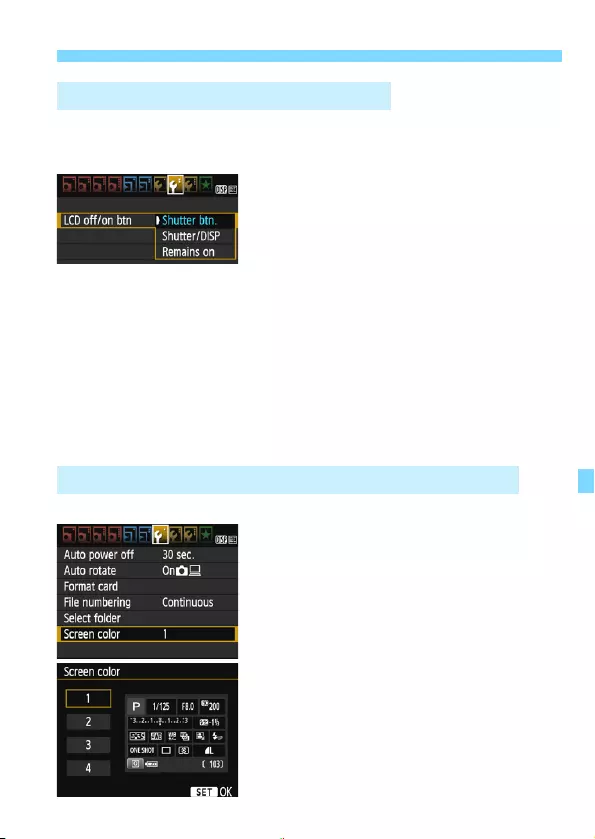
197
Handy Features
You can set the camera so that the shooting function settings display
(p.54) does not turn off and on as you press the shutter button halfway
(or press the <A> button).
Under the [52] tab, select [LCD off/on
btn], then press <0>. The available
settings are described below. Select the
option, then press <0>.
[Shutter btn.]: When you press the shutter button halfway, the
display will turn off. When you let go of the shutter
button, the display will turn on.
[Shutter/DISP]: When you press the shutter button halfway, the
display will turn off. The display will remain off even
after you let go of the shutter button. To turn on the
display, press the <B> button.
[Remains on]: Display remains on even when you press the
shutter button halfway. To turn off the display, press
the <B> button.
You can change the background color of the shooting settings screen.
Under the [51] tab, select [Screen
color], then press <0>. Select the
desired color, then press <0>.
When you exit the menu, the shooting
settings screen based in the selected
color will be displayed.
3 Turning the LCD Monitor Off/On
3 Changing the Shooting Settings Screen Color
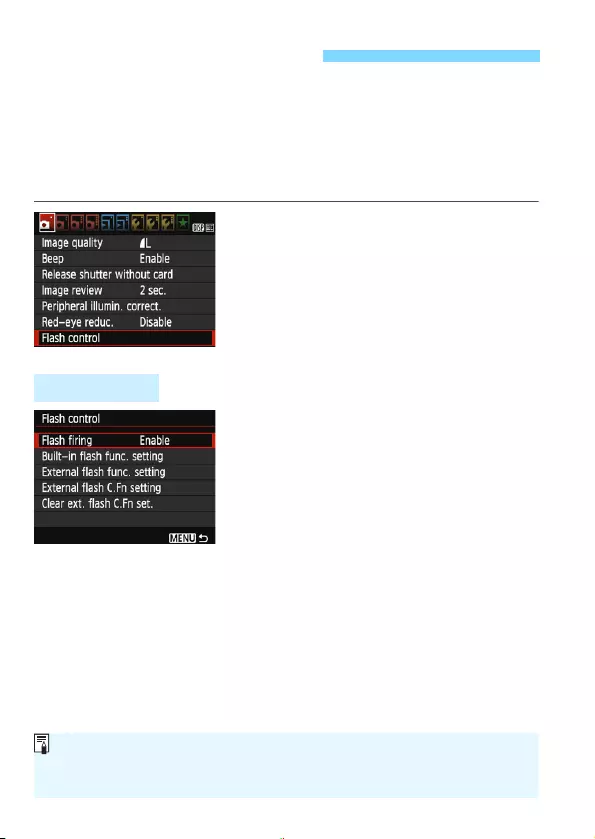
198
The built-in flash and external Speedlite settings can be set with the
camera’s menu. You can use the camera’s menu to set the external
Speedlite function settings only if an EX-series Speedlite compatible
with this function is attached.
The setting procedure is the same as when setting a camera menu
function.
Select [Flash control].
Under the [z1] tab, select [Flash
control], then press <0>.
The flash control screen will appear.
Normally, set this to [Enable].
If [Disable] is set, neither the built-
in flash nor the external Speedlite
will fire. This is useful when you want
to use only the flash’s AF-assist
beam.
3 Setting the FlashN
[Flash firing]
Even if [Flash firing] is set to [Disable], if focus is difficult to achieve in low
light, the built-in flash may still fire a series of flashes (AF-assist beam,
p.100).
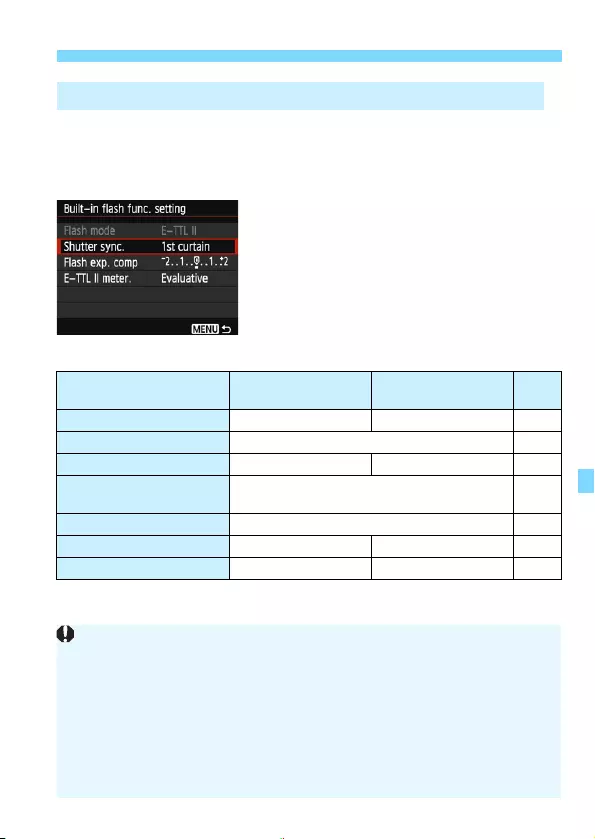
199
3 Setting the FlashN
With [Built-in flash func. setting] and [External flash func. setting],
you can set the functions in the table below. The functions displayed
under [External flash func. setting] vary depending on the Speedlite
model.
Select [Built-in flash func. setting]
or [External flash func. setting].
The flash functions will be displayed.
The highlighted functions can be
selected and set.
[Built-in flash func. setting] and [External flash func. setting] Functions
* Regarding [FEB] (Flash exposure bracketing), [Zoom], and [Wireless func.],
refer to the Speedlite’s instruction manual compatible with the function.
[Built-in flash func. setting] and [External flash func. setting]
Function [Built-in flash func.
setting]
[External flash func.
setting]Page
Flash mode E-TTL II (Fixed) k200
Shutter synchronization k200
FEB* -k-
Flash exposure
compensation k117
E-TTL II flash metering k200
Flash zoom* -k-
Wireless functions* -k-
Cautions for Radio Transmission Wireless Flash Shooting
• Radio transmission wireless flash shooting cannot be set with the
camera. Use the Speedlite to set the function.
• Set flash sync speed to 1/100 or less.
• High-speed synchronization is not possible.
• Group flash is not possible.
The camera may not be able to set some of the functions of [Flash
mode], [Zoom], and [MULTI flash], depending on the Speedlite model
used. In such a case, use the Speedlite to set the functions.

3 Setting the FlashN
200
Flash mode
When using an external Speedlite, you can select the flash mode to
suit your desired flash shooting.
[E-TTL II] is the standard mode of
EX-series Speedlites for automatic
flash shooting.
[Manual flash] enables you to set the
flash output yourself. This is for
advanced users.
Regarding other flash modes, refer to
the instruction manual of a Speedlite
compatible with the functions.
Shutter synchronization
Normally, set this to [1st curtain] so that the flash fires immediately
after the exposure starts.
If [2nd curtain] is set, the flash will fire right before the shutter
closes. When this is combined with a slow shutter speed, you can
create a trail of light such as from car headlights at night with a more
natural feel. With E-TTL II (auto flash exposure), the flash will be
fired twice in a row: once when you press the shutter button
completely and once right before the end of the exposure. Also, if
the shutter speed is 1/30 sec. or faster, first-curtain synchronization
will be applied automatically.
If an external Speedlite is attached, you can also select [High-speed
synchronization] (e). For details, refer to the Speedlite’s
instruction manual.
Flash exposure compensation
See “Flash Exposure Compensation” on page 117.
E-TTL II flash metering
For normal flash exposures, set it to [Evaluative]. [Average] is for
advanced users. As with an external Speedlite, the metering is
averaged for the entire area. Depending on the scene, flash
exposure compensation may be necessary.
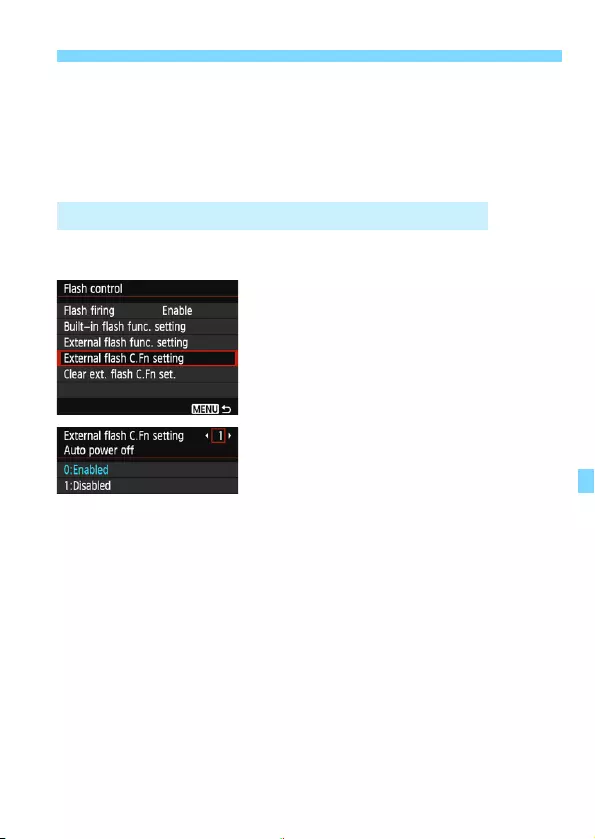
201
3 Setting the FlashN
Clear flash settings
On the [External flash func. setting] screen, press the <B>
button to display the screen to clear the flash settings. When you
select [OK], the settings for the built-in flash and external
Speedlite will be cleared.
The Custom Functions displayed under [External flash C.Fn setting]
vary depending on the Speedlite model.
1Display the Custom Function.
Select [External flash C.Fn setting],
then press <0>.
2Set the Custom Function.
Press the <Y> <Z> keys to select
the function number, then set the
function. The procedure is the same
as setting the camera’s Custom
Functions (p.258).
To clear all the Custom Function
settings, select [Clear ext. flash C.Fn
set.] in step 1.
Setting the External Speedlite Custom Functions
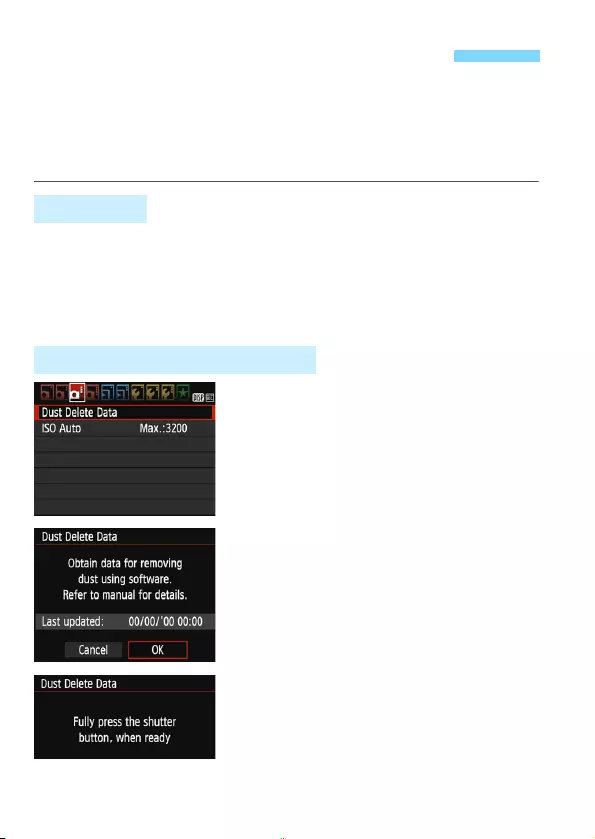
202
Dust entering the camera can adhere to the image sensor and cause
dust spots to be visible on the captured images. To erase these dust
spots, you can append the Dust Delete Data to the images. The Dust
Delete Data is used by Digital Photo Professional (EOS software,
p.314) to erase the dust spots automatically.
Prepare a solid white object such as a sheet of paper.
Set the lens focal length to 50 mm or longer.
Set the lens’s focus mode switch to <MF> and set the focus to
infinity (u). If the lens has no distance scale, rotate the camera to
face toward you and turn the focusing ring clockwise all the way.
1Select [Dust Delete Data].
Under the [z3] tab, select [Dust
Delete Data], then press <0>.
2Select [OK].
Select [OK], then press <0>.
Instructions will appear.
3 Appending Dust Delete DataN
Preparation
Obtaining the Dust Delete Data
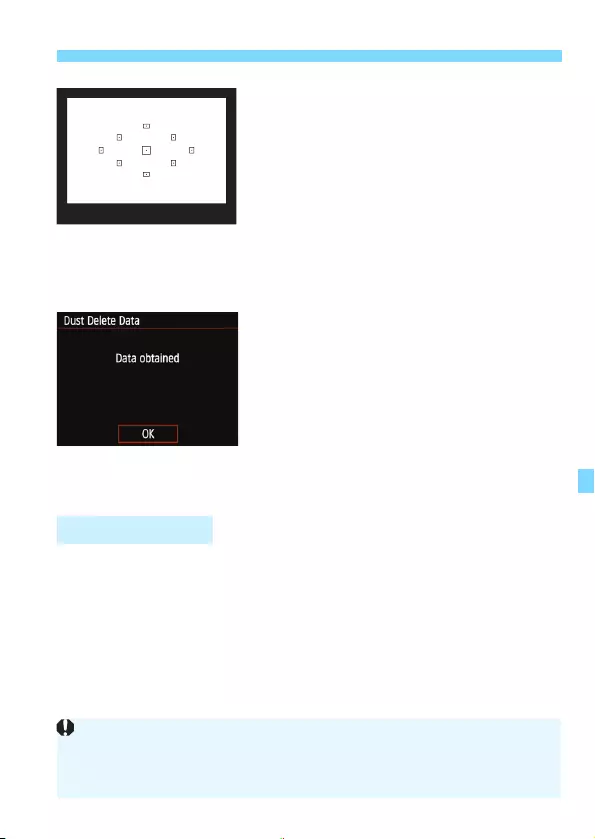
203
3 Appending Dust Delete DataN
3Shoot a solid-white object.
At a distance of 20 cm - 30 cm (0.7 ft. -
1.0 ft.), fill the viewfinder with a
patternless, solid-white object and
take a picture.
The picture will be taken in aperture-
priority AE mode at an aperture of
f/22.
Since the image will not be saved, the
data can still be obtained even if there
is no card in the camera.
When the picture is taken, the camera
will start collecting the Dust Delete
Data. When the Dust Delete Data is
obtained, a message will appear.
Select [
OK
] and the menu will reappear.
If the data is not obtained successfully,
an error message will appear. Follow
the “Preparation” procedure on the
preceding page, then select [
OK
].
Take the picture again.
After the Dust Delete Data is obtained, it is appended to all the JPEG
and RAW images captured thereafter. Before an important shoot, it is
recommended to update the Dust Delete Data by obtaining it again.
For details about using Digital Photo Professional (EOS software,
p.314) to erase dust spots, refer to the Digital Photo Professional
Instruction Manual.
The Dust Delete Data appended to the image is so small that it hardly
affects the image file size.
Dust Delete Data
Be sure to use a solid-white object such as a new sheet of white paper. If the
object has any pattern or design, it may be recognized as dust data and
affect the accuracy of the dust deletion with Digital Photo Professional (EOS
software).
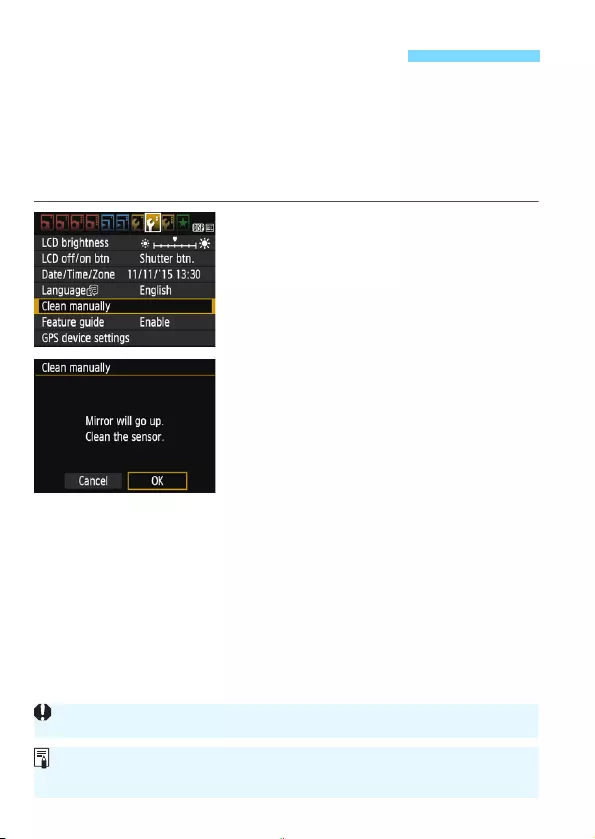
204
If dust adheres to the image sensor and dust spots appear on the
images, you can clean the image sensor yourself with a camera blower.
Before cleaning the sensor, detach the lens from the camera.
The image sensor is extremely delicate. If the sensor needs to be
cleaned directly, having it done by a Canon Service Center is
recommended.
1Select [Clean manually].
Under the [52] tab, select [Clean
manually], then press <0>.
2Select [OK].
Select [OK], then press <0>.
In a moment, the reflex mirror will lock
up and the shutter will open.
3Clean the sensor.
4End the cleaning.
Set the power switch to <2>.
3 Manual Sensor CleaningN
If you use a battery, make sure it is fully charged.
For the power source, using DC Coupler DR-E10 (sold separately) and
Compact Power Adapter CA-PS700 (sold separately) is recommended.

205
3 Manual Sensor CleaningN
While cleaning the sensor, never do any of the following. If the
power is cut off, the shutter will close and the shutter curtains and
image sensor may get damaged.
• Setting the power switch to <2>.
• Opening the card slot/battery compartment cover.
The surface of the image sensor is extremely delicate. Clean the sensor
with care.
Use a plain blower without any brush attached. A brush can scratch the
sensor.
Do not insert the blower tip inside the camera beyond the lens mount. If
the power is turned off, the shutter will close and the shutter curtains or
reflex mirror may get damaged.
Never use pressurized air or gas to clean the sensor. Pressurized air
may damage the sensor, and sprayed gas may freeze on the sensor and
scratch it.
If the battery level becomes low while cleaning the sensor, the beeper
will sound as a warning. Stop cleaning the sensor.
If a smudge that cannot be removed with a blower remains, having the
sensor cleaned by a Canon Service Center is recommended.

206
MEMO

207
8
Image Playback
This chapter explains functions related to viewing
photos and movies, with more advanced uses than in
Chapter 2 “Basic Shooting and Image Playback”. Here
you will find explanations of how to play back and erase
photos and movies with the camera and view them on a
TV set.
Images shot and saved with another device
The camera may not be able to properly display images captured
with a different camera, edited with a computer, or that have had their
file names changed.
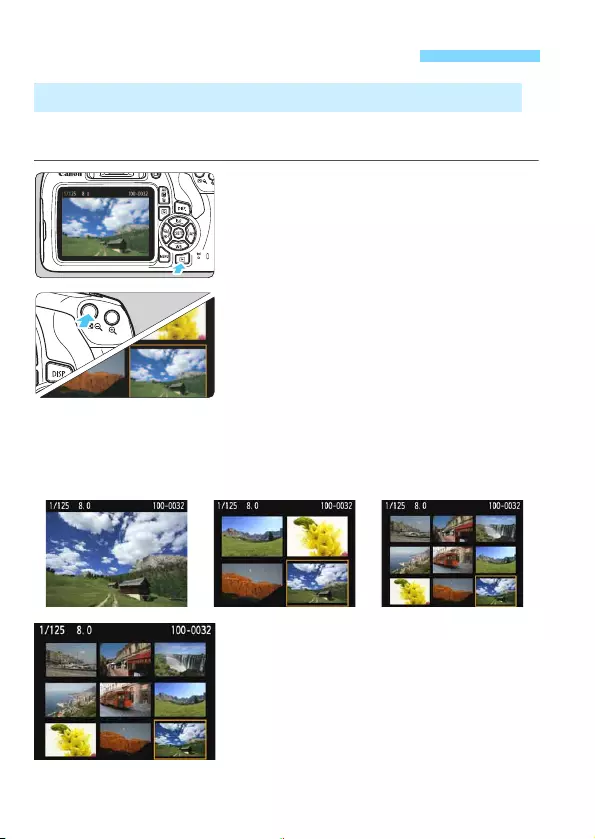
208
Search for images quickly with the index display showing four or nine
images on one screen.
1Play back the image.
When you press the <x> button, the
last image captured will be displayed.
2Switch to the index display.
Press the <Hy> button.
The 4-image index display will
appear. The selected image is
highlighted with an orange frame.
Press the <Hy> button again to
switch to the 9-image display.
Pressing the <u> button will switch
the display between nine images, four
images and one image displayed.
3Select an image.
Press the <S> cross keys to move
the orange frame to select an image.
Turning the <6> dial will display
image(s) on the next or previous
screen.
Press <0> in the index display to
display the selected image in the
single-image display.
x Searching for Images Quickly
H
Displaying Multiple Images on One Screen (Index Display)
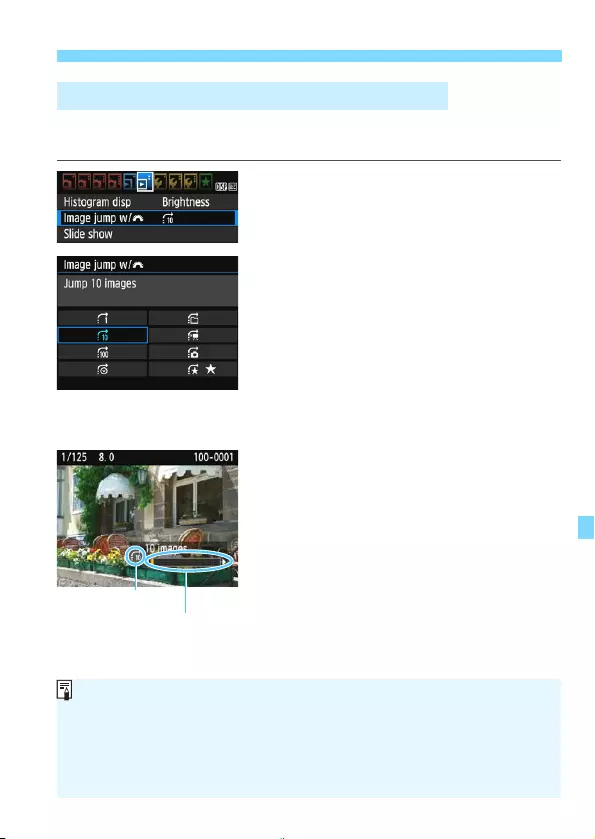
209
x Searching for Images Quickly
In the single-image display, you can turn the <6> dial to jump through
the images forward or backward according to the jump method set.
1Select [Image jump w/6].
Under the [x2] tab, select [Image
jump w/6], then press <0>.
2Select the jump method.
Press the <S> cross keys to select
the jump method, then press <0>.
d: Display images one by one
e: Jump 10 images
f: Jump 100 images
g: Display by date
h: Display by folder
i: Display movies only
j: Display stills only
k: Display by image rating (p.212)
Turn the <6> dial to select.
3Browse by jumping.
Press the <x> button to play back
images.
In the single-image display, turn the
<6> dial.
You can browse images with the
method that was set.
I Jumping through Images (Jump Display)
Playback position
Jump method
To search images by shooting date, select [Date].
To search images by folder, select [Folder].
If the card contains both movies and still photos, select [Movies] or
[Stills] to display only one or the other.
If no images match the selected [Rating], you cannot browse through the
images with the <6> dial.
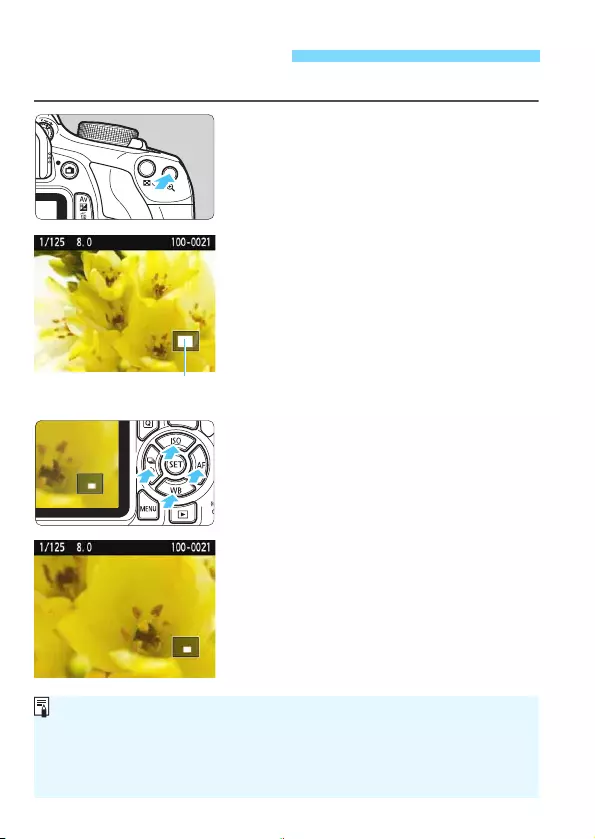
210
You can magnify a captured image by approx. 1.5x to 10x on the LCD monitor.
1Magnify the image.
Press the <u> button during image
playback.
The image will be magnified.
If you hold down the <u> button, the
image will be magnified until it
reaches the maximum magnification.
Press the <Hy> button to reduce
the magnification. If you hold down
the button, the magnification will be
reduced to the single-image display.
2Scroll around the image.
Use the <S> cross keys to scroll
around the magnified image.
To exit magnified view, press the
<x> button and the single-image
display will reappear.
u/y Magnified View
Magnified area position
In magnified view, you can turn the <6> dial to view another image at
the same magnification.
The image cannot be magnified during the image review immediately
after shooting.
A movie cannot be magnified.
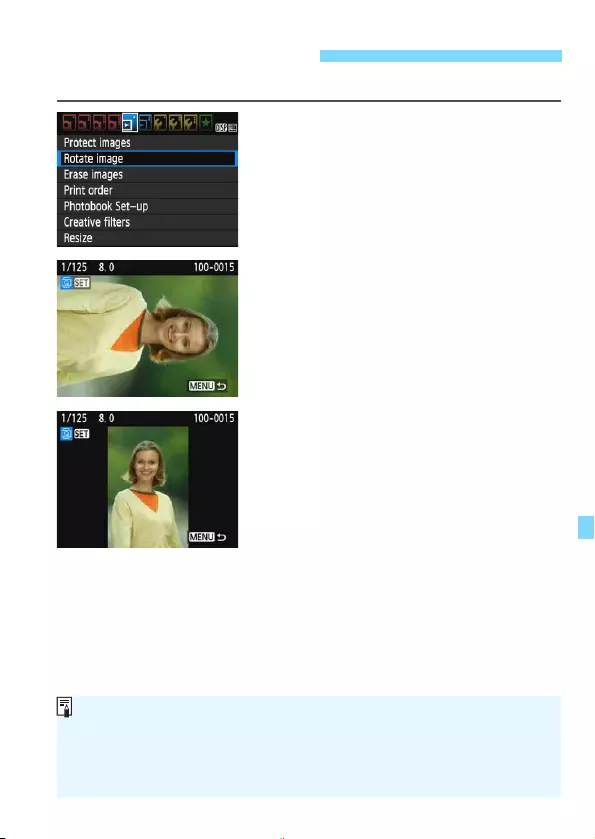
211
You can rotate the displayed image to the desired orientation.
1Select [Rotate image].
Under the [x1] tab, select [Rotate
image], then press <0>.
2Select an image.
Press the <Y> <Z> keys to select
the image to be rotated.
You can also select an image in the
index display (p.208).
3Rotate the image.
Each time you press <0>, the image
will rotate clockwise as follows:
90° 9 270° 9 0°.
To rotate another image, repeat steps
2 and 3.
To exit and return to the menu, press
the <M> button.
b Rotating the Image
If you set [51: Auto rotate] to [OnzD] (p.192) before taking vertical
shots, you need not rotate the image as described above.
If the rotated image is not displayed in the rotated orientation during
image playback, set [51: Auto rotate] to [OnzD].
A movie cannot be rotated.

212
You can rate images (still photos and movies) with one of five rating
marks: l/m/n/o/p. This function is called rating.
1Select [Rating].
Under the [x2] tab, select [Rating],
then press <0>.
2Select an image.
Press the <Y> <Z> keys to select a
still photo or movie to be rated.
By pressing the <Hy> button, you
can select images from a three-image
display. To return to the single-image
display, press the <u> button.
3Rate the image.
Press the <W> <X> keys to select a
rating.
When you select a rating for the
image, the number beside the set
rating will increase by one.
To rate another image, repeat steps 2
and 3.
To return to the menu, press the
<M> button.
3 Setting Ratings

213
3 Setting Ratings
A total of up to 999 images of a given rating can be displayed. If there are
more than 999 images with a given rating, [###] will be displayed.
Taking Advantage of Ratings
With [x2: Image jump w/6], you can display only images having the
specified rating.
With [x2: Slide show], you can play back only images having the
specified rating.
With Digital Photo Professional (EOS software, p.314), you can select
only images with a specific rating (still photos only).
Depending on the computer OS, you can see each file’s rating as part of
the file information display or in the provided image viewer (JPEG
images only).
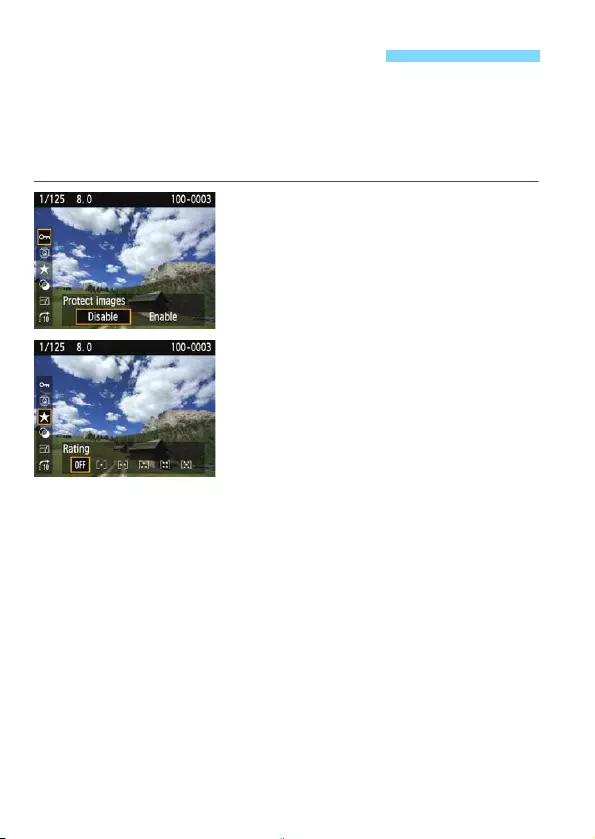
214
During playback, you can press the <Q> button to set any of the
following: [J: Protect images], [b: Rotate image], [9: Rating],
[U: Creative filters], [S: Resize (JPEG images only)], and [e: Image
jump w/6].
For movies, only the functions in bold above can be set.
1Press the <Q> button.
During image playback, press the
<Q> button.
The Quick Control options will
appear.
2Select a function and set it.
Press the <W> <X> keys to select a
function.
The name and current setting of the
selected function are displayed at the
bottom of the screen.
Set it by pressing the <Y> <Z>
keys.
For Creative filters and Resize, press
<0> and set the function. For
details, see page 236 for Creative
filters and page 239 for Resize. To
cancel, press the <M> button.
3Exit the setting.
Press the <Q> button to exit the
Quick Control.
Q Quick Control for Playback

215
Q Quick Control for Playback
To rotate an image, set [51: Auto rotate] to [OnzD]. If [51: Auto rotate]
is set to [OnD] or [Off], the [b Rotate image] setting will be recorded to
the image, but the camera will not rotate the image for display.
Pressing the <Q> button during the index display will switch to the
single-image display and the Quick Control icons will appear. Pressing
the <Q> button again will return to the index display.
For images taken with another camera, the options you can select may
be restricted.
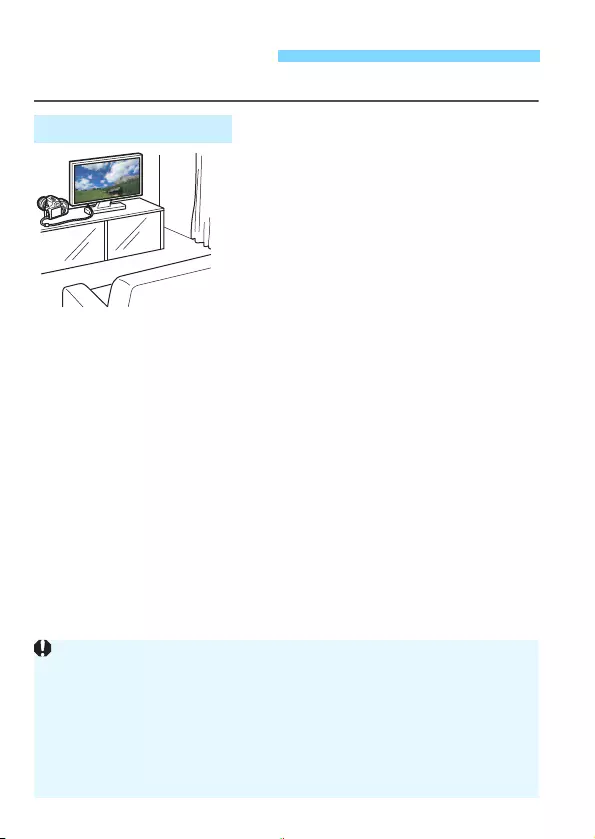
216
You can play back movies in the following three ways:
An HDMI cable (sold separately) is
necessary to connect the camera to a
TV set. Also, an HDMI terminal on a
TV set is required.
When the camera is connected to a TV
set with an HDMI cable, you can play
back movies and still photos on the TV
set.
If you have a High-Definition TV set and
connect your camera with an HDMI
cable, you can watch Full High-Definition
(Full HD: 1920x1080) and High-
Definition (HD: 1280x720) movies with
higher image quality.
k Enjoying Movies
Playback on a TV Set (p.226)
The camera does not have an audio/video OUT terminal. Therefore, the
camera cannot be connected to a TV set with an analog AV cable.
Since hard disk recorders do not have an HDMI IN terminal, the camera
cannot be connected to a hard disk recorder with an HDMI cable.
Even if the camera is connected to a hard disk recorder with a USB
cable, movies and still photos cannot be played back or saved.
If the playback device is not compatible with MOV files, the movie cannot
be played back.
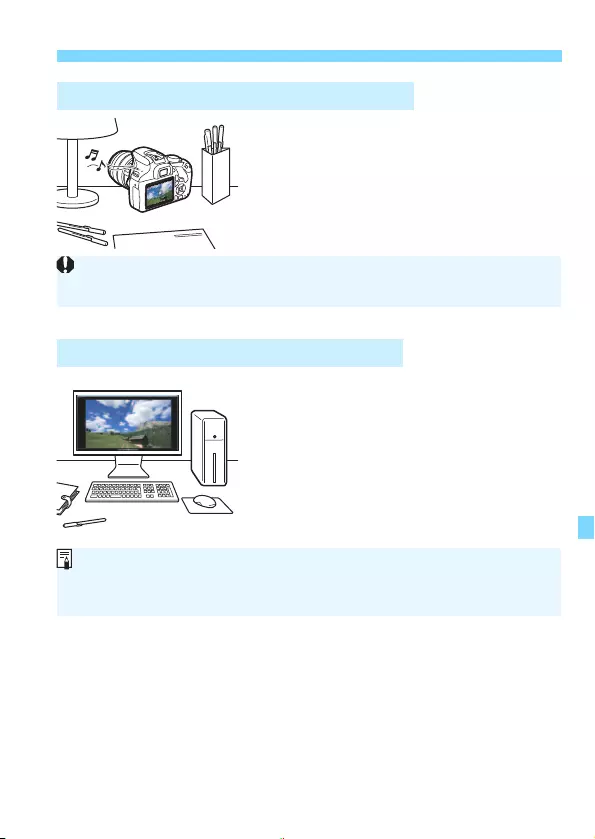
217
k Enjoying Movies
You can play back movies on the
camera’s LCD monitor. You can also edit
out the movie’s first and last scenes, and
play back the still photos and movies on
the card in an automatic slide show.
To play back or edit a movie, use pre-
installed or general-purpose software,
compatible with the movie’s recording
format.
Playback on the Camera’s LCD Monitor (p.218-225)
Playback and Editing with a Computer
A movie edited with a computer cannot be rewritten to the card or played
back with the camera.
If you want to use commercially-available software to play back or edit the
movies, be sure it is compatible with MOV-format movies. For details on
commercially-available software, contact the software manufacturer.
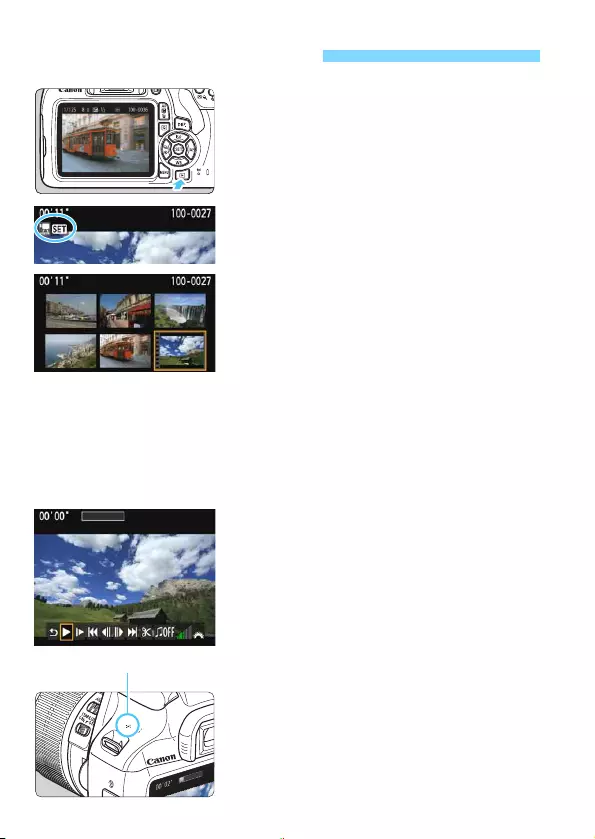
218
1Play back the image.
Press the <x> button to display an
image.
2Select a movie.
Press the <Y> <Z> keys to select a
movie.
In the single-image display, the
<1s> icon displayed on the
upper left of the screen indicates a
movie. If the movie is a video
snapshot, [ts] will be displayed.
In the index display, perforations at
the left edge of a thumbnail indicate a
movie. As movies cannot be played
back from the index display, press
<0> to switch to the single-image
display.
3In the single-image display, press
<0>.
The movie playback panel will appear
at the bottom of the screen.
4Play back the movie.
Select [7] (Play), then press <0>.
The movie will start playing back.
You can pause the movie playback by
pressing <0>.
You can adjust the built-in speaker’s
volume by turning the <6> dial
even during movie playback.
For more details on the playback
procedure, see the next page.
k Playing Back Movies
Speaker
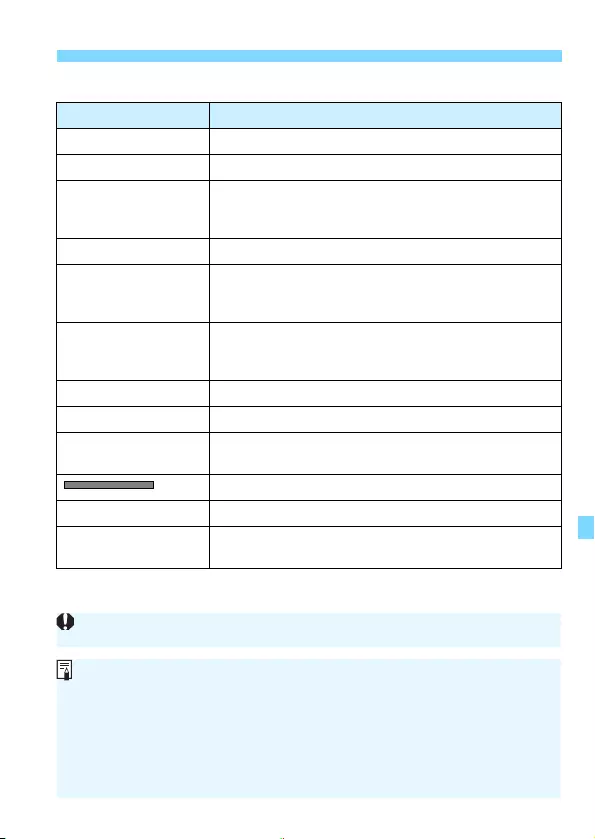
219
k Playing Back Movies
Movie Playback Panel
* When background music is set, the movie sound will not be played back.
Operation Playback Description
2 Exit Returns to the single-image display.
7 Play Pressing <0> toggles between play and stop.
8 Slow motion
Adjust the slow motion speed by pressing the <Y>
<Z> keys. The slow motion speed is indicated on the
upper right of the screen.
5 First frame Displays the movie’s first frame.
3 Previous frame
Each time you press <0>, the previous frame is
displayed. If you hold down <0>, it will rewind the
movie.
6 Next frame
Each time you press <0>, the movie will play frame-
by-frame. If you hold down <0>, it will fast forward the
movie.
4 Last frame Displays the movie’s last frame.
X Edit Displays the editing screen (p.220).
v
Background music
*Plays back a movie with the selected background music
(p.225).
Playback position
mm' ss" Playback time (minutes:seconds)
9 Volume Turn the <6> dial to adjust the volume of the built-in
speaker (p.218).
The camera may not be able to play back movies shot with another camera.
With a fully-charged Battery Pack LP-E10, the continuous playback time
at room temperature (23°C / 73°F) will be as follows: Approx. 2 hr. 20 min.
During the single-image display, you can press the <B> button to
change the display format (p.233).
If you connect the camera to a TV set (p.226) to play back a movie,
adjust the sound volume with the TV set. (Turning the <6> dial will not
change the sound volume.)
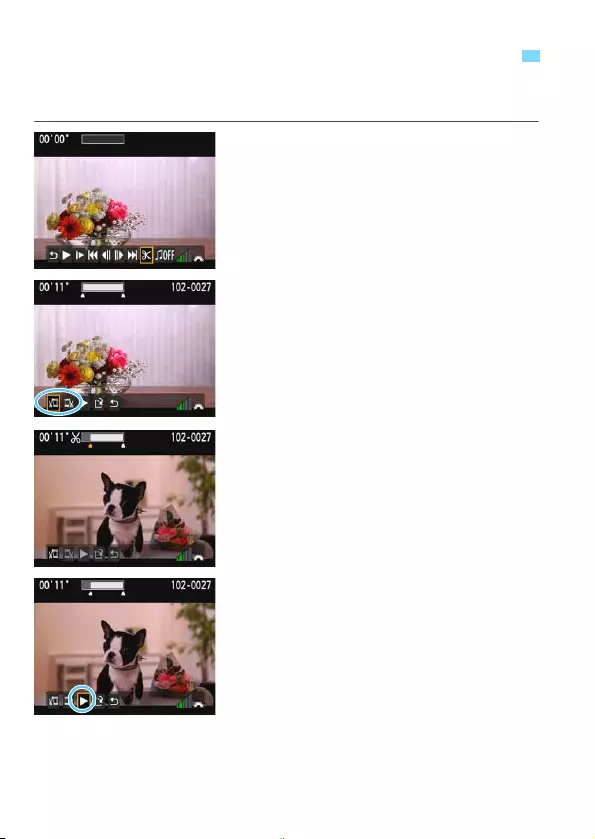
220
You can edit out the first and last scenes of a movie in approx. 1-sec.
increments.
1On the movie playback screen,
select [X].
The editing screen will be displayed.
2Specify the part to be edited out.
Select either [U] (Cut beginning) or
[V] (Cut end), then press <0>.
Press the <Y> <Z> keys to see the
previous or next frames. Holding
down the key will fast forward or fast
rewind the frames.
After deciding which part to edit out,
press <0>. The portion highlighted
in white on the top is what will remain.
3Check the edited movie.
Select [7] and press <0> to play
back the edited movie.
To change the editing, go back to step
2.
To cancel the editing, select [2],
then press <0>. Select [OK] on the
confirmation dialog, then press <0>.
X Editing a Movie’s First and Last Scenes

221
X Editing a Movie’s First and Last Scenes
4Save the edited movie.
Select [W], then press <0>.
The save screen will appear.
To save it as a new movie, select
[New file]. To save it and overwrite
the original movie file, select
[Overwrite], then press <0>.
On the confirmation dialog, select
[OK], then press <0> to save the
edited movie and return to the movie
playback screen.
Since the editing is performed in approx. 1-sec. increments (position
indicated by [Z] on the top of the screen), the actual position where the
movie is edited may differ from the position you specified.
If the card does not have enough free space, [New file] will not be
available.
When the battery level is low, movie editing is not possible. Use a fully-
charged battery.
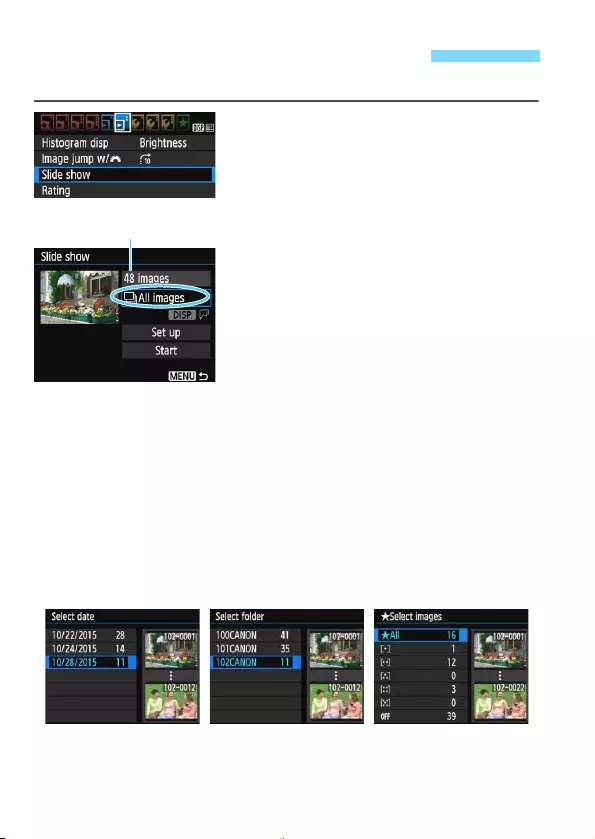
222
You can play back the images on the card as an automatic slide show.
1Select [Slide show].
Under the [x2] tab, select [Slide
show], then press <0>.
2Select the images to be played
back.
Press the <W> <X> keys to select
the desired option, then press <0>.
All images/Movies/Stills
Press the <W> <X> keys to select
one of the following: [jAll images]
[kMovies] [zStills]. Then press
<0>.
Date/Folder/Rating
Press the <W> <X> keys to select
one of the following: [iDate]
[nFolder] [9Rating].
When <zH> is highlighted,
press the <B> button.
Press the <W> <X> keys to select an
option, then press <0>.
3 Slide Show (Auto Playback)
Number of images to be
played back
[Date][Folder][Rating]
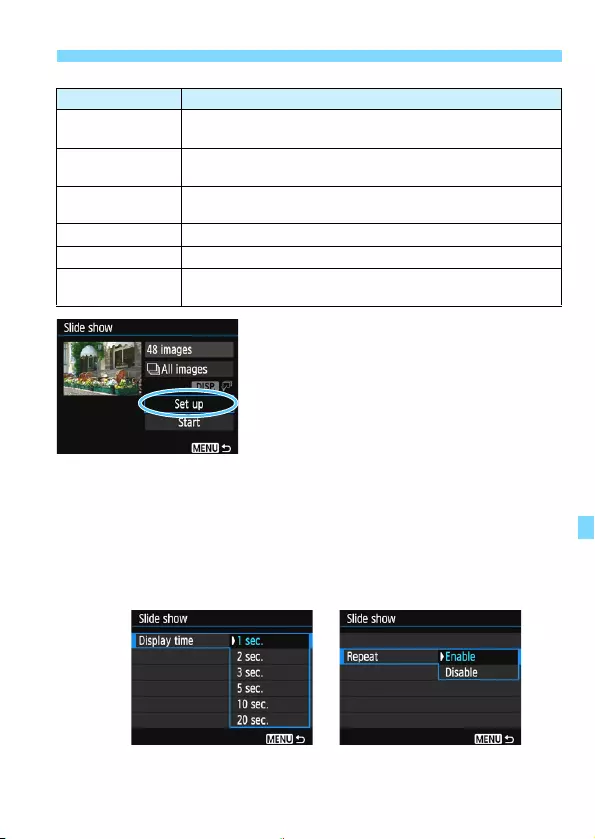
223
3 Slide Show (Auto Playback)
3Configure [Set up] as desired.
Press the <W> <X> keys to select
[Set up], then press <0>.
Set the [Display time], [Repeat]
(repeated playback), [Transition
effect] (effect when changing
images), and [Background music]
for the still photos.
The background music selection
procedure is explained on page 225.
After selecting the settings, press the
<M> button.
Item Playback Description
jAll images All the still photos and movies on the card will be played
back.
iDate Still photos and movies taken on the selected shooting date
will be played back.
nFolder Still photos and movies in the selected folder will be played
back.
kMovies Only the movies on the card will be played back.
zStills Only the still photos on the card will be played back.
9Rating Only the still photos and movies with the selected rating will
be played back.
[Display time][Repeat]
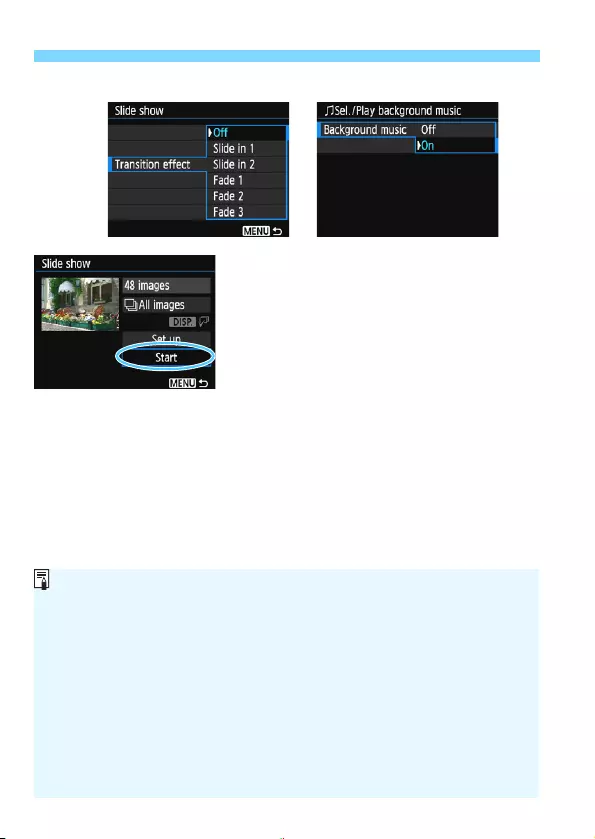
3 Slide Show (Auto Playback)
224
4Start the slide show.
Press the <W><X> keys to select
[Start], then press <0>.
After [Loading image...] is displayed,
the slide show will start.
5Exit the slide show.
To exit the slide show and return to
the setting screen, press the <M>
button.
[Transition effect][Background music]
To pause the slide show, press <0>. During pause, [G] will be displayed
on the upper left of the image. Press <0> again to resume the slide
show.
During auto playback, you can press the <B> button to change the
still photo display format (p.83).
During movie playback, you can adjust the sound volume by turning the
<6> dial.
During auto playback or pause, you can press the <Y> <Z> keys to
view another image.
During auto playback, auto power off will not take effect.
The display time may vary depending on the image.
To view the slide show on a TV set, see page 226.
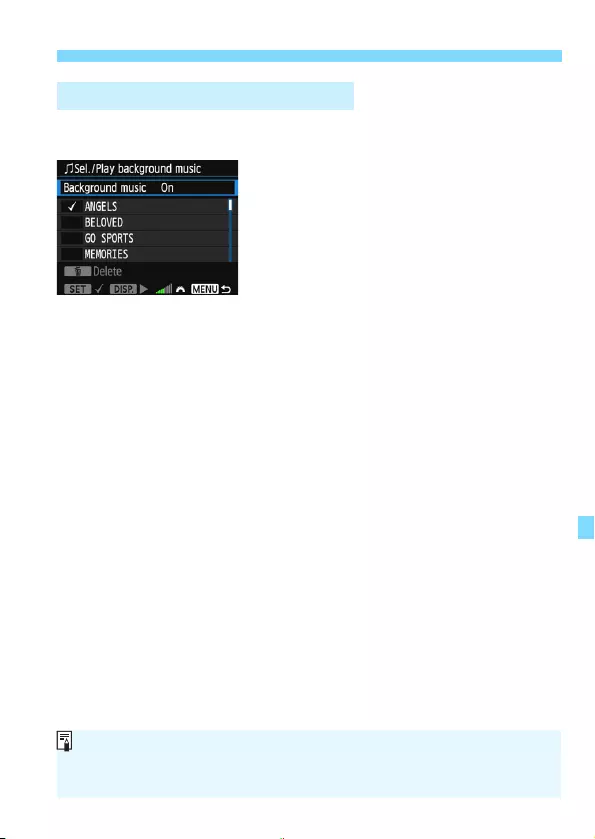
225
3 Slide Show (Auto Playback)
After you use EOS Utility (EOS software) to copy background music to
the card, you can play background music together with the slide show.
1Select [Background music].
Set [Background music] to [On],
then press <0>.
If the card has no background music,
you cannot perform step 2.
2Select the background music.
Press the <W> <X> keys to select
the desired background music, then
press <0>. You can also select
multiple background music tracks.
3Play the background music.
To listen to a sample of the
background music, press the <B>
button.
Press the <W> <X> keys to play
another background music track. To
stop listening to the background
music, press the <B> button
again.
Adjust the sound volume by turning
the <6> dial.
To delete a background music track,
press the <W> <X> keys and select
the track, then press the <L> button.
Selecting the Background Music
At the time of purchase, the camera does not have background music. The
procedure to copy background music to a card is explained in the EOS
Utility Instruction Manual.
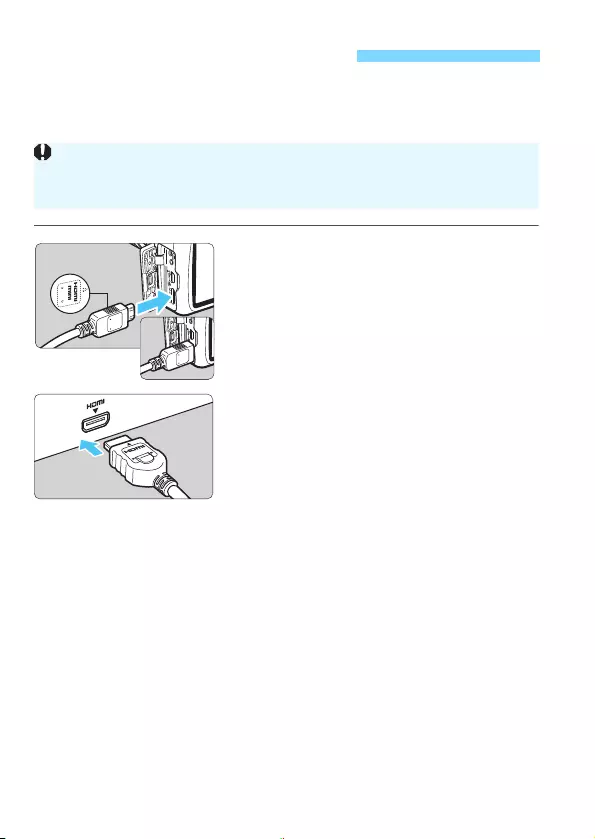
226
You can play back still photos and movies on a TV set. An HDMI cable
(sold separately) is necessary to connect the camera to a TV set.
Also, an HDMI terminal on a TV set is required.
1Connect the HDMI cable to the
camera.
With the plug’s <dHDMI MINI> logo
facing the front of the camera, insert it
into the <D> terminal.
2Connect the HDMI cable to the TV
set.
Connect the HDMI cable to the TV
set’s HDMI IN port.
3Turn on the TV set and switch the
TV set’s video input to select the
connected port.
4Set the camera’s power switch to
<1>.
Viewing Images on a TV Set
If [53: Wi-Fi/NFC] is set to [Enable], the camera cannot be connected to a
TV set. Set [Wi-Fi/NFC] to [Disable], then reconnect the camera to the TV
set with an HDMI cable.
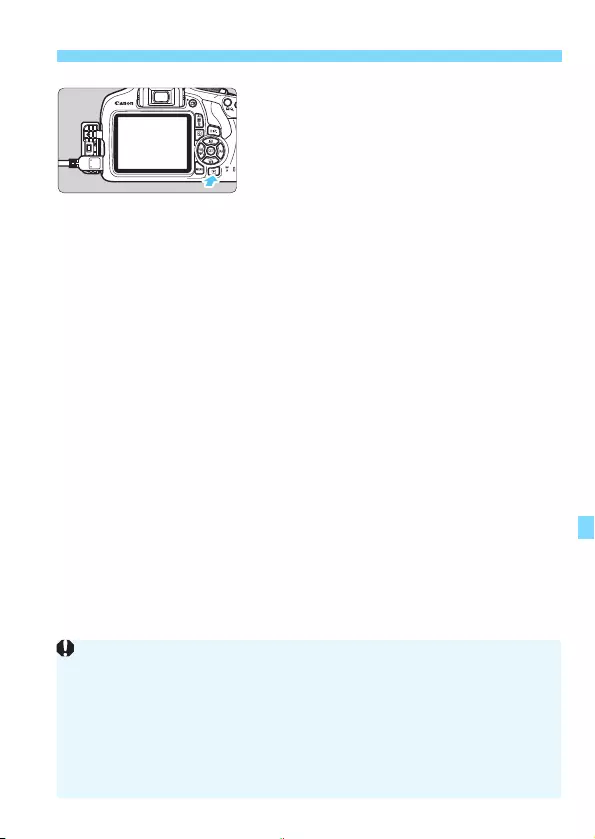
227
Viewing Images on a TV Set
5Press the <x> button.
The image will appear on the TV
screen. (Nothing will be displayed on
the camera’s LCD monitor.)
The images will automatically be
displayed at the optimum resolution
of the TV set.
By pressing the <B> button, you
can change the display format.
To play back movies, see page 218.
Adjust movie sound volume with the TV set. The sound volume cannot
be adjusted with the camera.
Before connecting or disconnecting the cable between the camera and
TV set, turn off the camera and TV set.
Depending on the TV set, part of the image displayed may be cut off.
Do not connect any other device’s output to the camera’s <D>
terminal. Doing so may cause a malfunction.
Certain TV sets may not be able to play back the captured images.
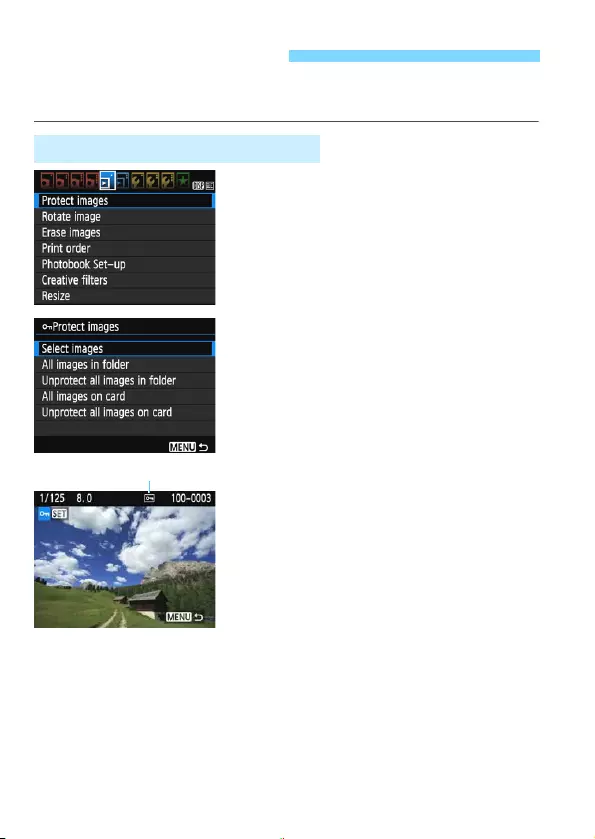
228
You can set protections to prevent the precious images from being
erased accidentally.
1Select [Protect images].
Under the [x1] tab, select [Protect
images], then press <0>.
The protect setting screen will
appear.
2Select [Select images].
Select [Select images], then press
<0>.
An image will be displayed.
3Protect the image.
Press the <Y> <Z> keys to select
the image to be protected, then press
<0>.
When an image is protected, the
<K> icon will appear on the top of
the screen.
To cancel the image protection, press
<0> again. The <K> icon will
disappear.
To protect another image, repeat step
3.
To return to the menu, press the
<M> button.
K Protecting Images
3 Protecting a Single Image
Image protect icon
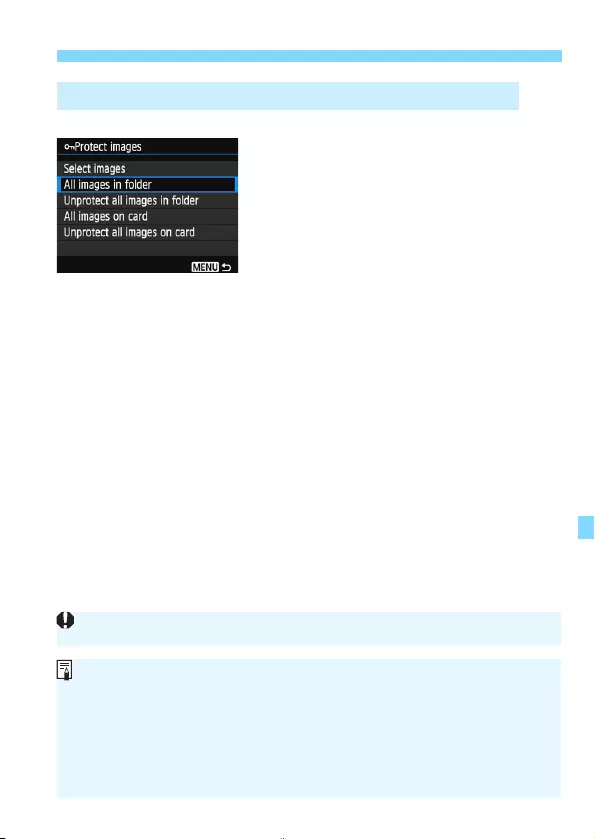
229
K Protecting Images
You can protect all the images in a folder or on a card at one time.
When you select [All images in folder]
or [All images on card] in [x1: Protect
images], all the images in the folder or
on the card will be protected.
To cancel the image protection, select
[Unprotect all images in folder] or
[Unprotect all images on card].
3 Protecting All Images in a Folder or on a Card
If you format the card (p.52), the protected images will also be erased.
Movies can also be protected.
Once an image is protected, it cannot be erased by the camera’s erase
function. To erase a protected image, you must first cancel the
protection.
If you erase all the images (p.231), only the protected images will
remain. This is convenient when you want to erase unnecessary images
all at once.
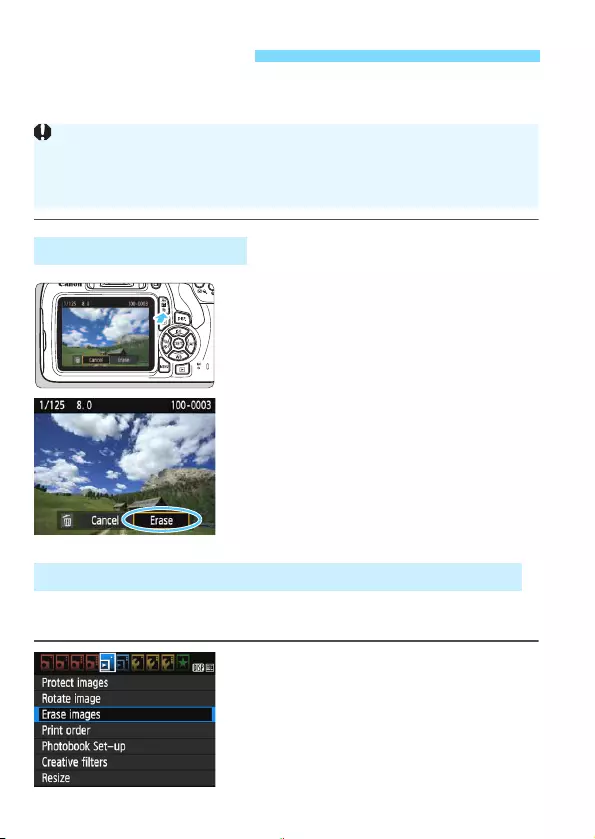
230
You can either select and erase unnecessary images one by one or
erase them in one batch. Protected images (p.228) will not be erased.
1Play back the image to be erased.
2Press the <L> button.
The Erase menu will appear.
3Erase the image.
Select [Erase], then press <0>. The
image displayed will be erased.
By adding checkmarks [X] to the images to be erased, you can erase
multiple images at once.
1Select [Erase images].
Under the [x1] tab, select [Erase
images], then press <0>.
L Erasing Images
Erasing a Single Image
Once an image is erased, it cannot be recovered. Make sure you no
longer need the image before erasing it. To prevent important images
from being erased accidentally, protect them. Erasing a 1+73
image will erase both the RAW and JPEG images.
3 Checkmarking [X] Images to Be Erased in a Batch
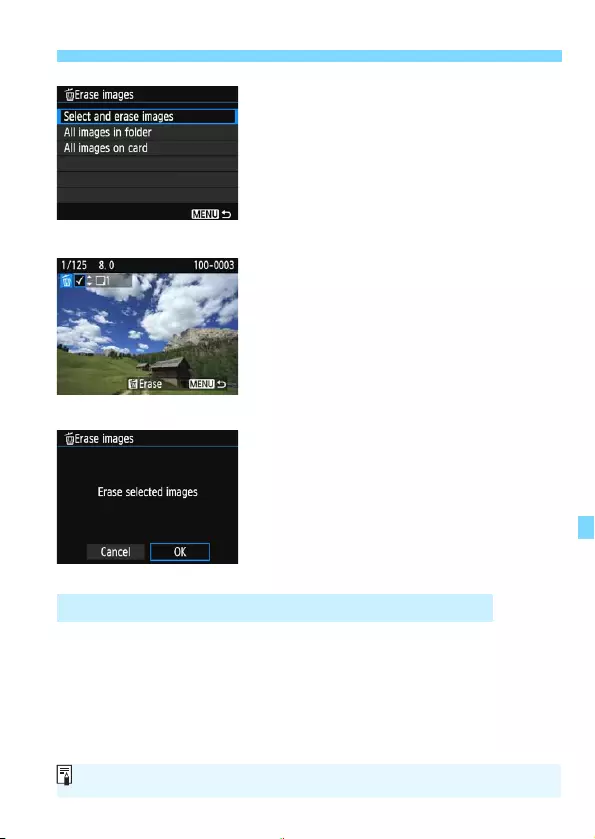
231
L Erasing Images
2Select [Select and erase images].
Select [Select and erase images],
then press <0>.
An image will be displayed.
To display the three-image display,
press the <Hy> button. To return to
the single-image display, press the
<u> button.
3Select the images to be erased.
Press the <Y> <Z> keys to select
the image to be erased, then press
the <W> <X> keys.
A checkmark [X] will be displayed on
the upper left of the screen.
To select another image to be erased,
repeat step 3.
4Erase the image.
Press the <L> button.
Select [OK], then press <0>.
The selected images will be erased.
You can erase all the images in a folder or on a card at one time. When
[x1: Erase images] is set to [All images in folder] or [All images on
card], all the images in the folder or on the card will be erased.
3 Erasing All Images in a Folder or on a Card
To erase all images including protected images, format the card (p.52).
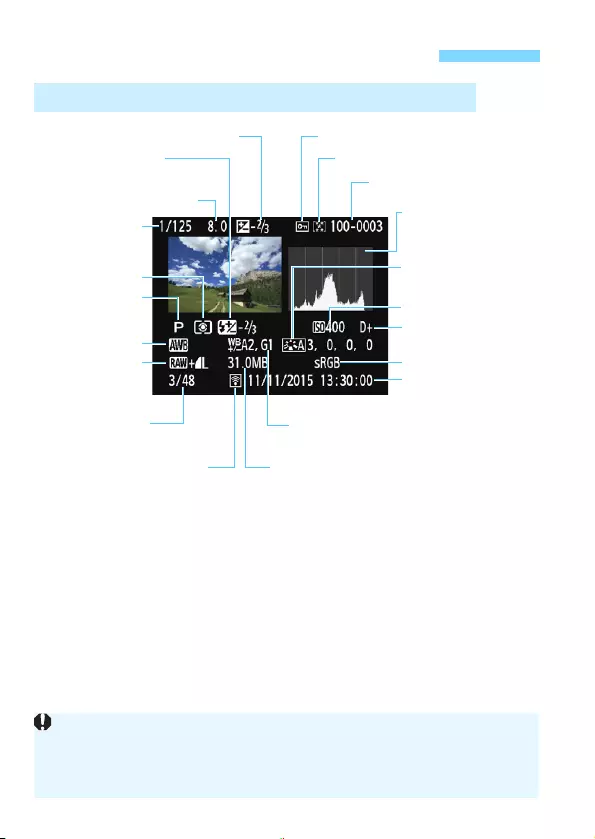
232
*With 1+73 images, the 1 file size is displayed.
* If a Creative filter or Resize has been applied to the image, the <1+> icon will
change to <u>.
* Images taken with flash without any flash exposure compensation are marked
with the <0> icon. Images taken with flash exposure compensation are marked
with the <y> icon.
B Shooting Information Display
Sample Still Photo Taken in a Creative Zone Mode
Flash exposure
compensation amount
Metering mode
Shooting mode
Highlight tone priority
Shooting date and time
White balance correction
Histogram
(Brightness/RGB)
Color space
White balance
Picture Style/Settings
File size
Image-recording
quality
Playback number/
Total images recorded
Folder number - File number
Rating
Aperture
Shutter speed
Protect imagesExposure compensation amount
ISO speed
Eye-Fi transfer
If the image was taken by another camera, certain shooting information
may not be displayed.
It may not be possible to play back images taken with this camera on
other cameras.
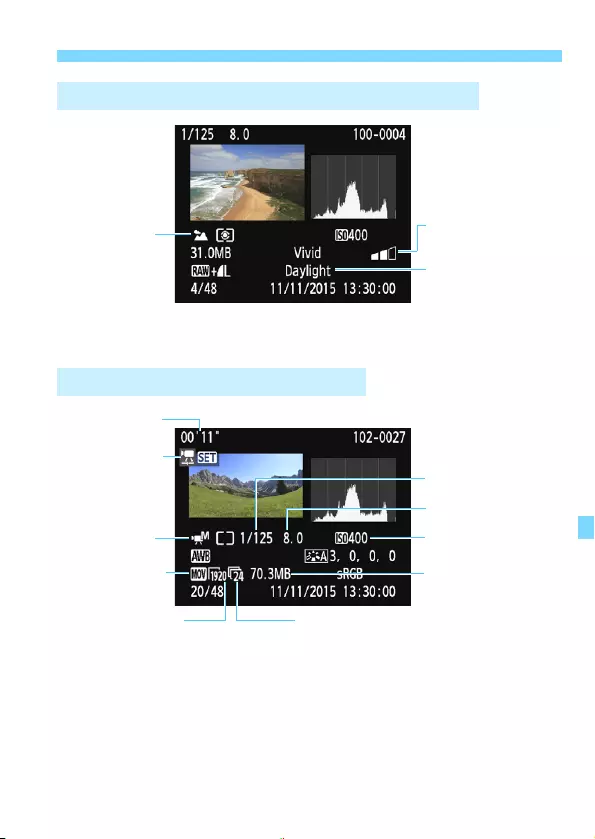
233
B Shooting Information Display
* With images taken in a Basic Zone mode, the information displayed will differ
depending on the shooting mode.
* If manual exposure is used, the shutter speed, aperture, and ISO speed (when
set manually) will be displayed.
*The <t> icon will be displayed for video snapshots.
Sample Still Photo Taken in a Basic Zone Mode
Sample Movie Information Display
Ambience and
ambience effects
Lighting or scene
Shooting mode
Movie shooting
mode
Movie file size
Recording format
Frame rateMovie recording size
Shooting duration
Movie/Playback
Shutter speed
Aperture
ISO speed
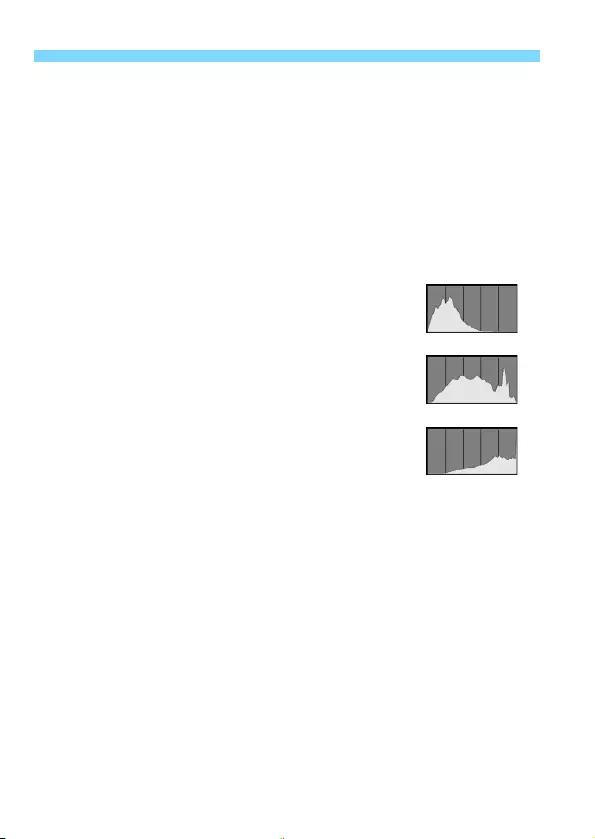
B Shooting Information Display
234
Highlight Alert
When the shooting information is displayed, any overexposed areas of the
image will blink. To obtain more image detail in the overexposed, blinking
areas, set the exposure compensation to a negative amount and shoot again.
Histogram
The brightness histogram shows the exposure level distribution and overall
brightness. The RGB histogram is for checking the color saturation and
gradation. The display can be switched with [
x2: Histogram disp
].
[Brightness] Display
This histogram is a graph showing the distribution of
the image’s brightness level. The horizontal axis
indicates the brightness level (darker on the left and
brighter on the right), while the vertical axis indicates
how many pixels exist for each brightness level. The
more pixels there are toward the left, the darker the
image. The more pixels there are toward the right,
the brighter the image. If there are too many pixels
on the left, the shadow detail will be lost. If there are
too many pixels on the right, the highlight detail will
be lost. The gradation in-between will be reproduced.
By checking the image and its brightness histogram,
you can see the exposure level inclination and the overall gradation.
[RGB] Display
This histogram is a graph showing the distribution of each primary
color’s brightness level in the image (RGB or red, green, and blue).
The horizontal axis indicates the color’s brightness level (darker on
the left and brighter on the right), while the vertical axis indicates how
many pixels exist for each color brightness level. The more pixels
there are toward the left, the darker and less prominent the color. The
more pixels there are toward the right, the brighter and denser the
color. If there are too many pixels on the left, the respective color
information will be lacking. If there are too many pixels on the right,
the color will be too saturated with no gradation. By checking the
image’s RGB histogram, you can see the color’s saturation and
gradation condition, as well as white balance inclination.
Sample Histograms
Dark image
Normal brightness
Bright image

235
9
Post-Processing
Images
After taking a picture, you can apply a Creative filter or
resize the JPEG image (reduce the number of pixels).
The camera may not be able to process images taken with
another camera.
Post-processing images as described in this chapter is not
possible while the camera is connected to a computer via the
interface cable.

236
You can apply the following Creative filters to an image and save it as a
new image: Grainy B/W, Soft focus, Fish-eye effect, Toy camera effect,
and Miniature effect.
1Select [Creative filters].
Under the [x1] tab, select [Creative
filters], then press <0>.
An image will be displayed.
2Select an image.
Select the image you want to apply a
filter to.
By pressing the <Hy> button, you
can switch to the index display and
select an image.
3Select a filter.
When you press <0>, the types of
Creative filters will be displayed
(p.238).
Press the <Y> <Z> keys to select a
filter, then press <0>.
The image will be displayed with the
effects of the filter applied.
4Adjust the filter effect.
Press the <Y> <Z> keys to adjust
the filter effect, then press <0>.
For the Miniature effect, press the
<W> <X> keys to move the white
frame to where you want the image to
look sharp, then press <0>.
U Applying Creative Filters

237
U Applying Creative Filters
5Save the image.
Select [OK] to save the image.
Check the destination folder and
image file number, then select [OK].
To apply a filter to another image,
repeat steps 2 to 5.
To return to the menu, press the
<M> button.
When shooting 1+73 or 1 image, the filter effect will be applied to
the 1 image and the image will be saved as a JPEG image.
If an aspect ratio was set for a 1 image and the filter effect is applied
to it, the image will be saved in the aspect ratio that is set.
Dust Delete Data (p.202) will not be appended to images with Fish-eye
effect applied.

U Applying Creative Filters
238
V Grainy B/W
Creates a grainy black-and-white photo. You can change the black-
and-white effect by adjusting the contrast.
W Soft focus
Gives the image a soft look. You can change the degree of softness
by adjusting the blur.
X Fish-eye effect
Gives the effect of a fish-eye lens. The image will have a barrel-type
distortion.
Depending on the level of this filter effect, the area trimmed along
the periphery of the image changes. Also, since this filter effect will
magnify the image center, the apparent resolution at the center may
degrade depending on the number of recorded pixels. Set the filter
effect in step 4 while checking the resulting image.
Y Toy camera effect
Darkens the photo’s corners and applies a color tone that makes it
look as if it was shot by a toy camera. You can change the color cast
by adjusting the color tone.
Z Miniature effect
Creates a diorama effect. You can change where the image looks
sharp. In step 4 on page 236, if you press the <B> button, you
can switch between the white frame’s vertical and horizontal
orientations.
Creative Filter Characteristics
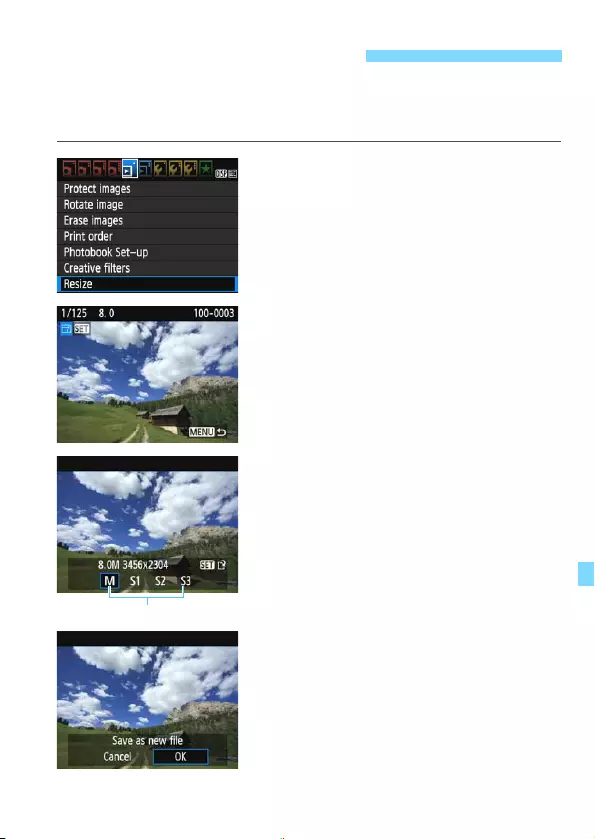
239
You can resize a JPEG image to make the pixel count lower and save it
as a new image. Resizing an image is possible only with JPEG 3/4/a/
b images. JPEG c and RAW images cannot be resized.
1Select [Resize].
Under the [x1] tab, select [Resize],
then press <0>.
An image will be displayed.
2Select an image.
Select the image you want to resize.
By pressing the <Hy> button, you
can switch to the index display and
select an image.
3Select the desired image size.
Press <0> to display the image
sizes.
Press the <Y> <Z> keys to select
the desired image size, then press
<0>.
4Save the image.
Select [OK] to save the resized
image.
Check the destination folder and
image file number, then select [OK].
To resize another image, repeat steps
2 to 4.
To return to the menu, press the
<M> button.
S Resizing JPEG Images
Target sizes
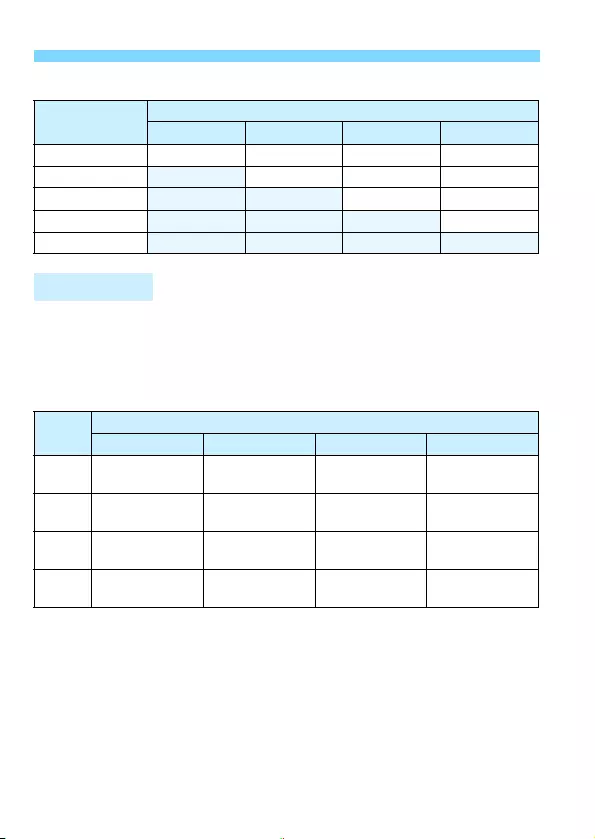
S Resizing JPEG Images
240
Resize Options by Original Image Size
The image sizes displayed in step 3 on the preceding page, such as
[***M ****x****], have a 3:2 aspect ratio. The image sizes by aspect
ratios are shown in the table below.
The items marked with an asterisk do not exactly match the indicated
aspect ratio. The image will be cropped slightly.
Original Image
Size
Available Resize Settings
4a b c
3kkkk
4kkk
akk
bk
c
Image Sizes
Image
Quality
Aspect Ratio and Pixel Count (Approx.)
3:2 4:3 16:9 1:1
43456x2304
(8.0 megapixels)
3072x2304
(7.0 megapixels)
3456x1944
(6.7 megapixels)
2304x2304
(5.3 megapixels)
a2592x1728
(4.5 megapixels)
2304x1728
(4.0 megapixels)
2592x1456*
(3.8 megapixels)
1728x1728
(3.0 megapixels)
b1920x1280
(2.5 megapixels)
1696x1280*
(2.2 megapixels)
1920x1080
(2.1 megapixels)
1280x1280
(1.6 megapixels)
c720x480
(350,000 pixels)
640x480
(310,000 pixels)
720x400*
(290,000 pixels)
480x480
(230,000 pixels)

241
10
Printing Images
Printing (p.242)
You can connect the camera directly to a printer and print
out the images on the card. The camera is compliant with
“wPictBridge”, which is the standard for direct printing.
Digital Print Order Format (DPOF) (p.251)
DPOF (Digital Print Order Format) enables you to print
images recorded on the card according to your printing
instructions such as the image selection, quantity to print,
etc. You can print multiple images in one batch or give the
print order to a photofinisher.
Specifying Images for a Photobook (p.255)
You can specify images on the card for printing in a
photobook.
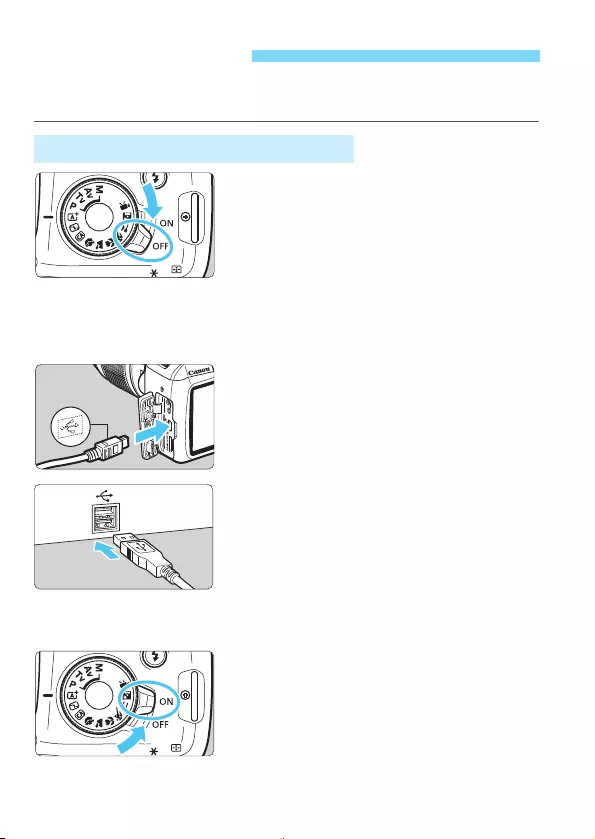
242
The direct printing procedure can be performed entirely with the
camera while looking at the setting screens on camera’s LCD monitor.
1Set the camera’s power switch to
<2>.
2Set up the printer.
For details, refer to the printer’s
instruction manual.
3Connect the camera to the
printer.
Use the interface cable provided with
the camera.
Connect the cable to the camera’s
digital terminal with the cable plug’s
<D> icon facing the front of the
camera.
To connect to the printer, refer to the
printer’s instruction manual.
4Turn on the printer.
5Set the camera’s power switch to
<1>.
Some printers may make a beeping
sound.
Preparing to Print
Connecting the Camera to a Printer

243
Preparing to Print
6Play back the image.
Press the <x> button.
The image will appear with the <w>
icon on the upper left of the screen to
indicate that the camera is connected
to a printer.
Before using the printer, make sure it has a PictBridge connection port.
Movies cannot be printed.
The camera cannot be used with printers compatible only with CP Direct
or Bubble Jet Direct.
Do not use any interface cable other than the one provided.
If there is a long beeping sound in step 5, it indicates a problem with the
printer. Resolve the problem displayed in the error message (p.250).
If [53: Wi-Fi/NFC] is set to [Enable], the camera cannot be connected to
a printer. Set [Wi-Fi/NFC] to [Disable], then reconnect the camera to a
printer with an interface cable.
You can also print RAW images taken with this camera.
When you use a battery to power the camera, make sure it is fully
charged. With a fully-charged battery, you can print for approx. 2 hr. 40
min.
Before disconnecting the cable, first turn off the camera and printer. Hold
the plug (not the cord) to pull out the cable.
For direct printing, using DC Coupler DR-E10 (sold separately) and
Compact Power Adapter CA-PS700 (sold separately) to power the
camera is recommended.
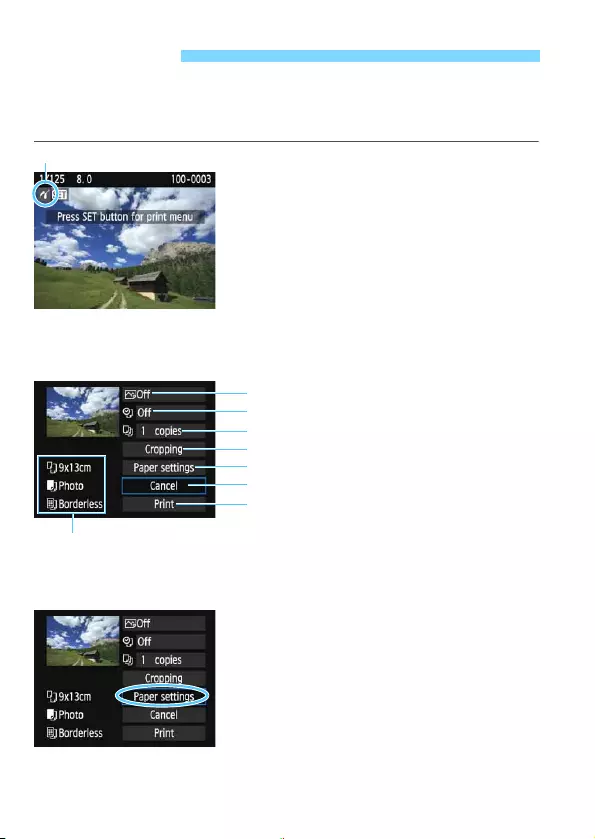
244
The screen display and setting options will differ depending on the
printer. Some settings may not be available. For details, refer to the
printer’s instruction manual.
1Select the image to be printed.
Check that the <w> icon is
displayed on the upper left of the LCD
monitor.
Press the <Y> <Z> keys to select
the image to be printed.
2Press <0>.
The print setting screen will reappear.
3Select [Paper settings].
Select [Paper settings], then press
<0>.
The paper settings screen will
appear.
w Printing
Printer-connected icon
Print setting screen
* Depending on the printer, certain settings such as the date and file
number imprinting and cropping may not be selectable.
Sets the printing effects (p.246).
Sets the date or file number imprinting to on or off.
Sets the quantity to be printed.
Sets the print area (p.249).
Sets the paper size, type, and layout.
Returns to the screen in step 1.
Starts the printing.
The paper size, type, and layout you have set are displayed.
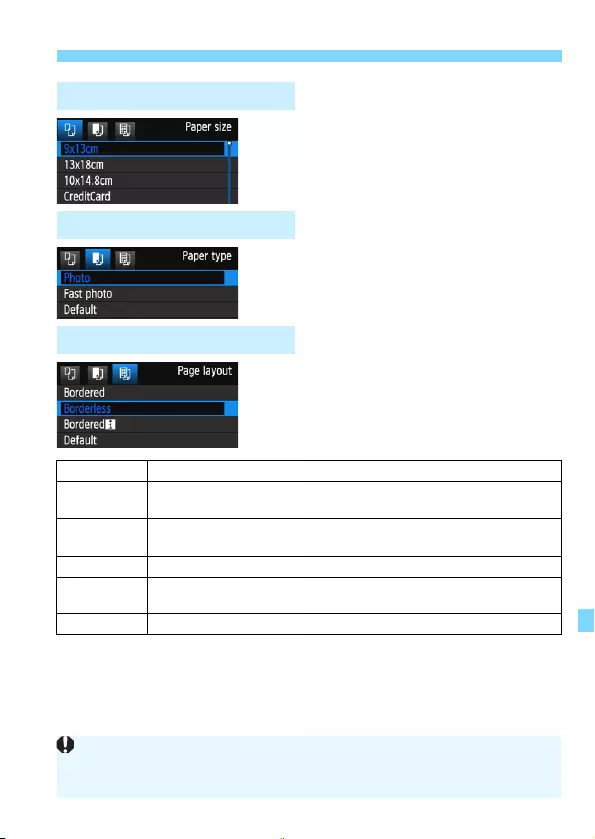
245
w Printing
Select the size of the paper loaded in
the printer, then press <0>.
The paper type screen will appear.
Select the type of the paper loaded in
the printer, then press <0>.
The page layout screen will appear.
Select the page layout, then press
<0>.
The print setting screen will reappear.
*1: From the Exif data, the camera name, lens name, shooting mode, shutter
speed, aperture, exposure compensation amount, ISO speed, white balance,
etc., will be imprinted.
*2: After ordering the prints with “Digital Print Order Format (DPOF)” (p.251),
printing by following “Direct Printing of Print-Ordered Images” (p.254) is
recommended.
QSetting the Paper Size
YSetting the Paper Type
USetting the Page Layout
Bordered Prints with white borders along the edges.
Borderless Prints with no borders. If your printer cannot print borderless
prints, the print will have borders.
BorderedcImprints the shooting information*1 on the border on 9x13 cm or
larger prints.
xx-up Option to print 2, 4, 8, 9, 16, or 20 images on one sheet.
20-upc
35-upp
Prints 20 or 35 images as thumbnails on A4 or Letter size paper*2.
• Imprints the shooting information*1 with [20-upc].
Default
The page layout varies depending on the printer model or its settings.
If the image’s aspect ratio is different from the printing paper’s aspect ratio, the
image may be cropped significantly when you print it as a borderless print. If the
image is cropped, the print may look grainier due to the fewer number of pixels.
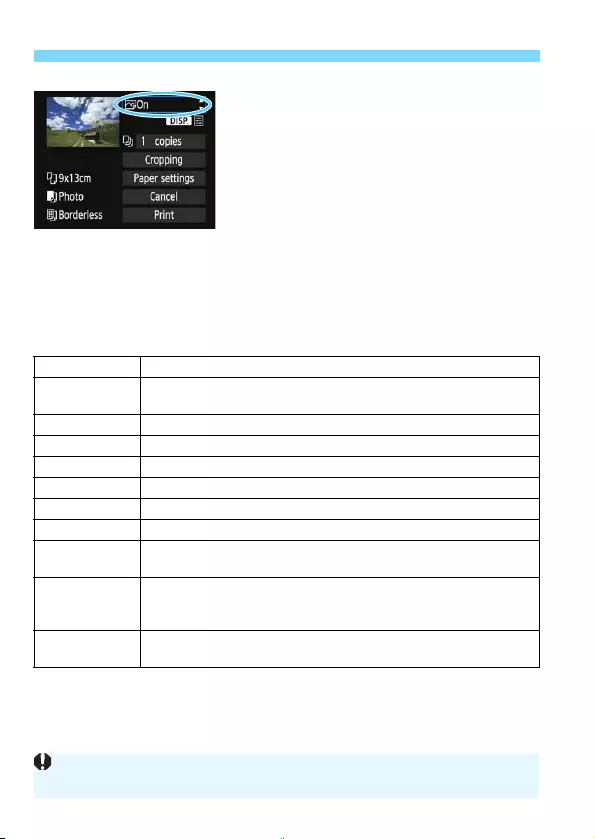
w Printing
246
4 Set the printing effects (image
optimization).
Set them if necessary. If you do not
need to set any printing effects, go to
step 5.
Contents displayed on the screen
vary depending on the printer.
Select the option, then press <0>.
Select the desired printing effect, then
press <0>.
If the <e> icon is displayed brightly
next to <z>, you can also adjust
the printing effect (p.248).
*
When you change the printing effects, changes are reflected in the image
displayed on the upper left of the screen. Note that the printed image may look
slightly different from the displayed image, which is only an approximation.
This also applies to [Brightness] and [Adjust levels] on page 248.
Printing Effect Description
EOn Prints with the printer’s standard colors. The image’s Exif data
is used to make automatic corrections.
EOff No automatic correction is applied.
EVivid
Prints with higher saturation to produce more vivid blues and greens.
ENR Image noise is reduced before printing.
0 B/W Prints in black-and-white with true blacks.
0 Cool tone Prints in black-and-white with cool, bluish blacks.
0
Warm tone
Prints in black-and-white with warm, yellowish blacks.
zNatural Prints the image in the actual colors and contrast. No automatic
color adjustments are applied.
zNatural M
Printing characteristics are the same as the “Natural” setting.
However, this setting enables finer printing adjustments than
with “Natural”.
EDefault Printing differs depending on the printer. For details, refer to the
printer’s instruction manual.
If you imprint shooting information on an image shot at an expanded ISO
speed (H), the correct ISO speed may not be imprinted.
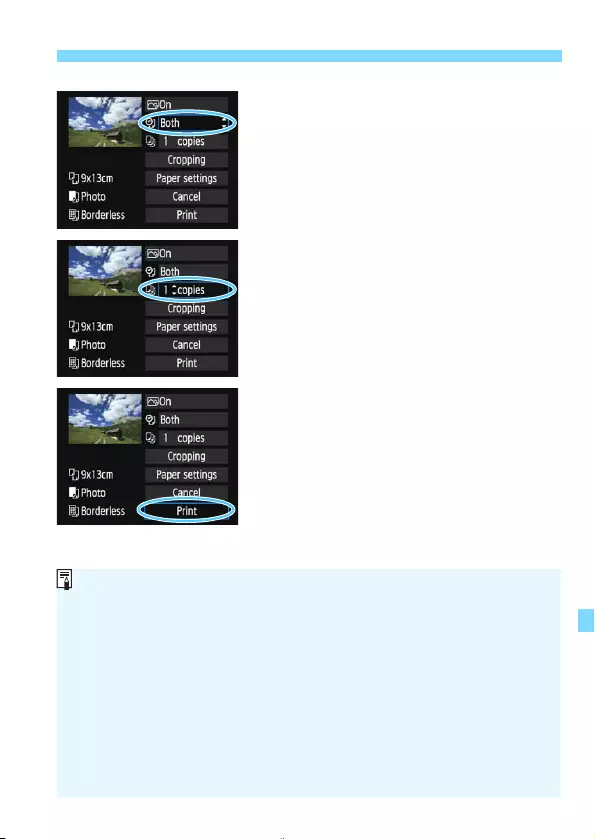
247
w Printing
5Set the date and file number
imprinting.
Set them if necessary.
Select <I>, then press <0>.
Set the print settings as desired, then
press <0>.
6Set the number of copies.
Set it if necessary.
Select <R>, then press <0>.
Set the number of copies, then press
<0>.
7Start printing.
Select [Print], then press <0>.
The [Default] setting for printing effects and other options are the
printer’s own default settings as set by the printer’s manufacturer. Refer
to the printer’s instruction manual to find out what the [Default] settings
are.
Depending on the image’s file size and image-recording quality, it may
take some time for the printing to start after you select [Print].
If image tilt correction (p.249) is applied, it may take longer to print the
image.
To stop the printing, press <0> while [Stop] is displayed, then select
[OK].
If you execute [Clear all camera settings] (p.194), all the settings will
revert to their defaults.
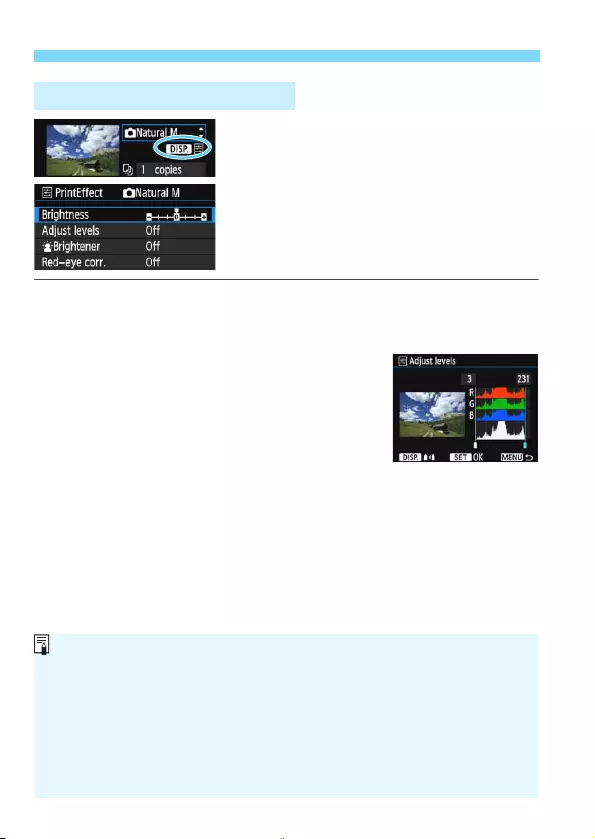
w Printing
248
In step 4 on page 246, select the printing
effect. When the <e> icon is displayed
brightly next to <z>, you can press
the <B> button to adjust the printing
effect. What can be adjusted or what is
displayed will depend on the selection
made in step 4.
Brightness
The image brightness can be adjusted.
Adjust levels
When you select [Manual], you can change
the histogram’s distribution and adjust the
image’s brightness and contrast.
With the Adjust levels screen displayed, press
the <B> button to change the position of
the <h>. Press the <Y> <Z> keys to freely
adjust the shadow level (0-127) or highlight
level (128-255).
kBrightener
Effective in backlit conditions where the subject’s face looks dark.
When [On] is set, the face will be brightened for printing.
Red-eye corr.
Effective in flash images where the subject has red eyes. When [On]
is set, the red eye will be corrected for printing.
e Adjusting Printing Effects
The [kBrightener] and [Red-eye corr.] effects will not be reflected on
the screen.
When [Detail set.] is selected, you can adjust the [Contrast],
[Saturation], [Color tone], and [Color balance]. To adjust the [Color
balance], use the <S> cross keys. B is for blue, A for amber, M for
magenta, and G for green. The image’s color balance will be adjusted
toward the color in the direction of the move.
If you select [Clear all], all the printing effect settings will be reverted to
their defaults.

249
w Printing
You can crop the image and print only an
enlarged version of the cropped portion,
as if the image is recomposed.
Set the cropping right before printing.
If you change the print settings after
setting the cropping, you may have to set
the cropping again before printing.
1 On the print setting screen, select [Cropping].
2 Set the cropping frame size, position, and aspect ratio.
The image area within the cropping frame will be printed. The
cropping frame’s aspect ratio can be changed with [
Paper settings
].
Changing the Cropping Frame Size
Press the <u> or <Hy> button to change the cropping frame
size. The smaller the cropping frame, the larger the image
magnification will be for printing.
Moving the Cropping Frame
Press the <S> cross keys to move the frame over the image
vertically or horizontally. Move the cropping frame until it covers
the desired image area.
Rotate the Cropping Frame
Pressing the <B> button will toggle the cropping frame
between the vertical and horizontal orientations. This enables you
to create a vertically oriented print from a horizontal image.
Image Tilt Correction
By turning the <6> dial, you can adjust the image tilt angle up to
±10 degrees in 0.5-degree increments. When you adjust the
image tilt, the <O> icon on the screen will turn blue.
3 Press <0> to exit the cropping.
The print setting screen will reappear.
You can check the cropped image area on the upper left of the
print setting screen.
Cropping the Image
Tilt correction

w Printing
250
Depending on the printer, the cropped image area may not be printed as
you specified.
The smaller you make the cropping frame, the grainier the picture will
look in the print.
Check the camera’s LCD monitor while cropping the image. If you look at
the image on a TV screen, the cropping frame may not be displayed
accurately.
Handling Printer Errors
If printing does not resume after you resolve a printer error (no ink, no paper,
etc.) and select [Continue], operate the buttons on the printer to resume
printing. For details on resuming the printing, refer to the printer’s instruction
manual.
Error Messages
If a problem occurs during printing, an error message will appear on the
camera’s LCD monitor. Press <0> to stop printing. After fixing the problem,
resume printing. For details on how to fix a printing problem, refer to the
printer’s instruction manual.
Paper Error
Check whether the paper is properly loaded in the printer.
Ink Error
Check the printer’s ink level and the waste ink tank.
Hardware Error
Check for any printer problems other than paper and ink problems.
File Error
The selected image cannot be printed via PictBridge. Images taken with a
different camera or images edited with a computer may not be printable.
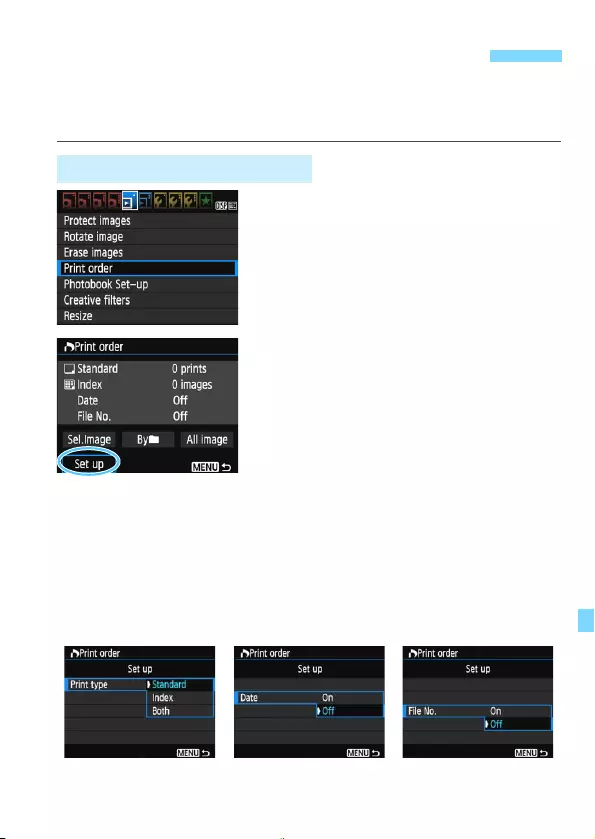
251
You can set the print type, date imprinting, and file number imprinting.
The print settings will be applied to all print-ordered images. (They
cannot be set individually for each image.)
1Select [Print order].
Under the [x1] tab, select [Print
order], then press <0>.
2Select [Set up].
Select [Set up], then press <0>.
3Set the option as desired.
Set the [Print type], [Date], and [File
No.].
Select the option to be set, then press
<0>. Select the desired setting, then
press <0>.
W Digital Print Order Format (DPOF)
Setting the Printing Options
[Print type][Date][File No.]
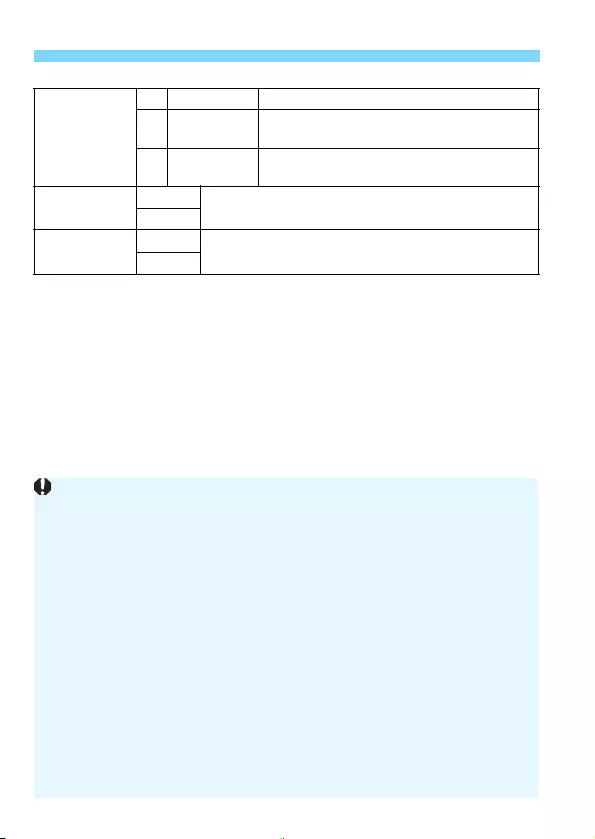
W Digital Print Order Format (DPOF)
252
4 Exit the setting.
Press the <7> button.
The print order screen will reappear.
Next, select [Sel.Image], [Byn], or
[All image] to order the images to be
printed.
Print type
KStandard Prints one image on one sheet.
LIndex Multiple thumbnail images are printed on
one sheet.
K
LBoth Prints both the standard and index prints.
Date On [On] imprints the recorded date on the print.
Off
File number On [On] imprints the file number on the print.
Off
RAW images and movies cannot be print ordered. You can print RAW
images with PictBridge (p.242).
Even if [Date] and [File No.] are set to [On], the date or file number may
not be imprinted depending on the print type setting and printer model.
With [Index] prints, the [Date] and [File No.] cannot both be set to [On]
at the same time.
When printing with DPOF, use the card whose print order specifications
have been set. It cannot be printed with the specified print order if you
just extract images from the card and try to print them.
Certain DPOF-compatible printers and photofinishers may not be able to
print the images as you specified. Refer to the printer’s instruction
manual before printing, or check with your photofinisher about
compatibility when ordering prints.
Do not insert into the camera a card whose print order was set by a
different camera and then try to specify a print order. The print order may
be overwritten. Also, the print order may not be possible, depending on
the image type.

253
W Digital Print Order Format (DPOF)
Sel.Image
Select and order images one by one.
To display the three-image display, press
the <Hy> button. To return to the
single-image display, press the <u>
button.
Press the <M> button to save the
print order to the card.
[Standard] [Both]
Press the <W> <X> keys to set the
number of copies to be printed for the
displayed image.
[Index]
Press the <W> <X> keys to add a
checkmark to the box <X>. The image
will be included in the index print.
Byn
Select [Mark all in folder] and select the folder. A print order for one
copy of all the images in the folder will be specified. If you select
[Clear all in folder] and select the folder, the print order for that
folder will all be canceled.
All image
If you select [Mark all on card], one copy of all the images on the
card will be set for printing. If you select [Clear all on card], the print
order will be cleared for all the images on the card.
Print Ordering
Quantity
Total images selected
Index icon
Checkmark
Note that RAW images and movies will not be included in the print order
even if you set [Byn] or [All image].
When using a PictBridge printer, print no more than 400 images for one
print order. If you specify more than this, all the images may not be
printed.
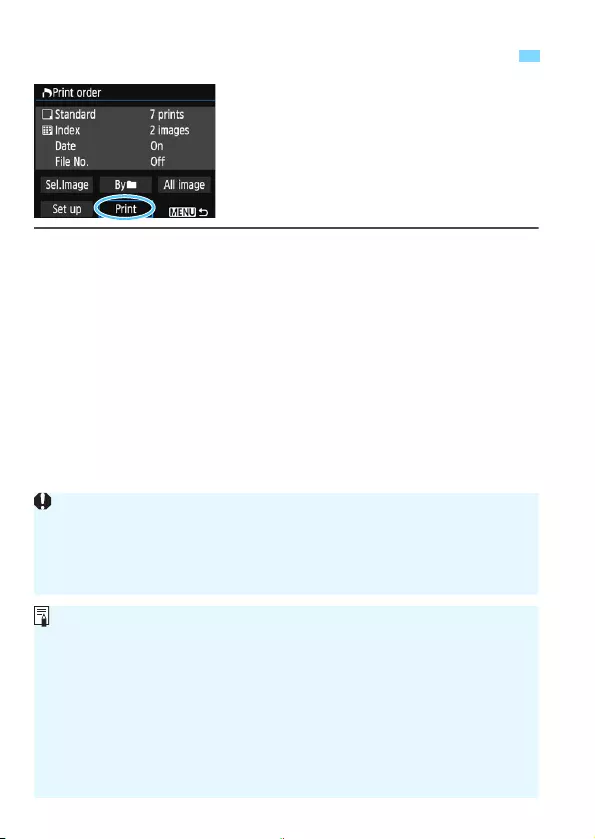
254
With a PictBridge printer, you can easily
print images with DPOF.
1 Prepare to print.
See page 242.
Follow the “Connecting the Camera to a Printer” procedure up to step 5.
2 Under the [x1] tab, select [Print order].
3 Select [Print].
[Print] will be displayed only if the camera is connected to a
printer and printing is possible.
4 Set the [Paper settings] (p.244).
Set the printing effects (p.246) if necessary.
5 Select [OK].
WDirect Printing of Print-Ordered Images
Before printing, be sure to set the paper size.
Certain printers cannot imprint the file number.
If [Bordered] is set, certain printers may imprint the date on the border.
Depending on the printer, the date may appear faint if it is imprinted on a
bright background or on the border.
Under [Adjust levels], [Manual] cannot be selected.
If you stopped the printing and want to resume printing the remaining
images, select [Resume]. Note that printing will not resume if any of the
following occurs.
• You changed the print order or deleted any of the print ordered images
before resuming the printing.
• When index is set, you changed the paper setting before resuming the
printing.
• The card’s remaining capacity was low when you paused the printing.
If a problem occurs during printing, see page 250.
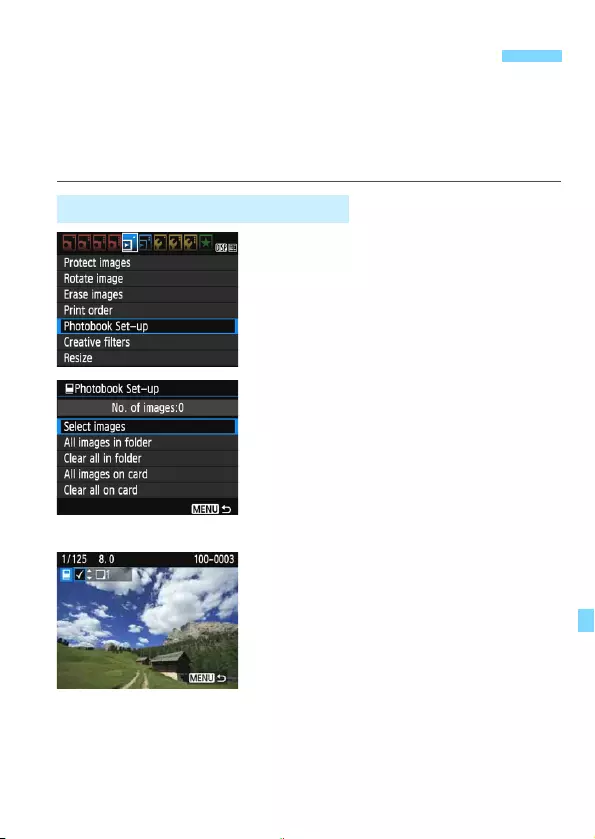
255
You can specify up to 998 images to be printed in a photobook. When
you use EOS Utility (EOS software) to transfer images to a computer,
the specified images will be copied into a dedicated folder. This function
is useful for ordering photobooks online and for printing photobooks on
a printer.
1Select [Photobook Set-up].
Under the [x1] tab, select
[Photobook Set-up], then press
<0>.
2Select [Select images].
Select [Select images], then press
<0>.
An image will be displayed.
To display the three-image display,
press the <Hy> button. To return to
the single-image display, press the
<u> button.
3Select the image to be specified.
Press the <Y> <Z> keys to select
the image to be specified, then press
the <W> <X> keys.
Repeat this step to select another
image. The number of images that
have been specified will be displayed
on the upper left of the screen.
To cancel the image specification,
press the <W> <X> keys again.
To return to the menu, press the
<M> button.
p Specifying Images for a Photobook
Specifying One Image at a Time
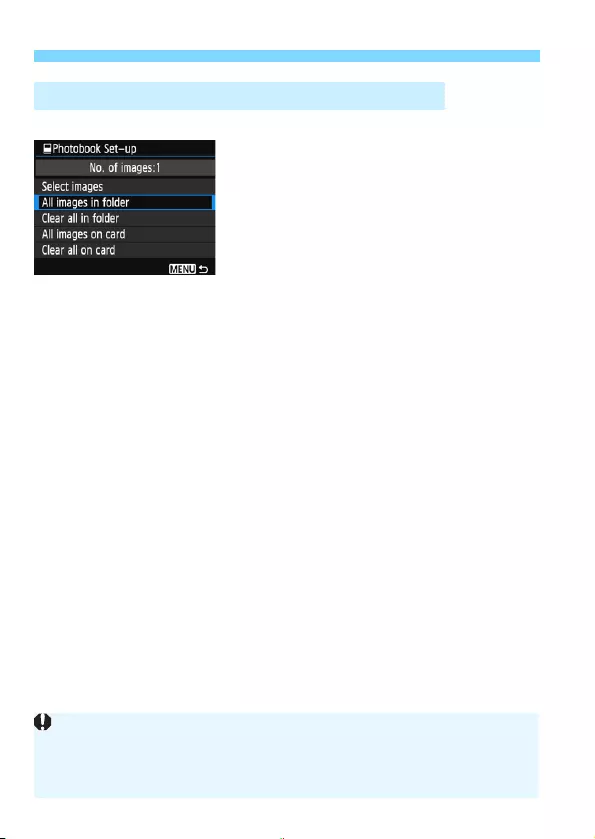
p Specifying Images for a Photobook
256
You can specify all the images in a folder or on a card at once.
When [x1: Photobook Set-up] is set
to [All images in folder] or [All images
on card], all the images in the folder or
on the card will be specified.
To cancel the image specification, select
[Clear all in folder] or [Clear all on
card].
Specifying All Images in a Folder or on a Card
RAW images and movies cannot be specified.
Do not specify images already specified for a photobook in another
camera for another photobook with this camera. The photobook settings
may be overwritten.
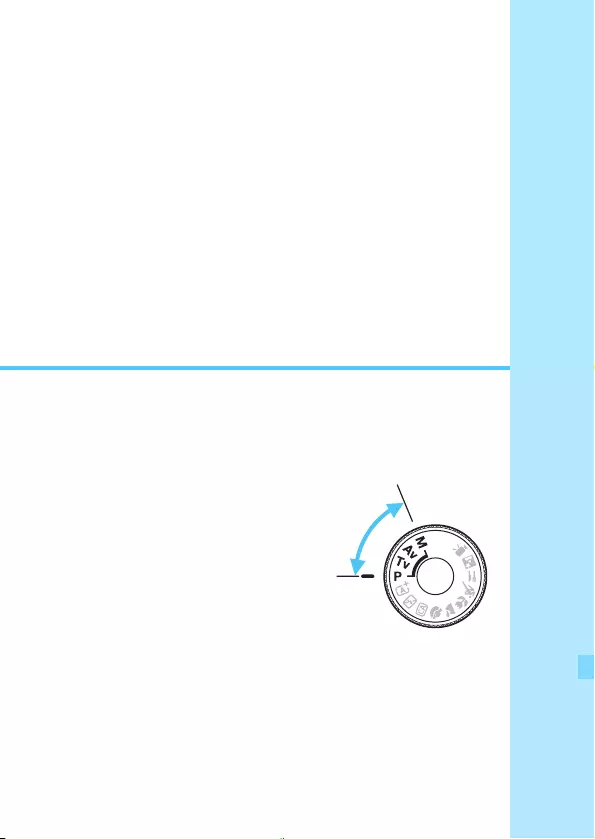
257
11
Customizing the
Camera
You can make fine adjustments to various camera
functions to suit your picture-taking preferences with
Custom Functions. Custom Functions can be set and
used only in Creative Zone modes.
C
r
e
a
t
i
v
e
Z
o
n
e
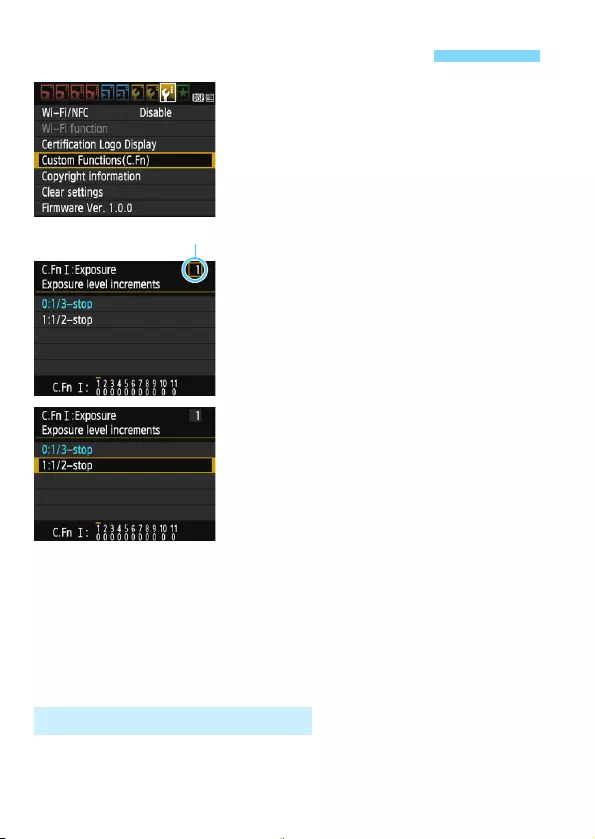
258
1Select [Custom Functions (C.Fn)].
Under the [53] tab, select [Custom
Functions (C.Fn)], then press <0>.
2Select the Custom Function
number.
Press the <Y> <Z> keys to select
the Custom Function number, then
press <0>.
3Change the setting as desired.
Press the <W> <X> keys to select
the desired setting (number), then
press <0>.
Repeat steps 2 and 3 if you want to
set other Custom Functions.
At the bottom of the screen, the
current Custom Function settings are
indicated below the respective
function numbers.
4Exit the setting.
Press the <M> button.
The screen for step 1 will reappear.
Under [53: Clear settings], select [Clear all Custom Func. (C.Fn)] to
clear all the Custom Function settings (p.194).
3 Setting Custom FunctionsN
Custom Function number
Clearing All Custom Functions
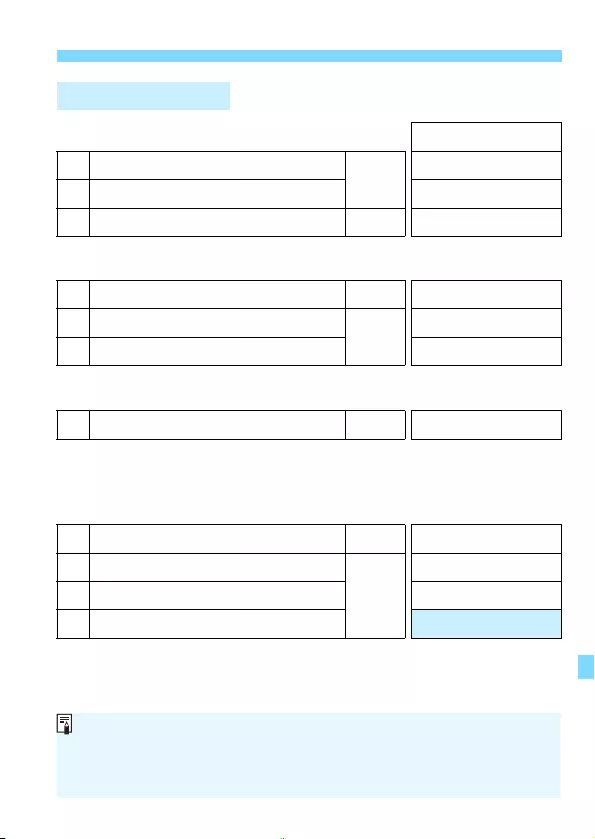
259
3 Setting Custom FunctionsN
* If you use an EX-series Speedlite (sold separately) equipped with an LED light,
the LED light will turn on for AF-assist even in the d or c mode.
Custom Functions
C.Fn I: Exposure ALV Shooting
1Exposure level increments
p.260
k
2ISO expansion k
3
Flash synchronization speed in Av mode
p.261 k
C.Fn II: Image
4Long exposure noise reduction p.262 k
5High ISO speed noise reduction
p.263
k
6 Highlight tone priority k
C.Fn III: Autofocus/Drive
7AF-assist beam firing p.264 k (With f*)
C.Fn IV: Operation/Others
8Shutter/AE lock button p.265 k
9Assign SET button
p.266
k (Except 3)
10 Flash button function k
11 LCD display when power ON
Custom Functions cannot be set during movie shooting. (Settings
already set will be disabled.)
Shaded Custom Function does not function during Live View (LV)
shooting.
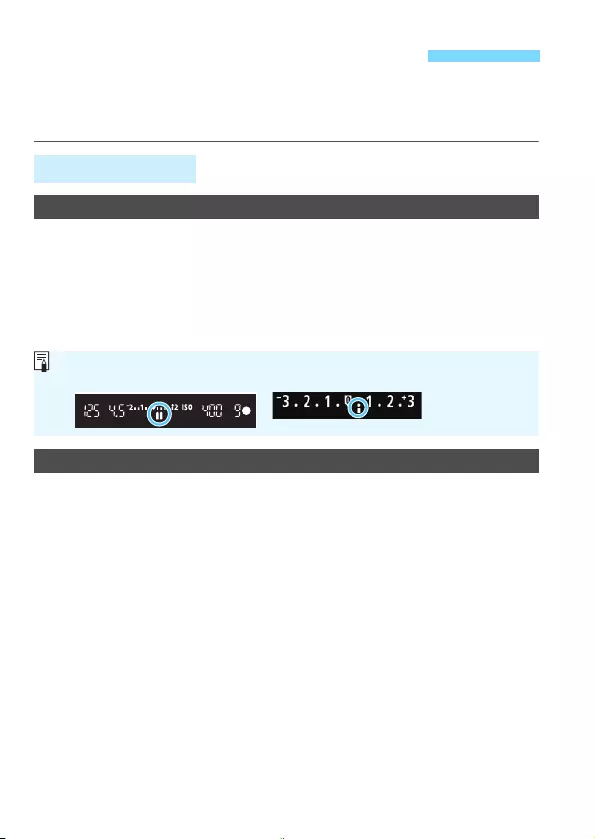
260
Custom Functions are organized into four groups based on the function
type: C.Fn I: Exposure, C.Fn II: Image, C.Fn III: Autofocus/Drive, C.Fn
IV: Operation/Others.
3 Custom Function SettingsN
C.Fn I: Exposure
C.Fn-1 Exposure level increments
0: 1/3-stop
1: 1/2-stop
Sets 1/2-stop increments for the shutter speed, aperture, exposure
compensation, AEB, flash exposure compensation, etc. This is
effective when you prefer to control the exposure in less fine
increments than 1/3-stop increments.
C.Fn-2 ISO expansion
0: Off
1: On
When you set the ISO speed, you will be able to set “H”
(equivalent to ISO 12800). Note that if [C.Fn-6: Highlight tone
priority] is set to [1: Enable], “H” cannot be set.
When 1 is set, the exposure level will be displayed in the viewfinder and on
the LCD Monitor as shown below.

261
3 Custom Function SettingsN
C.Fn-3 Flash Synchronization Speed in Av Mode
You can set the flash-sync speed for flash photography in the
aperture-priority AE <f> mode.
0: Auto
The flash sync speed is set automatically within a range of 1/200
sec. to 30 sec. to suit the scene’s brightness. With an external
Speedlite, high-speed sync will also be possible.
1: 1/200-1/60 sec. auto
Prevents a slow shutter speed from being set in low-light
conditions. It is effective for preventing subject blur and camera
shake. However, while the subject will be properly exposed with
the flash, the background may come out dark.
2: 1/200 sec. (fixed)
The flash-sync speed is fixed at 1/200 sec. This more effectively
prevents subject blur and camera shake than with [1: 1/200-1/
60sec. auto]. However, in low light, the subject’s background will
come out darker than with [1: 1/200-1/60sec. auto].
When 1 or 2 is set, high-speed sync cannot be used with an external
Speedlite.

3 Custom Function SettingsN
262
C.Fn II: Image
C.Fn-4 Long Exposure Noise Reduction
0: Off
1: Auto
For exposures of 1 sec. or longer, noise reduction is performed
automatically if noise typical of long exposures is detected. This
[Auto] setting is effective in most cases.
2: On
Noise reduction is performed for all exposures of 1 sec. or longer.
The [2: On] setting may reduce noise that cannot be detected with
the [1: Auto] setting.
With settings 1 and 2, after the picture is taken, the noise reduction
process may take the same amount of time as the exposure. You cannot
take another picture until the noise reduction process is completed.
At ISO 1600 or higher, noise may be more pronounced with setting 2
than with setting 0 or 1.
With setting 1 or 2, if a long exposure is shot with the Live View image
displayed, “BUSY” will be displayed during the noise reduction process.
The Live View display will not appear until the noise reduction is
completed. (You cannot take another picture.)

263
3 Custom Function SettingsN
C.Fn-5 High ISO speed noise reduction
This function reduces the noise generated in the image. Although
noise reduction is applied at all ISO speeds, it is particularly effective
at high ISO speeds. At low ISO speeds, the noise in the darker parts of
the image (shadow areas) is further reduced. Change the setting to
suit the noise level.
0: Standard 2: Strong
1: Low 3: Disable
C.Fn-6 Highlight tone priority
0: Disable
1: Enable
Improves the highlight detail. The dynamic range is expanded from
the standard 18% gray to bright highlights. The gradation between
the grays and highlights becomes smoother.
With setting 2, the maximum burst during continuous shooting will greatly
decrease. Also, the continuous shooting speed may be slower.
If you play back or directly print a 1 or 1+73 image with the
camera, the high ISO speed noise reduction effect may become smaller.
Check the noise reduction effect or print noise-reduced images with
Digital Photo Professional (EOS software, p.314).
If you send RAW images to a smartphone, the high ISO speed noise
reduction effect of saved images on the smartphone may become
smaller. Therefore, if you shoot RAW images, setting the image-
recording quality to 1+73 is recommended.
With setting 1, the Auto Lighting Optimizer (p.123) is automatically set to
[Disable] and the setting cannot be changed.
With setting 1, noise (grainy image, banding, etc.) may become slightly
more noticeable than with setting 0.
With setting 1, the ISO setting range will be ISO 200 - ISO 6400.
Also, the <A> icon will be displayed on the LCD monitor and in the
viewfinder to indicate that highlight tone priority is enabled.

3 Custom Function SettingsN
264
C.Fn III: Autofocus/Drive
C.Fn-7 AF-assist beam firing
Enables or disables the built-in flash’s AF-assist beam or the EOS-
dedicated external Speedlite’s AF-assist beam.
0: Enable
The AF-assist beam will be emitted when necessary.
1: Disable
The AF-assist beam will not be emitted. This prevents the AF-
assist beam from disturbing others.
2: Enable external flash only
If an external Speedlite is attached, it will emit the AF-assist beam
when necessary. The camera’s built-in flash will not fire the AF-
assist beam.
3: IR AF assist beam only
When an external Speedlite is attached, only the infrared AF-assist
beam will be emitted. This prevents any Speedlite which uses a
series of intermittent flashes (like the built-in flash) from emitting
the AF-assist beam.
With an EX-series Speedlite equipped with an LED light, the LED
light will not automatically turn on for AF-assist.
If an external Speedlite’s [AF-assist beam firing] Custom Function is set
to [Disabled], the Speedlite will not emit the AF-assist beam even if the
camera’s C.Fn-7 is set to 0, 2, or 3.

265
3 Custom Function SettingsN
C.Fn IV: Operation/Others
C.Fn-8 Shutter/AE lock button
0: AF/AE lock
1: AE lock/AF
This is convenient when you want to focus and meter separately.
Press the <A> button to autofocus, and press the shutter button
halfway to apply AE lock.
2: AF/AF lock, no AE lock
During AI Servo AF, you can press the <A> button to pause the
AF operation momentarily. This prevents the AF from being thrown
off by any obstacle passing between the camera and subject. The
exposure is set at the moment the picture is taken.
3: AE/AF, no AE lock
This is useful for subjects that keep moving and stopping
repeatedly. During AI Servo AF, you can press the <A> button to
start or stop the AI Servo AF operation. The exposure is set at the
moment the picture is taken. Thus, you can set your camera, so
that the optimum focusing and exposure can be achieved and wait
for the decisive moment.
During Live View shooting
With setting 1 or 3, press the <A> button for One-Shot AF.
With setting 0 or 2, press the shutter button halfway for One-Shot AF.

3 Custom Function SettingsN
266
C.Fn-9 Assign SET button
You can assign a frequently-used function to <
0
>. When the camera is ready to
shoot, pressing the <
0
> button will display the respective function setting screen.
0: Normal (disabled)
1: Image quality
The image quality setting screen will appear. Select the desired
image-recording quality, then press <0>.
2: Flash exposure compensation
The flash exposure compensation setting screen will appear. Set
the adjustment amount, then press <0>.
3: LCD monitor On/Off
You can turn on or off the LCD monitor.
4: Depth-of-field preview
The lens will stop down to the aperture that was set, and you can see the depth
of field (range of acceptable focus) in the viewfinder or in the Live View image.
C.Fn-10 Flash button function
0: Raise built-in flash
1: ISO speed
The ISO speed setting screen will appear. Press the <Y> <Z>
keys or turn the <6> dial to change the ISO speed. You can also
refer to the viewfinder to set the ISO speed.
C.Fn-11 LCD display when power ON
0: Display on
When the power switch is turned on, the shooting settings will be
displayed (p.54).
1: Previous display status
If you pressed the <B> button and turned off the camera while
the LCD monitor was off, the shooting function settings will not be
displayed when you turn on the camera again. This helps to save
battery power. The menu operations and image playback will be
available as usual.
If you pressed the <B> button to display the shooting function
settings and then turned off the camera, the shooting settings will
be displayed when you turn on the camera again.
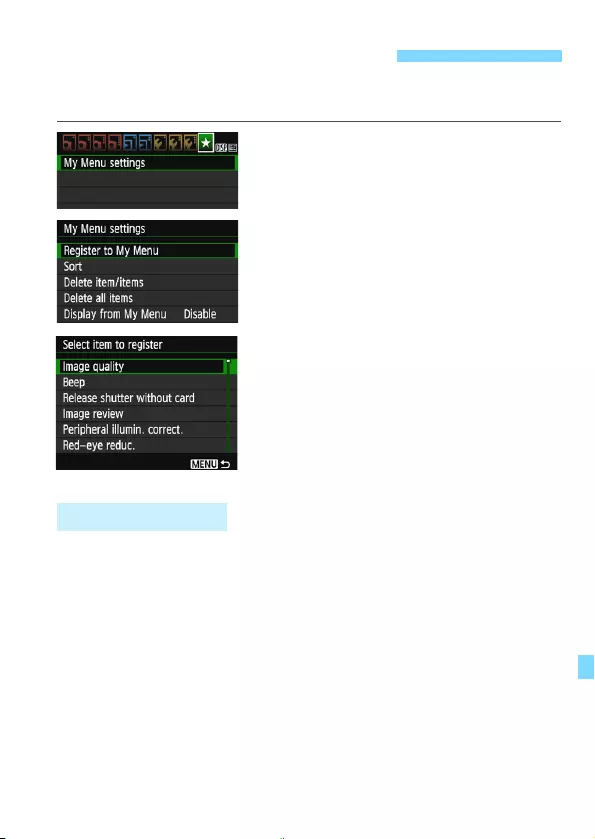
267
Under the My Menu tab, you can register up to six menu options and
Custom Functions whose settings you change frequently.
1Select [My Menu settings].
Under the [9] tab, select [My Menu
settings], then press <0>.
2Select [Register to My Menu].
Select [Register to My Menu], then
press <0>.
3Register the desired items.
Select the item, then press <0>.
On the confirmation dialog, select
[OK] and press <0> to register the
item.
You can register up to six items.
To return to the screen in step 2,
press the <M> button.
Sort
You can change the order of the registered items in My Menu. Select
[Sort] and select the item whose order you want to change. Then
press <0>. With [z] displayed, press the <W> <X> keys to
change the order, then press <0>.
Delete item/items and Delete all items
You can delete any of the registered items. [Delete item/items]
deletes one item at a time, and [Delete all items] deletes all
registered items.
Display from My Menu
When [Enable] is set, the [9] tab will be displayed first when you
display the menu screen.
3 Registering My MenuN
My Menu Settings

268
MEMO

269
12
Reference
This chapter provides reference information for camera
features, system accessories, etc.
Certification Logo
Under the [53] tab, if you select [Certification Logo Display]
and press <0>, some of the logos of the camera’s certifications
will appear. Other certification logos can be found in this
Instruction Manual, on the camera body, and on the camera’s
package.
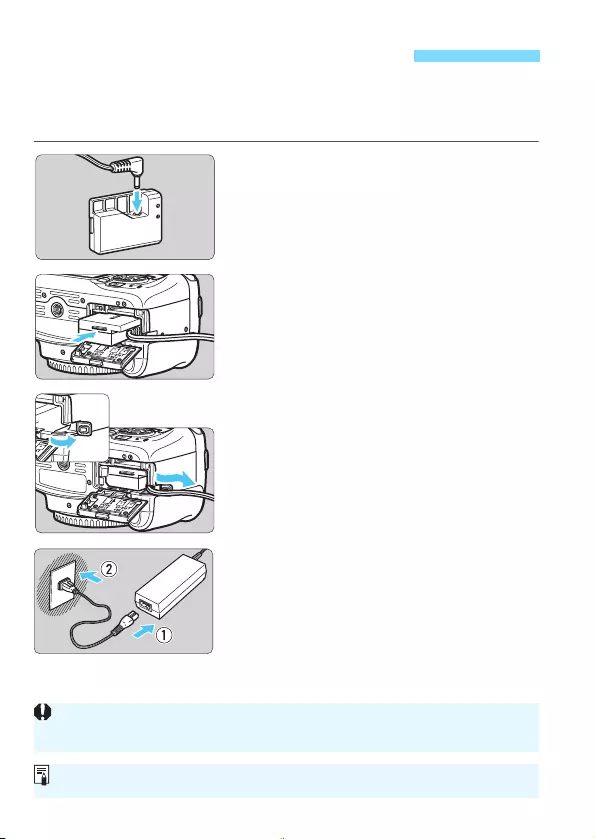
270
You can power the camera with a household power outlet by using the
DC Coupler DR-E10 and Compact Power Adapter CA-PS700 (both
sold separately).
1Connect the DC coupler.
Connect the DC cord’s plug to the DC
coupler.
2Insert the DC coupler.
Open the cover and insert the DC
coupler until it locks in place.
3Push in the DC cord.
Open the DC cord hole cover and
install the cord as shown in the
illustration.
Close the cover.
4Connect the power cord.
Connect the power cord as shown in
the illustration.
After using the camera, unplug the
power plug from the power outlet.
Using a Household Power Outlet
Do not connect or disconnect the power cord when the camera’s power
switch is set to <1>.
AC Adapter Kit ACK-E10 can also be used.
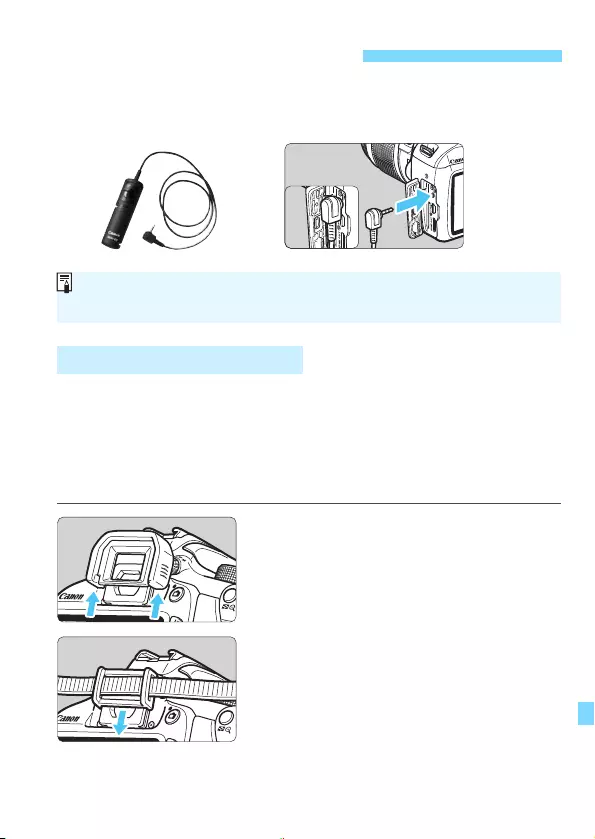
271
Remote Switch RS-60E3 (sold separately) comes with an approx. 60 cm/
2.0 ft cord. When connected to the camera’s remote control terminal, it
can be pressed halfway and completely, just like the shutter button.
When you use the self-timer, bulb, or a remote switch and do not look
through the viewfinder, stray light entering the viewfinder can cause the
picture to look dark. To prevent this, use the eyepiece cover (p.33)
attached to the camera strap.
During Live View shooting and movie shooting, attaching the
eyepiece cover is unnecessary.
1Detach the eyecup.
Push the bottom of the eyecup to
detach it.
2Attach the eyepiece cover.
Slide the eyepiece cover down into
the eyepiece groove to attach it.
After you finish shooting, detach the
eyepiece cover and attach the
eyecup by sliding it down into the
eyepiece groove.
F Using a Remote Switch
Using the Eyepiece Cover
Remote Controller RC-6, RC-1, and RC-5 (all sold separately) cannot be
used with this camera.
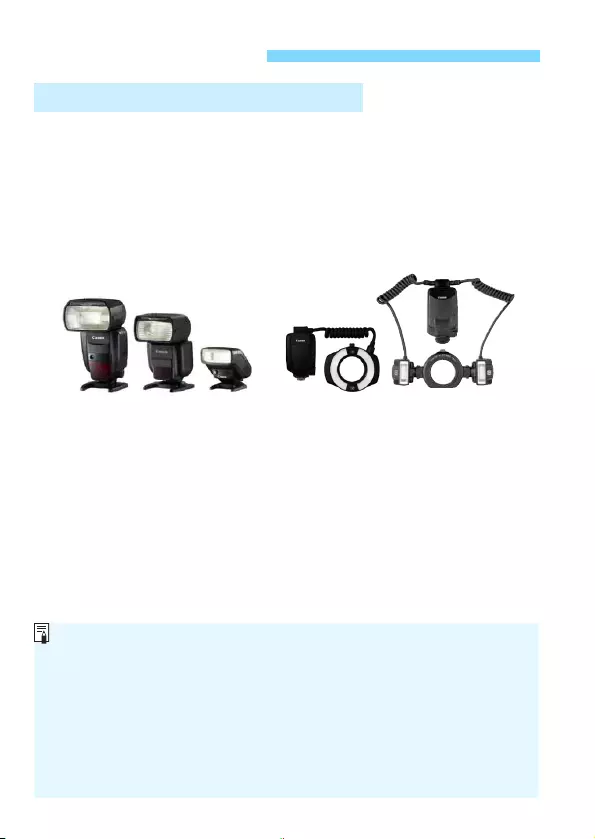
272
Basically operates like a built-in flash for easy operation.
When an EX-series Speedlite (sold separately) is attached to the
camera, almost all the autoflash control is done by the camera. In other
words, it is like a high-output flash attached externally in place of the
built-in flash.
For detailed instructions, refer to the EX-series Speedlite’s
instruction manual. This camera is a Type-A camera.
External Speedlites
EOS-dedicated, EX-series Speedlites
Shoe-mount Speedlites Macro Lites
With an EX-series Speedlite not compatible with flash function settings
(p.199), only [Flash exp. comp] and [E-TTL II meter.] can be set for
[External flash func. setting]. ([Shutter sync.] can also be set with
certain EX-series Speedlites.)
If flash exposure compensation is set with the external Speedlite, the
flash exposure compensation icon displayed on the camera’s LCD
monitor will change from y to 0.
If the external Speedlite’s Custom Function has the flash metering mode
set to TTL autoflash, the flash will fire at full output only.

273
External Speedlites
With an EZ/E/EG/ML/TL-series Speedlite set in TTL or A-TTL
autoflash mode, the flash will be fired at full output only.
Set the camera’s shooting mode to <a> (manual exposure) or
<f> (aperture-priority AE) and adjust the aperture setting before
shooting.
When using a Speedlite that has manual flash mode, shoot in the
manual flash mode.
Sync Speed
The camera can synchronize with compact, non-Canon flash units at
1/200 sec. or slower shutter speeds. Use a sync speed slower than
1/200 sec.
Be sure to test the flash unit beforehand to make sure it synchronizes
properly with the camera.
Canon Speedlites Other Than the EX-series
Using Non-Canon Flash Units
If the camera is used with a flash unit or flash accessory dedicated to
another camera brand, the camera may not operate properly and
malfunction may result.
Do not attach a high-voltage flash unit on the camera’s hot shoe. It may
not fire.
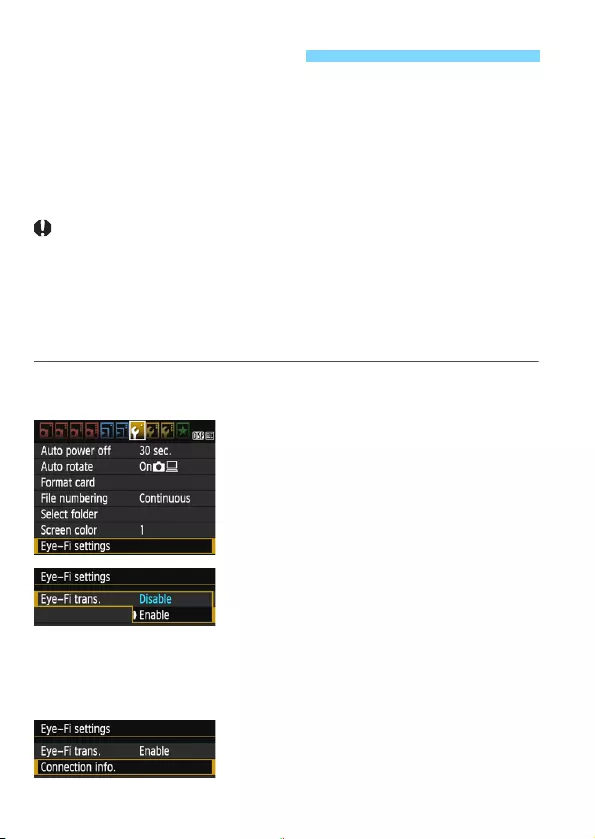
274
With a commercially-available Eye-Fi card already set up, you can
automatically transfer captured images to a computer or upload them to
an online service via a wireless LAN.
The image transfer is a function of the Eye-Fi card. For instructions on
how to set up and use the Eye-Fi card or to troubleshoot any image
transfer problems, refer to the Eye-Fi card’s instruction manual or
contact the card manufacturer.
The camera is not guaranteed to support Eye-Fi card functions
(including wireless transfer). In case of a problem with an Eye-
Fi card, please check with the card manufacturer. Also note that
approval is required to use Eye-Fi cards in many countries or
regions. Without approval, use of the card is not permitted. If it
is unclear whether the card has been approved for use in your
area, please check with the card manufacturer.
1Insert an Eye-Fi card (p.36).
2Select [Eye-Fi settings].
Under the [51] tab, select [Eye-Fi
settings], then press <0>.
This menu is displayed only when an
Eye-Fi card is inserted into the
camera.
3Enable Eye-Fi transmission.
Select [
Eye-Fi trans.
], then press <
0
>.
Select [Enable], then press <0>.
If you set [Disable], there will be no
automatic transmission even with the
Eye-Fi card inserted (transmission
status icon I).
4
Display the connection information.
Select [Connection info.], then press
<0>.
H Using Eye-Fi Cards
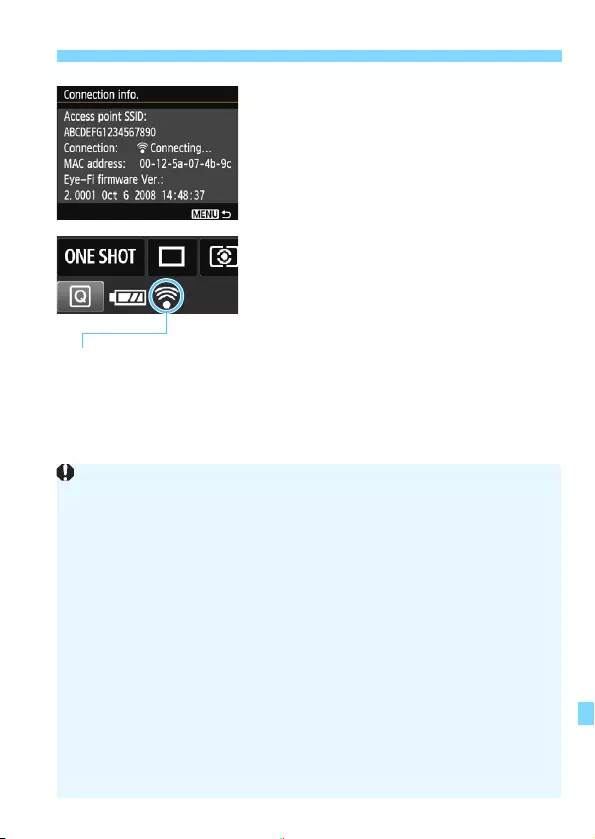
275
H Using Eye-Fi Cards
5Check the [Access point SSID:].
Check that an access point is
displayed for [Access point SSID:].
You can also check the Eye-Fi card’s
MAC address and firmware version.
Press the <M> button three times
to exit the menu.
6Take the picture.
The picture is transferred and the
<H> icon switches from gray (not
connected) to one of the icons below.
For transferred images, O is
displayed in the shooting information
display (p.232).
H (Gray) Not connected : No connection with access point.
H (Blinking) Connecting... : Connecting to access point.
H (Illuminated) Connected:
Connection to access point established.
H () Transferring... :
Image transfer to access point in progress.
Transmission status icon
Cautions for Using Eye-Fi Cards
If [53:Wi-Fi/NFC] is set to [Enable], image transfer with an Eye-Fi card
is not possible.
If “J” is displayed, an error occurred while retrieving the card
information. Turn the camera’s power switch off and on again.
Even if [51: Eye-Fi trans.] is set to [Disable], it may still transmit a
signal. In hospitals, airports, and other places where wireless
transmissions are prohibited, remove the Eye-Fi card from the camera.
If the image transfer does not function, check the Eye-Fi card and
computer settings. For details, refer to the card’s instruction manual.
Depending on the wireless LAN’s connection conditions, the image
transfer may take longer or it may be interrupted.
The Eye-Fi card may become hot as it transmits.
The battery power will be consumed faster.
During the image transfer, auto power off will not take effect.
If you insert a wireless LAN card other than an Eye-Fi card, [51: Eye-Fi
settings] will not appear. Also, the transmission status icon <H> will not
appear.
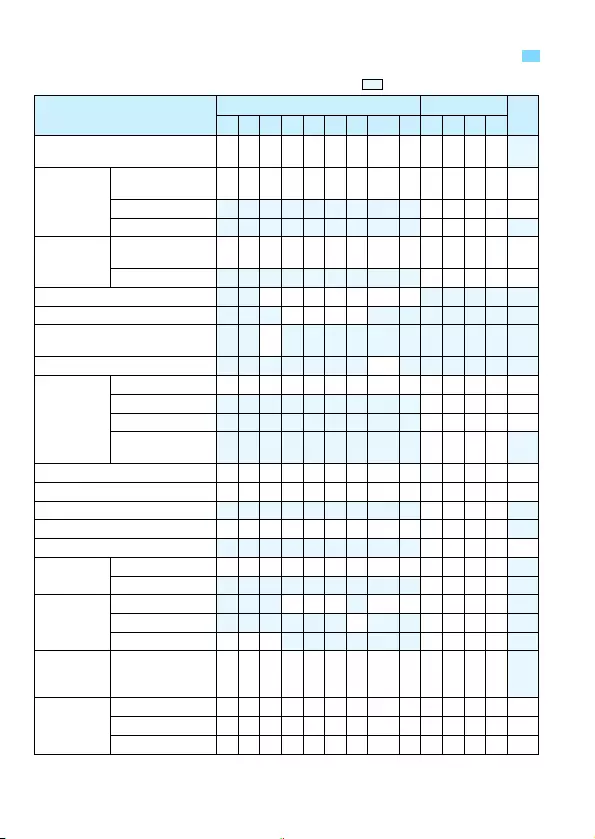
276
o: Set automatically k: User selectable
: Not selectable/Disabled
*1: Settable only for manual exposures.
*2: If used during movie shooting, it will switch to <d>.
Function Availability Table by Shooting Mode
Mode Dial Basic Zone Creative Zone k
A 7 C2 3 4 5 P 6 d sf a
All image quality settings
selectable kkkkkkk k kkkkk
ISO speed
Automatically set/
Auto ooooooo o okkkk k
Manually set kkkkk
*1
Maximum for Auto kkkk
Picture
Style
Automatically set/
Auto ooooooo o okkkk k
Manual selection kkkk k
Ambience-based shots kkkkk k k
Lighting/scene based shots kkkk
Blurring/sharpening the
background k
Color tone k
White
balance
Auto QQQQQQQQwQkkkk k
Preset kkkk k
Custom kkkk k
Correction/
Bracketing kkkk
Auto Lighting Optimizer ooooooo o okkkk k
Peripheral illumination correction
kkkkkkk k kkkkk k
Long exposure noise reduction
kkkk
High ISO speed noise reduction
ooooooo o okkkk
Highlight tone priority kkkk k
Color space sRGB ooooooo o okkkk
Adobe RGB kkkk
AF operation
(Viewfinder
shooting)
One-Shot AF ooo o okkkk
AI Servo AF okkkk
AI Focus AF ooo kkkk
AF operation
(Live View
shooting)
One-Shot AF ooooooo o ooooo
AF method
(Live View
shooting)
dkkkkkkk k kkkkk k
ckkkkkkk k kkkkk k
fkkkkkkk k kkkkkk
*2
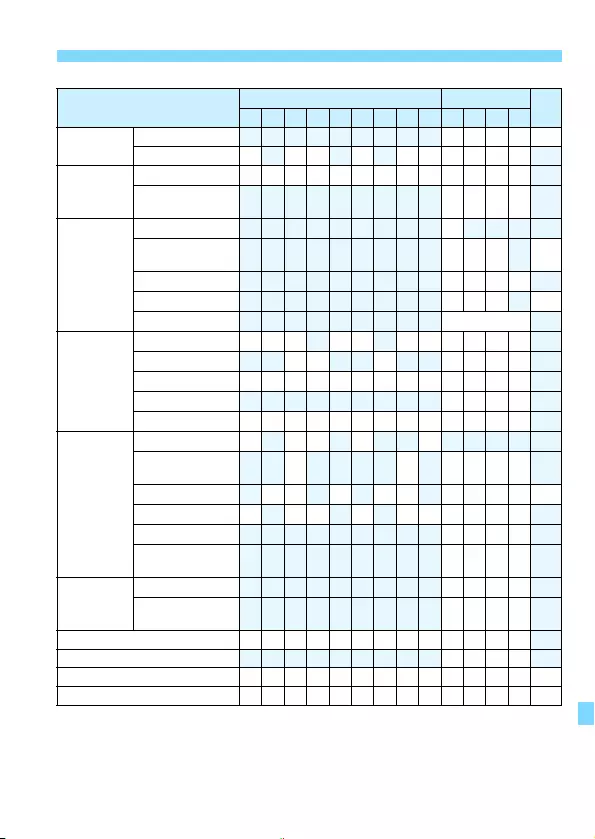
277
Function Availability Table by Shooting Mode
*3:
When an external Speedlite is used, it will emit the AF-assist beam when necessary.
*4: If the AF method is <f> during Live View shooting, the external Speedlite
will emit the AF-assist beam when necessary.
*5: Settable only during Live View shooting.
*6: Settable only for autoexposures.
Mode Dial Basic Zone Creative Zone k
A 7 C2 3 4 5 P 6 d s f a
AF AF point selection kkkk
f
AF-assist beam ooo *3 o*4 ookkkk
Metering
mode
Evaluative metering
oooooooookkkk
Metering mode
selection kkkk
Exposure
Program shift k
Exposure
compensation kkk k*6
AEB kkkk
AE lock kkk k*6
Depth-of-field preview
k (C.Fn-9-4)
Drive/
self-timer
Single shooting kkk kk kkkkkk
Continuous shooting
kk kkkkk
j (10 sec.) kkkkkkkkkkkkk
l (2 sec.) kkkk
q (Continuous) kkkkkkkkkkkkk
Built-in
flash
Automatic firing oko o o
Flash on (Fires at
all times) k k kkkk
Flash off ok ook kkkk o
Red-eye reduction kkk kkkkkkk
FE lock kkkk
Flash exposure
compensation kkkk
External
flash
Function settings kkkk
Custom Function
settings kkkk
Live View shooting kkkkkkkkkkkkk
Aspect ratio*5 kkkk
Quick Control kkkkkkkkkkkkk k
Feature guide kkkkkkkkkkkkk k
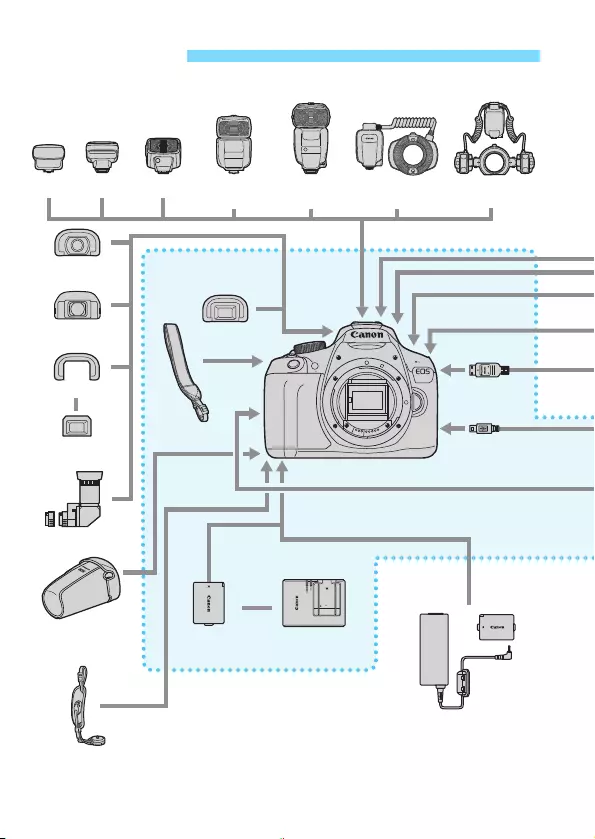
278
System Map
Bundled
Accessories
270EX IIST-E2
ST-E3-RT
Macro Twin Lite
MT-24EX
Macro Ring Lite
MR-14EX II
Battery Pack
LP-E10
Battery Charger
LC-E10 or LC-E10E
Strap
Eyecup Ef
Compact Power
Adapter
CA-PS700
*1
DC Coupler
DR-E10*1
600EX-RT/
600EX
430EX III-RT/
430EX III
Eyepiece Extender
EP-EX15
II
Rubber Frame Ef
E-series Dioptric
Adjustment Lenses
Angle Finder C
Hand Strap E2
Semi Hard Case
EH26-L/EH27-L
Magnifier
MG-Ef
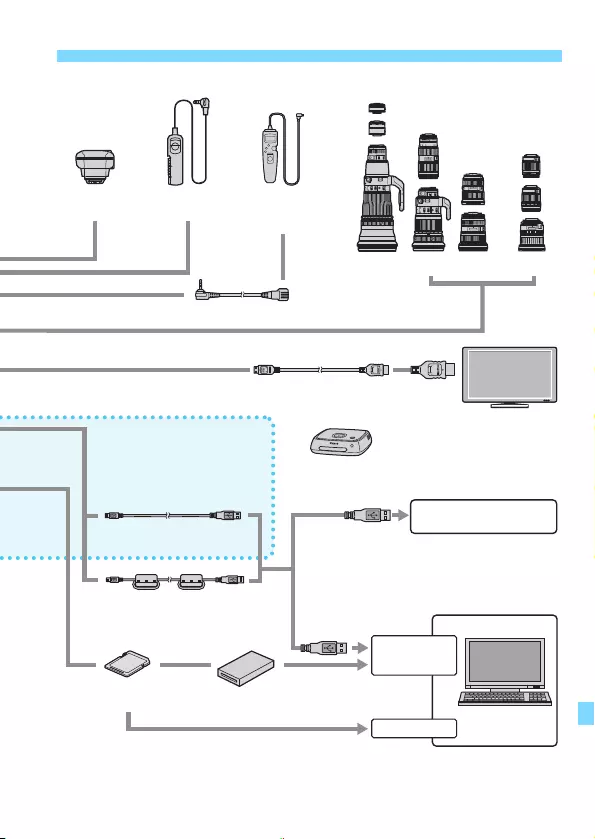
279
System Map
SD/SDHC/SDXC
memory card Card reader
Interface Cable
(1.3 m/4.3 ft.)
Interface Cable IFC-200U/500U
(1.9 m/6.2 ft.) / (4.7 m/15.4 ft.)
PictBridge-compatible printer
HDMI Cable
HTC-100 (2.9 m/9.5 ft.)
TV set/Video
EF lenses EF-S lenses
Remote Switch
RS-60E3
GPS Receiver
GP-E2
*2
*1: AC Adapter Kit ACK-E10 can also be used.
*2: When using the GP-E2 with this camera, connect it to the camera with the cable provided
with the GP-E2.
* All cable lengths given are approximate figures.
Remote Controller Adapter RA-E3
Connect Station
CS100
Timer Remote
Controller
TC-80N3
Card slot
USB port
Computer
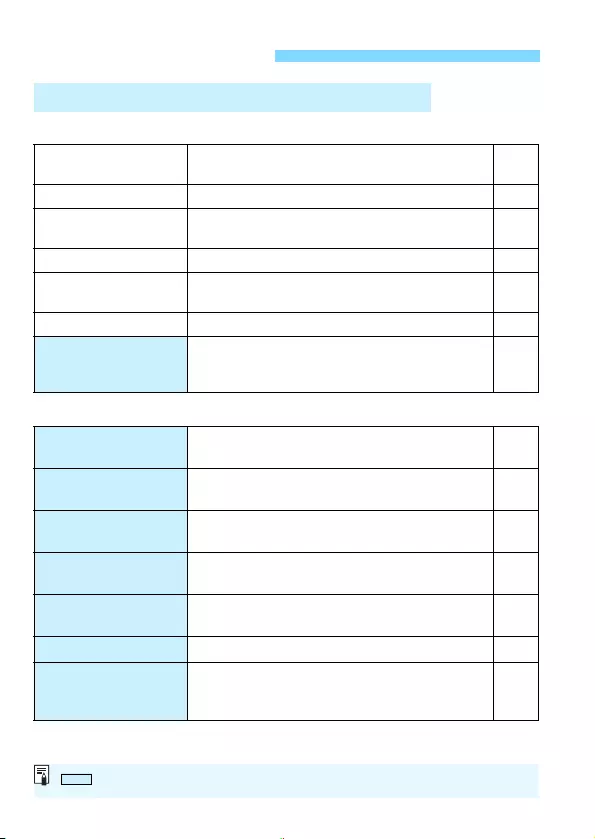
280
J Shooting 1 (Red) Page
K Shooting 2 (Red)
3 Menu Settings
Viewfinder Shooting and Live View Shooting
Image quality 73 / 83 / 74 / 84 / 7a / 8a / b / c /
1+73 / 188
Beep Enable / Disable 184
Release shutter
without card Enable / Disable 184
Image review Off / 2 sec. / 4 sec. / 8 sec. / Hold 184
Peripheral illumination
correction
Enable / Disable 124
Red-eye reduction Disable / Enable 106
Flash control
Flash firing / Built-in flash function setting /
External flash function setting / External flash
C.Fn setting / Clear external flash C.Fn setting
198
Exposure
compensation/AEB
1/3-stop or 1/2-stop increments, ±5 stops
(AEB: ±2 stops) 118
Auto Lighting
Optimizer Disable / Low / Standard / High 123
Metering mode Evaluative metering / Partial metering /
Center-weighted average metering 115
Custom White
Balance Manual setting of white balance 133
White balance shift/
bracketing
WB correction: White balance correction
BKT setting: White balance bracketing
135
136
Color space sRGB / Adobe RGB 137
Picture Style
DAuto / PStandard / QPortrait /
RLandscape / SNeutral / UFaithful /
VMonochrome / WUser Def. 1-3
95
126
129
Shaded menu options are not displayed in Basic Zone modes.
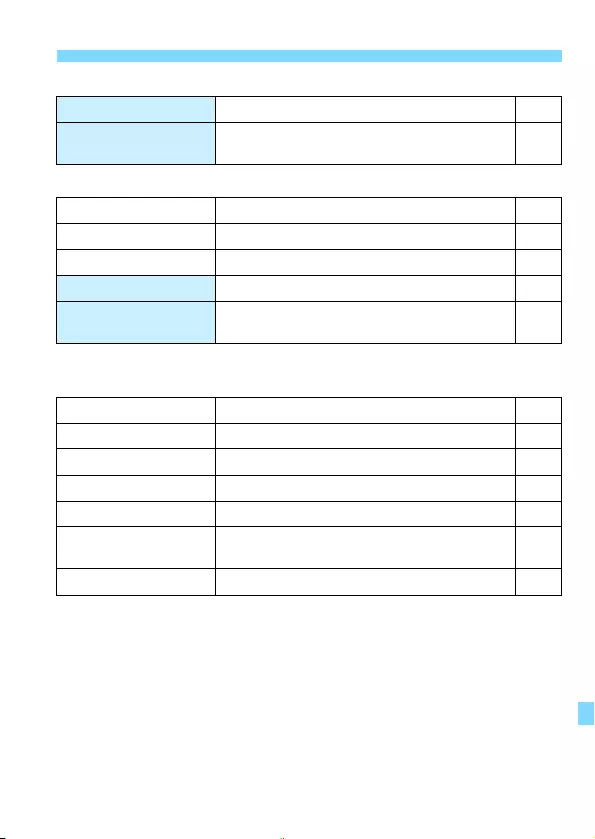
281
3 Menu Settings
L Shooting 3 (Red) Page
M Shooting 4* (Red)
* In Basic Zone modes, these menu options are displayed under the [z2] tab.
1 Playback 1 (Blue)
Dust Delete Data Obtains data to be used to erase dust spots 202
ISO Auto Max.:400 / Max.:800 / Max.:1600 / Max.:3200 /
Max.:6400 94
Live View shooting Enable / Disable 141
AF method FlexiZone - Single / uLive mode / Quick mode 148
Grid display Off / Grid 1l / Grid 2m145
Aspect ratio 3:2 / 4:3 / 16:9 / 1:1 146
Metering timer 4 sec. / 8 sec. / 16 sec. / 30 sec. / 1 min. /
10 min. / 30 min. 147
Protect images Protect images 228
Rotate image Rotate images 211
Erase images Erase images 230
Print order Specify images to be printed (DPOF) 251
Photobook Set-up Specify images for a photobook 255
Creative filters Grainy B/W / Soft focus / Fish-eye effect /
Toy camera effect / Miniature effect 236
Resize Downsize JPEG image’s pixel count 239
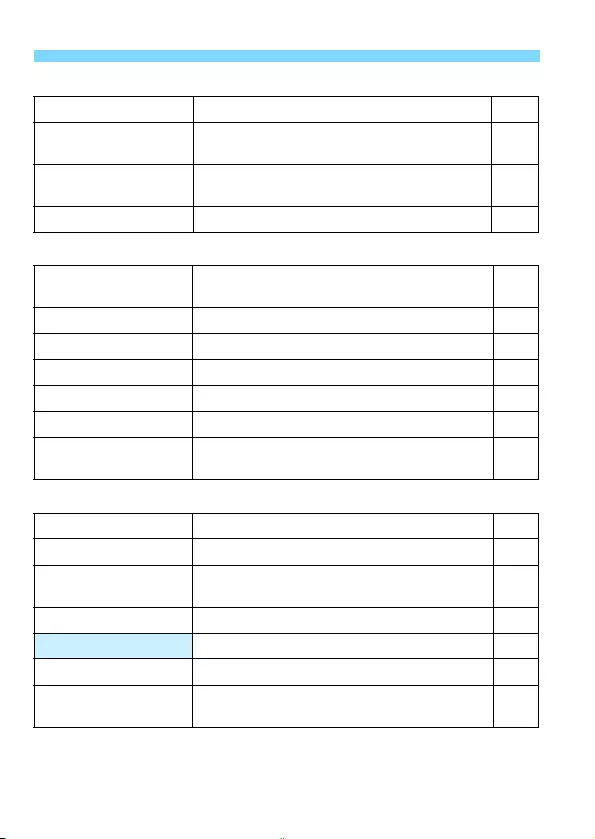
3 Menu Settings
282
2 Playback 2 (Blue) Page
4 Set-up 1 (Yellow)
6 Set-up 2 (Yellow)
Histogram display Brightness / RGB 234
Image jump w/61 image / 10 images / 100 images / Date /
Folder / Movies / Stills / Rating 209
Slide show Playback description / Display time / Repeat /
Transition effect / Background music 222
Rating [OFF] / l / m / n / o / p212
Auto power off 30 sec. / 1 min. / 2 min. / 4 min. / 8 min. /
15 min. / Disable 185
Auto rotate OnzD / OnD / Off 192
Format card Initialize and erase data on the card 52
File number Continuous / Auto reset / Manual reset 188
Select folder Create and select a folder 186
Screen color Select the shooting settings screen color 197
Eye-Fi settings Displayed when a commercially-available
Eye-Fi card is inserted 274
LCD brightness Adjust the brightness (seven levels) 185
LCD off/on button Shutter button / Shutter/DISP / Remains on 197
Date/Time/Zone Date (year, month, day) / Time (hour, min.,
sec.) / Daylight saving time / Time zone 41
LanguageKSelect the interface language 43
Clean manually Clean image sensor manually 204
Feature guide Enable / Disable 55
GPS device settings Settings available when the GPS Receiver
GP-E2 (sold separately) is attached 283
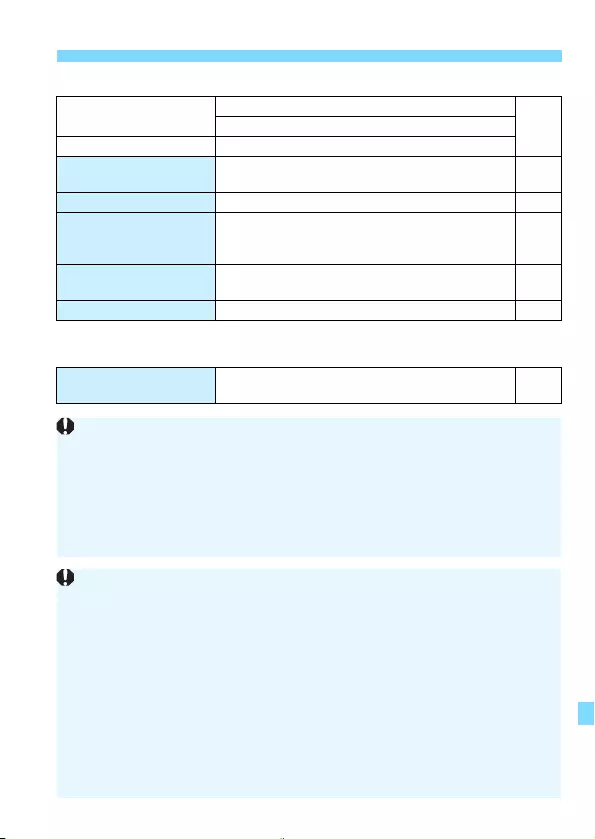
283
3 Menu Settings
7 Set-up 3 (Yellow) Page
* For details, refer to the Wireless Function Instruction Manual.
9 My Menu (Green)
Wi-Fi/NFC Disable / Enable
-*Allow NFC connections
Wi-Fi function
Connect to smartphone / Upload to Web service
Certification Logo
Display
Displays some of the logos of the camera’s
certifications 269
Custom Functions (C.Fn )
Customize camera functions as desired 258
Copyright information
Display copyright information /
Enter author’s name / Enter copyright details /
Delete copyright information
190
Clear settings Clear all camera settings / Clear all Custom
Func. (C.Fn) 194
Firmware Ver. For updating the firmware -
My Menu settings Register frequently-used menu options and
Custom Functions 267
When using Wi-Fi function, be sure to check the countries and areas of
use, and use the device in accordance with the laws and regulations of
the country or region.
[Wi-Fi/NFC] cannot be set if the camera is connected to a computer,
printer, GPS receiver, TV set, or other device with a cable. When [Wi-Fi/
NFC] is set to [Enable], you cannot connect the camera to the above
devices with a cable.
Cautions for Using GPS Receiver GP-E2 (sold separately)
Check if your country or area allows the use of GPS and follow any legal
regulations.
When using the GP-E2 with the camera, connect it to the camera with the
cable that came with the GP-E2. If you do not use the provided cable, the
geotag information will not be appended to the image when you shoot.
Certain functions of the GP-E2 will not work with this camera. Note the following:
• The shooting direction is not recorded. (The electronic compass cannot
be used.)
• The geotag information can be appended to a movie when the
shooting starts. However, the location will not be displayed on Map
Utility (EOS software). Check the location with the camera.

3 Menu Settings
284
a Movie 1 (Red) Page
c Movie 2 (Red)
k Movie Shooting
Movie exposure Auto / Manual 176
AF method FlexiZone - Single / uLive mode /
Quick mode 176
AF with shutter button
during movie recording Disable / Enable 176
kShutter button/
AE lock button
AF/AE lock / AE lock/AF /
AF/AF lock, no AE lock /
AE/AF, no AE lock
177
kHighlight tone
priority Disable / Enable 177
Movie recording size 1920x1080 (6/5/4) / 1280x720 (8/7) /
640x480 (6/5)168
Sound recording
Sound recording: Auto / Manual / Disable
178Recording level
Wind filter: Disable/ Enable
Metering timer 4 sec. / 8 sec. / 16 sec. / 30 sec. / 1 min. /
10 min. / 30 min. 179
Grid display Off / Grid 1l / Grid 2m179
Video snapshot Disable / 2 sec. movie / 4 sec. movie /
8 sec. movie 170
Video system NTSC / PAL 179

285
3 Menu Settings
d Movie 3(Red) Page
Exposure
compensation 1/3-stop increments, ±3 stops 180
Auto Lighting
Optimizer Disable / Low / Standard / High 180
Custom White Balance Manual setting of white balance 180
Picture Style
DAuto / PStandard / QPortrait /
RLandscape / SNeutral / UFaithful /
VMonochrome / WUser Def. 1-3
180
Menus for Movie Shooting Mode
The [k1], [k2], and [k3] tabs appear only in the movie shooting
mode.
The [z2], [z3], [z4], and [9] tabs do not appear.
The following menu items do not appear:
•[z1]: Red-eye reduction, Flash control
•[51]: Screen color
•[52]: LCD off/on button, Clean manually
•[53]: Certification Logo Display, Custom Functions (C.Fn), Copyright
information, Clear settings, Firmware Ver.

286
If a problem occurs with the camera, first consult this Troubleshooting
Guide. If this Troubleshooting Guide does not resolve the problem,
contact your dealer or nearest Canon Service Center.
Do not use any battery other than a genuine Canon Battery Pack
LP-E10.
If the battery charger has a problem, the protection circuit will stop the
charging and the charge lamp will blink in orange. If this happens,
unplug the charger’s power plug from the power outlet and detach the
battery. Attach the battery to the charger again and wait a while before
connecting the charger to a power outlet again. If the problem persists,
contact your dealer or nearest Canon Service Center.
Make sure the battery is properly installed in the camera (p.36).
Make sure the card slot/battery compartment cover is closed (p.36).
Recharge the battery (p.34).
Press the <B> button (p.54).
If the power is turned off while an image is being recorded to the card,
the access lamp will remain on/continue to blink for a few seconds.
When the image recording is completed, the power will turn off
automatically.
Troubleshooting Guide
Power-Related Problems
The battery does not recharge.
The battery charger’s lamp blinks.
The camera does not operate even when the power
switch is set to <1>.
The access lamp still lights or blinks even when the
power switch is <2>.

287
Troubleshooting Guide
Use a fully-charged battery (p.34).
The rechargeable battery performance will degrade over repeated
use. Purchase a new one.
The number of possible shots will decrease with any of the following
operations:
• Pressing the shutter button halfway for a prolonged period.
• Activating the AF frequently without taking a picture.
• Using the lens’s Image Stabilizer.
• Using the LCD monitor frequently.
• Continuing Live View shooting or movie shooting for a prolonged
period.
• The Eye-Fi card’s communication function is operating.
Auto power off is in effect. If you do not want auto power off to take
effect, set [51: Auto power off] to [Disable] (p.185).
Even if [51: Auto power off] is set to [Disable], the LCD monitor will
still turn off after the camera is left idle for approx. 30 min. (The
camera’s power does not turn off.) Press the <B> button to turn on
the LCD monitor.
The camera cannot be used with EF-M lenses (p.44).
The battery becomes exhausted quickly.
The camera turns off by itself.
Shooting-Related Problems
The lens cannot be attached.

Troubleshooting Guide
288
Make sure the card is properly inserted (p.36).
Slide the card’s write-protect switch to the write/erase position (p.36).
If the card is full, replace the card or delete unnecessary images to
make space (p.36, 230).
If you try to focus in the One-Shot AF mode and the focus indicator
<o> in the viewfinder blinks, a picture cannot be taken. Press the
shutter button halfway again to refocus automatically, or focus
manually (p.47, 101).
If a card error message is displayed, see page 38 or 298.
Set the lens’s focus mode switch to <AF> (p.44).
Press the shutter button gently to prevent camera shake (p.46-47).
If the lens has an Image Stabilizer, set the IS switch to <1>.
In low light, the shutter speed may become slow. Use a faster shutter
speed (p.108), set a higher ISO speed (p.92), use flash (p.104), or use
a tripod.
Set the AF operation to One-Shot AF. Focus lock is not possible in the
AI Servo AF mode, or when servo takes effect in AI Focus AF mode
(p.97).
No images can be shot or recorded.
The card cannot be used.
The image is out of focus.
I cannot lock the focus and recompose the shot.

289
Troubleshooting Guide
Horizontal stripes (noise) or irregular exposures can be caused by
fluorescent lighting, LED lighting, or other light sources during
viewfinder or Live View shooting. Also, the exposure or color tone may
not come out right. A slow shutter speed may solve the problem.
During viewfinder shooting or Live View shooting, if you use a TS-E
lens (except the TS-E17mm f/4L or TS-E24mm f/3.5L II) and shift or tilt
the lens or use an Extension Tube, the standard exposure may not be
obtained or the exposure may be irregular.
Depending on the lens type, shutter speed, aperture, subject
conditions, brightness, etc., the continuous shooting speed may
become slower.
Under [53: Custom Functions (C.Fn)], set [5: High ISO speed
noise reduct’n] to [0: Standard], [1: Low], or [3: Disable]. If it is set to
[2: Strong], the maximum burst during continuous shooting will greatly
decrease (p.263).
During WB bracketing, the maximum burst for continuous shooting will
decrease (p.136).
If you shoot something that has fine detail such as a field of grass, the
file size will be larger, and the actual maximum burst may be lower
than the number mentioned on page 89.
Horizontal stripes appear, or the exposure
or color tone look strange.
The standard exposure cannot be obtained or the
exposure is irregular.
The continuous shooting speed is slow.
The maximum burst during continuous shooting is lower.

Troubleshooting Guide
290
Under [53: Custom Functions (C.Fn)], if [6: Highlight tone priority]
is set to [1: Enable], ISO 100 cannot be set. If [0: Disable] is set, ISO
100 can be set (p.263). This also applies to movie shooting (p.177).
Under [53: Custom Functions (C.Fn)], if [6: Highlight tone priority]
is set to [1: Enable], the [H] ISO speed (equivalent to ISO 12800)
cannot be selected even when [2: ISO expansion] is set to [1: On]. If
[0: Disable] is set for [6: Highlight tone priority], [H] can be set
(p.263).
Under [53: Custom Functions (C.Fn)], if [6: Highlight tone priority]
is set to [1: Enable], the Auto Lighting Optimizer cannot be set. If [0:
Disable] is set, the Auto Lighting Optimizer can be set (p.263).
Set [z2: Auto Lighting Optimizer] to [Disable]. When [Low],
[Standard], or [High] is set, even if you set a decreased exposure
compensation or flash exposure compensation, the image may come
out bright (p.123).
ISO 100 cannot be set.
ISO speed [H] (equivalent to ISO 12800) cannot be set.
The Auto Lighting Optimizer cannot be set.
Even though I set a decreased exposure compensation,
the image comes out bright.

291
Troubleshooting Guide
If you shoot at night when the background is dark, the shutter speed
automatically becomes slow (slow-sync shooting) so that both the
subject and background are properly exposed. To prevent a slow
shutter speed, under [53: Custom Functions (C.Fn)], set [3: Flash
sync. speed in Av mode] to [1: 1/200-1/60sec. auto] or [2: 1/200sec.
(fixed)] (p.261).
In shooting modes (<A> <C> <2> <4> <6>) whose default
setting is <a> (built-in flash auto firing), the built-in flash will be raised
automatically when necessary.
If you use the built-in flash too often in too short a period of time, the
flash may stop firing for a while to protect the light-emitting unit.
If you use a flash unit other than an EX-series Speedlite, the flash will
always be fired at full output (p.273).
Under [z1: Flash control], if [Flash metering mode] in [External
flash C.Fn setting] is set to [TTL], the flash will always fire at full
output (p.201).
If flash exposure compensation is set with the external Speedlite, flash
exposure compensation cannot be set with the camera. When the
external Speedlite’s flash exposure compensation is canceled (set to
0), flash exposure compensation can be set with the camera.
When I use the <f> mode with flash, the shutter
speed becomes slow.
The built-in flash rises by itself.
The built-in flash does not fire.
The external flash always fires at full output.
Flash exposure compensation cannot be set for
the external Speedlite.

Troubleshooting Guide
292
Under [53: Custom Functions (C.Fn)], set [3: Flash sync. speed in
Av mode] to [0: Auto] (p.261).
The built-in flash’s pop-up mechanism moves slightly. This is normal
and not a malfunction.
If you use flash, the shutter will make two sounds each time you shoot
(p.141).
It indicates that the camera’s internal temperature is high. If the white
<s> icon is displayed, the still photo’s image quality may deteriorate.
If the red <E> icon is displayed, it indicates that the Live View
shooting will soon stop automatically (p.157).
It indicates that the camera’s internal temperature is high. If the red
<E> icon is displayed, it indicates that the movie shooting will soon
stop automatically (p.181).
If the card’s writing speed is slow, movie shooting may stop
automatically. Use an SD Speed Class 6 “ ” or faster card. To
find out the card’s reading/writing speed, refer to the card
manufacturer’s Web site, etc.
If a movie clip’s file size reaches 4 GB or the shooting length reaches
29 min. 59 sec., the movie shooting will stop automatically.
High-speed sync cannot be set in the <f> mode.
The camera makes a noise when it is shaken.
The shutter makes two shooting sounds during Live View shooting.
During Live View shooting, a white <s> or red
<E> icon is displayed.
During movie shooting, a red E icon is displayed.
Movie shooting stops by itself.

293
Troubleshooting Guide
If [k1: Movie exposure] is set to [Auto], the ISO speed will be set
automatically. If [Manual] is set, you can set the ISO speed manually
(p.162).
If you change the shutter speed or aperture during movie shooting, the
changes in the exposure may be recorded.
Zooming the lens during movie shooting can cause changes in the
exposure regardless of whether the lens’s maximum aperture changes
or not. The changes in the exposure may be recorded as a result.
If you move the camera to the left or right quickly (high-speed panning)
or shoot a moving subject, the image may look distorted.
Flickering, horizontal stripes (noise), or irregular exposures can be
caused by fluorescent lighting, LED lighting, or other light sources
during movie shooting. Also, changes in the exposure (brightness) or
color tone may be recorded. With manual exposure, a slow shutter
speed may solve the problem.
If the camera is connected to a computer, printer, GPS receiver, TV
set, or other device with a cable, Wi-Fi cannot be set ([53: Wi-Fi/NFC]
will be grayed out). Disconnect the cable before changing any settings.
Refer to the Wireless Function Instruction Manual.
The ISO speed cannot be set for movie shooting.
The exposure changes during movie shooting.
The subject looks distorted during movie shooting.
The image flickers or horizontal stripes appear during movie shooting.
Wireless Functions
Wi-Fi cannot be set.

Troubleshooting Guide
294
In Basic Zone modes and in movie shooting mode, certain tabs and
menu options are not displayed. Set the shooting mode to a Creative
Zone mode (p.50).
Set the color space to sRGB. If Adobe RGB is set, the first character
will be an underscore (p.137).
It is a movie file (p.189).
If the card already contains recorded images, the image number may
not start from 0001 (p.188).
Check that the correct date and time are set (p.41).
Check the time zone and daylight saving time (p.41).
The shooting date and time do not appear in the picture. The date and
time are instead recorded in the image data as shooting information.
When printing, you can imprint the date and time in the picture, using
the date and time recorded in the shooting information (p.247).
If the number of images recorded on the card exceeds the number the
camera can display, [###] will be displayed (p.213).
Display Problems
The menu screen shows fewer tabs and options.
The file name’s first character is an underscore (“_”).
The file name starts with “MVI_”.
The file numbering does not start from 0001.
The shooting date and time displayed is incorrect.
The date and time are not in the picture.
[###] is displayed.

295
Troubleshooting Guide
If the LCD monitor is dirty, use a soft cloth to clean it.
In low or high temperatures, the LCD monitor display may seem slow
or may look black. It will return to normal at room temperature.
[Eye-Fi settings] will appear only when an Eye-Fi card is inserted in
the camera. If the Eye-Fi card has a write-protect switch set to the
LOCK position, you will not be able to check the card’s connection
status or disable Eye-Fi transmission (p.274).
It is the highlight alert (p.234). Overexposed areas with clipped
highlight will blink.
If the image is protected, it cannot be erased (p.228).
Movies edited with a computer cannot be played back with the
camera.
If you operate the camera’s dials or lens during movie shooting, the
operation sound will also be recorded.
The LCD monitor does not display a clear image.
[Eye-Fi settings] does not appear.
Playback Problems
Part of the image blinks in black.
The image cannot be erased.
The movie cannot be played back.
Camera operation sound can be heard when the movie
is played back.

Troubleshooting Guide
296
During autoexposure movie shooting, if there is a drastic change in the
exposure level, the recording will stop momentarily until the brightness
stabilizes. In such cases, shoot movies with manual exposure (p.162).
An HDMI cable (sold separately) is necessary to connect the camera
to a TV set. Using the HDMI Cable HTC-100 (sold separately) is
recommended (p.226).
Also check that your TV set has an HDMI IN terminal. If the TV set
does not have an HDMI IN terminal and has only an A/V IN jack, the
camera cannot be connected.
Check that the HDMI cable’s plug is inserted all the way in (p.226).
If [53: Wi-Fi/NFC] is set to [Enable], the camera cannot be connected
to a TV set. Set [Wi-Fi/NFC] to [Disable], then reconnect the camera
to the TV set with an HDMI cable.
Depending on the card reader and computer OS used, SDXC cards
may not be correctly recognized. In such a case, connect your camera
to the computer with the interface cable, then transfer the images to
your computer using EOS Utility (EOS software, p.314).
JPEG c and RAW images cannot be resized with the camera
(p.239).
The movie has still moments.
I cannot connect the camera to my TV set.
No picture on the TV set.
My card reader does not recognize the card.
I cannot resize the image.

297
Troubleshooting Guide
If [53: Wi-Fi/NFC] is set to [Enable], the camera cannot be connected
to a printer. Set [Wi-Fi/NFC] to [Disable], then reconnect the camera
to a printer with an interface cable.
Contents displayed on the screen vary depending on the printer. This
instruction manual lists all the printing effects available (p.246).
Install the EOS software on the computer (p.315).
If [53: Wi-Fi/NFC] is set to [Enable], the camera cannot be connected
to a computer. Set [Wi-Fi/NFC] to [Disable], then reconnect the
camera to a computer with an interface cable.
Printing-Related Problems
I cannot connect the camera to my printer.
There are fewer printing effects than listed
in the instruction manual.
Computer Connection Problems
I cannot download images to a computer.
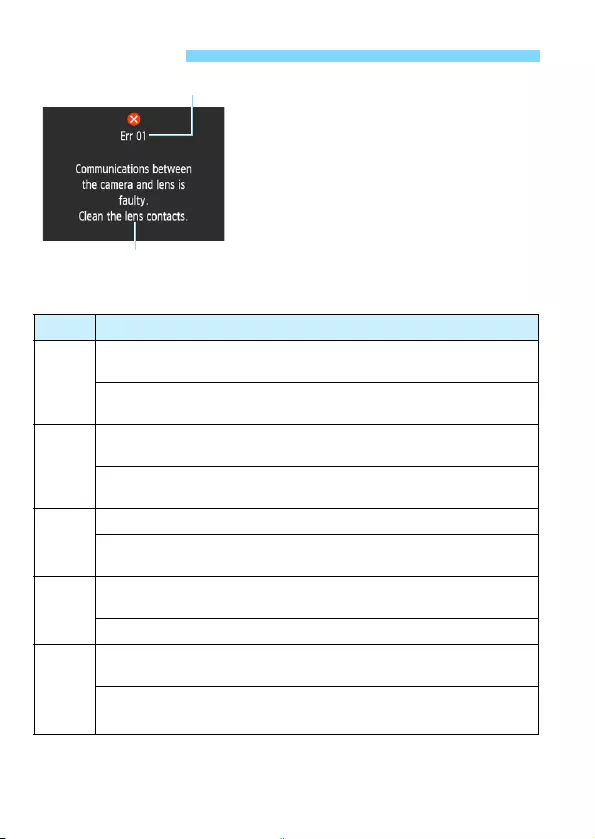
298
If there is a problem with the camera, an
error message will appear. Follow the on-
screen instructions.
* If the error still persists, write down the error number and contact your
nearest Canon Service Center.
Error Codes
Number Error Message and Solution
01
Communications between the camera and lens is faulty. Clean the
lens contacts.
Clean the electrical contacts on the camera and lens or use a
Canon lens (p.25, 26).
02
Card cannot be accessed. Reinsert/change card or format card
with camera.
Remove and insert the card again, replace the card, or format the
card (p.36, 52).
04
Cannot save images because card is full. Replace card.
Replace the card, erase unnecessary images, or format the card
(p.36, 52, 230).
05
The built-in flash could not be raised. Turn the camera off and on
again.
Operate the power switch (p.39).
10, 20
30, 40
50, 60
70, 80
99
An error prevented shooting. Turn the camera off and on again or
re-install the battery.
Operate the power switch, remove and install the battery again, or
use a Canon lens (p.36, 39).
Error number
Cause and countermeasures

299
•Type
Type: Digital, single-lens reflex, AF/AE camera with built-in
flash
Recording media:
SD memory card, SDHC memory card, SDXC memory card
Image sensor size: Approx. 22.3 x 14.9 mm
Compatible lenses: Canon EF lenses (including EF-S lenses)
* Excluding EF-M lenses
(35mm-equivalent angle of view is that of a lens with
approx. 1.6x the focal length indicated.)
Lens mount: Canon EF mount
• Image Sensor
Type: CMOS sensor
Effective pixels: Approx. 18.0 megapixels
Aspect ratio: 3:2
Dust delete feature: Dust Delete Data appending, Clean manually
• Recording System
Recording format: Design rule for Camera File System (DCF) 2.0
Image type: JPEG, RAW (14-bit Canon original)
RAW+JPEG Large simultaneous recording possible
Pixels recorded: L (Large) : Approx. 17.9 megapixels (5184 x 3456)
M (Medium) : Approx. 8.0 megapixels (3456 x 2304)
S1 (Small 1) : Approx. 4.5 megapixels (2592 x 1728)
S2 (Small 2) : Approx. 2.5 megapixels (1920 x 1280)
S3 (Small 3) : Approx. 350,000 pixels (720 x 480)
RAW : Approx. 17.9 megapixels (5184 x 3456)
Create/select a folder: Possible
File numbering: Continuous, Auto reset, Manual reset
• Image Processing During Shooting
Picture Style: Auto, Standard, Portrait, Landscape, Neutral, Faithful,
Monochrome, User Def. 1 - 3
Basic+: Ambience-based shots, Light/scene-based shots
White balance: Auto (Ambience priority), Auto (White priority), Preset
(Daylight, Shade, Cloudy, Tungsten light, White
fluorescent light, Flash), Custom
White balance correction, and White balance bracketing
provided
* Flash color temperature information transmission
enabled
Specifications

300
Specifications
Noise reduction: Applicable to long exposures and high ISO speed shots
Automatic image
brightness correction:
Auto Lighting Optimizer
Highlight tone priority: Provided
Lens peripheral
illumination correction:
Provided
• Viewfinder
Type: Eye-level pentamirror
Coverage: Vertical/Horizontal approx. 95% (with eyepoint approx.
21 mm)
Magnification: Approx. 0.8x (-1 m-1 with 50mm lens at infinity)
Eye point: Approx. 21 mm (from eyepiece lens center at -1 m-1)
Diopric adjustment
range:
Approx. -2.5 - +0.5 m-1 (dpt)
Focusing screen: Fixed, Precision Matte
Mirror: Quick-return type
Depth-of-field preview: Enabled with Custom Function setting
• Autofocus (for viewfinder shooting)
Type: TTL secondary image-registration, phase-difference
detection
AF points: 9-point (Cross-type AF sensitive to f/5.6 with center AF
point)
Focusing brightness
range:
EV 0 - 18 (Center AF point)
EV 1 - 18 (Other AF points)
(With One-Shot AF, at room temperature, ISO 100)
AF operation: One-Shot AF, AI Servo AF, AI Focus AF
AF-assist beam: Small series of flashes fired by built-in flash
• Exposure Control
Metering modes: 63-zone TTL open-aperture metering
• Evaluative metering (linked to all AF points)
• Partial metering (approx. 10% of viewfinder at center)
• Center-weighted average metering
Metering brightness
range:
EV 1 - 20 (at room temperature, ISO 100)
Shooting mode: Basic Zone modes:
Scene Intelligent Auto, Flash Off, Creative Auto, Portrait,
Landscape, Close-up, Sports, Food, Night Portrait
Creative Zone modes:
Program AE, Shutter-priority AE, Aperture-priority AE,
Manual exposure

301
Specifications
ISO speed
(Recommended
exposure index):
Basic Zone modes*: ISO 100 - ISO 3200 set automatically
* Portrait: ISO 100
Creative Zone modes: ISO 100 - ISO 6400 set manually
(whole-stop increments), ISO 100 - ISO 6400 set
automatically, maximum ISO speed settable for ISO
Auto, or ISO expansion to “H” (equivalent to ISO 12800)
Exposure
compensation:
Manual: ±5 stops in 1/3- or 1/2-stop increments
AEB: ±2 stops in 1/3- or 1/2-stop increments (can be
combined with manual exposure compensation)
AE lock: Auto: Applied in One-Shot AF with evaluative
metering when focus is achieved
Manual: With AE lock button
•Shutter
Type: Electronically-controlled, focal-plane shutter
Shutter speed: 1/4000 sec. to 30 sec. (Total shutter speed range.
Available range varies by shooting mode.), Bulb, X-sync
at 1/200 sec.
•Flash
Built-in flash: Retractable, auto pop-up flash
Guide No.: Approx. 9.2/30.2 (ISO 100, in meters/feet) or
approx. 13/42.7 (ISO 200, in meters/feet)
Flash coverage: Approx. 17mm lens angle of view
Recharge time: Approx. 2 sec.
External flash: EX-series Speedlite
Flash metering: E-TTL II autoflash
Flash exposure
compensation:
±2 stops in 1/3- or 1/2-stop increments
FE lock: Provided
PC terminal: None
• Drive System
Drive modes: Single shooting, Continuous shooting, Self-timer with 10-
sec. or 2-sec. delay and 10-sec. delay with continuous
shooting
Continuous shooting
speed:
Max. approx. 3.0 shots/sec.
Max. burst (Approx.): JPEG Large/Fine: 1110 shots
RAW: 6 shots
RAW+JPEG Large/Fine: 5 shots
* Figures are based on Canon’s testing standards (ISO
100 and Standard Picture Style) using an 8 GB card.

302
Specifications
• Live View Shooting
Aspect ratio: 3:2, 4:3, 16:9, 1:1
Focus methods: Contrast detection (FlexiZone-Single, Face detection
Live mode), Phase-difference detection (Quick mode)
Manual focus (approx. 5x / 10x magnification possible)
Focusing brightness range:
EV 1 - 18 (at room temperature, ISO 100)
Metering mode: Real-time metering with image sensor
Metering brightness
range:
EV 0 - 20 (at room temperature, ISO 100)
Grid display: Two types
• Movie Shooting
Recording format: MOV
Movie: MPEG-4 AVC/H.264
Variable (average) bit rate
Audio: Linear PCM
Recording size and
frame rate:
1920x1080 (Full HD): 30p/25p/24p
1280x720 (HD) : 60p/50p
640x480 (SD) : 30p/25p
* 30p: 29.97 fps, 25p: 25.00 fps, 24p: 23.98 fps,
60p: 59.94 fps, 50p: 50.00 fps
Bit rate: 1920x1080 (30p/25p/24p): Approx. 46 Mbps
1280x720 (60p/50p) : Approx. 46 Mbps
640x480 (30p/25p) : Approx. 11 Mbps
Focus method: Same as focusing with Live View shooting
Focusing brightness range:
EV 1 - 18 (at room temperature, ISO 100)
Metering mode: Center-weighted average and evaluative metering with
the image sensor
* Automatically set by the focus method.
Metering brightness
range:
EV 0 - 20 (at room temperature, ISO 100)
Exposure control: Autoexposure and manual exposure
Exposure compensation:
±3 stops in 1/3-stop increments
ISO speed
(Recommended
exposure index):
With autoexposure shooting:
ISO 100 - ISO 6400 set automatically
With manual exposure:
ISO 100 - ISO 6400 set automatically/manually
Video snapshots: Settable to 2 sec./4 sec./8 sec.
Sound recording: Built-in monaural microphone
Sound-recording level adjustable, wind filter provided
Grid display: Two types
Still photo shooting: Not possible during movie shooting

303
Specifications
•LCD Monitor
Type: TFT color liquid-crystal monitor
Monitor size and dots: Approx. 7.5 cm (3.0 in.) (4:3) with approx. 920,000 dots
Brightness adjustment: Manual (7 levels)
Interface languages: 25
Feature guide: Displayable
•Playback
Image display format: Basic info, basic info + image quality/playback number,
shooting info. display, histogram, index display (4/9)
Zoom magnification: Approx. 1.5x - 10x
Highlight alert: Overexposed highlights blink
Image browsing
method:
Single image, jump by 10 or 100 images, by shooting
date, by folder, by movies, by stills, by rating
Image rotation: Possible
Ratings: Provided
Movie playback: Enabled (LCD monitor, HDMI)
Built-in speaker
Image protect: Possible
Slide show: All images, by date, by folder, by movies, by stills, by
rating
Five transition effects selectable
Background music: Selectable for slide shows and movie playback
• Post-Processing of Images
Creative filters: Grainy B/W, Soft focus, Fish-eye effect, Toy camera
effect, Miniature effect
Resize: Possible
• Direct Printing
Compatible printers: PictBridge-compatible printers
Printable images: JPEG and RAW images
Print ordering: DPOF Version 1.1 compatible
• Customization Features
Custom Functions: 11
My Menu registration: Possible
Copyright information: Entry and appending possible

304
Specifications
• Interface
Digital terminal: Hi-Speed USB equivalent: Computer communication,
Direct printing, GPS Receiver GP-E2, Connect Station
CS100 connection
HDMI mini OUT
terminal:
Type C (Auto switching of resolution)
Remote control terminal:For Remote Switch RS-60E3
Eye-Fi card: Compatible
•Power
Battery: Battery Pack LP-E10 (Quantity 1)
* AC power can be supplied via household power outlet
accessories.
Number of possible
shots:
(Based on CIPA testing
standards, with 50%
flash use)
With viewfinder shooting:
Approx. 500 shots at room temperature (23°C/73°F),
approx. 410 shots at low temperatures (0°C/32°F)
With Live View shooting:
Approx. 180 shots at room temperature (23°C/73°F),
approx. 170 shots at low temperatures (0°C/32°F)
Movie shooting time: Approx. 1 hr. 15 min. at room temperature (23°C/73°F)
Approx. 1 hr. 10 min. at low temperatures (0°C/32°F)
(with a fully-charged Battery Pack LP-E10)
• Dimensions and Weight
Dimensions (W x H x D):Approx. 129.0 x 101.3 x 77.6 mm / 5.08 x 3.99 x 3.06 in.
Weight: Approx. 485 g / 17.11 oz. (CIPA Guidelines),
Approx. 440 g / 15.52 oz. (Body only)
• Operation Environment
Working temperature
range:
0°C - 40°C / 32°F - 104°F
Working humidity: 85% or less

305
Specifications
• Battery Pack LP-E10
Type: Rechargeable lithium-ion battery
Rated voltage: 7.4 V DC
Battery capacity: 860 mAh
Working temperature
range:
During charging: 6°C - 40°C / 43°F - 104°F
During shooting: 0°C - 40°C / 32°F - 104°F
Working humidity: 85% or less
Dimensions (W x H x D):Approx. 36.2 x 14.7 x 49.0 mm / 1.4 x 0.6 x 1.9 in.
Weight: Approx. 45 g / 1.6 oz.
• Battery Charger LC-E10
Compatible battery: Battery Pack LP-E10
Recharging time: Approx. 2 hours (at room temperature (23°C/73°F))
Rated input: 100 - 240 V AC (50/60 Hz)
Rated output: 8.3 V DC / 580 mA
Working temperature
range:
6°C - 40°C / 43°F - 104°F
Working humidity: 85% or less
Dimensions (W x H x D):Approx. 67.0 x 30.5 x 87.5 mm / 2.6 x 1.2 x 3.4 in.
Weight: Approx. 85 g / 3.0 oz.
• Battery Charger LC-E10E
Compatible battery: Battery Pack LP-E10
Power cord length: Approx. 1 m / 3.3 ft.
Recharging time: Approx. 2 hours (at room temperature (23°C/73°F))
Rated input: 100 - 240 V AC (50/60 Hz)
Rated output: 8.3 V DC / 580 mA
Working temperature
range:
6°C - 40°C / 43°F - 104°F
Working humidity: 85% or less
Dimensions (W x H x D):Approx. 67.0 x 30.5 x 87.5 mm / 2.6 x 1.2 x 3.4 in.
Weight: Approx. 82 g / 2.9 oz. (excluding power cord)
All the data above is based on Canon’s testing standards and CIPA (Camera &
Imaging Products Association) testing standards and guidelines.
Dimensions and weight listed above are based on CIPA Guidelines (except
weight for camera body only).
Product specifications and the exterior are subject to change without notice.
If a problem occurs with a non-Canon lens attached to the camera, consult the
respective lens manufacturer.

306
Trademarks
Adobe is a trademark of Adobe Systems Incorporated.
Microsoft and Windows are trademarks or registered trademarks of Microsoft
Corporation in the United States and/or other countries.
Macintosh and Mac OS are trademarks of Apple Inc., registered in the U.S. and
other countries.
SDXC logo is a trademark of SD-3C, LLC.
HDMI, HDMI logo, and High-Definition Multimedia Interface are trademarks or
registered trademarks of HDMI Licensing LLC.
All other trademarks are the property of their respective owners.
About MPEG-4 Licensing
“This product is licensed under AT&T patents for the MPEG-4 standard and may be
used for encoding MPEG-4 compliant video and/or decoding MPEG-4 compliant video
that was encoded only (1) for a personal and non-commercial purpose or (2) by a
video provider licensed under the AT&T patents to provide MPEG-4 compliant video.
No license is granted or implied for any other use for MPEG-4 standard.”
* Notice displayed in English as required.

307
Use of genuine Canon accessories is recommended
This product is designed to achieve excellent performance when used with
genuine Canon accessories.
Canon shall not be liable for any damage to this product and/or accidents such
as fire, etc., caused by the malfunction of non-genuine Canon accessories
(e.g., a leakage and/or explosion of a battery pack). Please note that this
warranty does not apply to repairs arising out of the malfunction of non-genuine
Canon accessories, although you may request such repairs on a chargeable
basis.

308
Digital Camera Model DS126621 Systems
This device complies with Part 15 of the FCC Rules. Operation is subject to the
following two conditions: (1) This device may not cause harmful interference,
and (2) this device must accept any interference received, including
interference that may cause undesired operation.
Note: This equipment has been tested and found to comply with the limits for
class B digital devices, pursuant to Part 15 of the FCC Rules. These
limits are designed to provide reasonable protection against harmful
interference in a residential installation. This equipment generates, uses
and can radiate radio frequency energy and, if not installed and used in
accordance with the instructions, may cause harmful interference to
radio communications. However, there is no guarantee that interference
will not occur in a particular installation. If this equipment does cause
harmful interference to radio or television reception, which can be
determined by turning the equipment off and on, the user is encouraged
to try to correct the interference by one or more of the following
measures:
— Reorient or relocate the receiving antenna.
— Increase the separation between the equipment and receiver.
— Connect the equipment into an outlet on a circuit different from
that to which the receiver is connected.
— Consult the dealer or an experienced radio/TV technician for help.
The cable with the ferrite core provided with the digital camera must be used
with this equipment in order to comply with Class B limits in Subpart B of Part
15 of the FCC rules.
Do not make any changes or modifications to the equipment unless otherwise
specified in the manual. If such changes or modifications should be made, you
could be required to stop operation of the equipment.
Canon U.S.A. Inc.
One Canon Park, Melville, NY 11747, U.S.A.
Tel No. 1-800-OK-CANON (1-800-652-2666)
CAN ICES-3 (B) / NMB-3 (B)

309
USA and Canada only:
The Lithium ion/polymer battery that powers the product is
recyclable. Please call 1-800-8-BATTERY for information on
how to recycle this battery.
For CA, USA only
Included lithium battery contains Perchlorate Material – special handling may apply.
See www.dtsc.ca.gov/hazardouswaste/perchlorate/ for details.
CAUTION
RISK OF EXPLOSION IF BATTERY IS REPLACED BY AN INCORRECT TYPE.
DISPOSE OF USED BATTERIES ACCORDING TO LOCAL REGULATION.

310
MEMO

311
MEMO

312
MEMO

313
13
Software Start Guide /
Downloading Images to a Computer
This chapter explains the following:
Overview of the software for EOS DIGITAL cameras
How to download and install the software on a computer
How to download and view the Software Instruction
Manuals (PDF files)
How to download images from the camera to a computer

314
This section explains an overview of various software applications for
EOS DIGITAL cameras. Internet connection is required to download
and install the software. Download and installation are not possible in
environments with no Internet connection.
EOS Utility
With the camera connected to a computer, EOS Utility enables you to
transfer still photos and movies shot with the camera to the computer.
You can also use this software to set various camera settings and shoot
remotely from the computer connected to the camera. Also, you can
copy background music tracks, such as EOS Sample Music*, to the
card.
* You can use the background music as the soundtrack for a video snapshot
album, movie, or slide show played back with your camera.
Digital Photo Professional
This software is recommended for users who shoot RAW images. You
can view, edit, and print RAW and JPEG images.
* Some functions differ between the version to be installed on a 64-bit computer
and that to be installed on a 32-bit computer.
Picture Style Editor
You can edit Picture Styles, and create and save original Picture Style
files. This software is aimed at advanced users who are experienced in
processing images.
Software Start Guide
Software Overview

315
Software Start Guide
1Download the software.
Connect to the Internet from a computer and access the following
Canon Web site.
www.canon.com/icpd
Select your country or region of residence and download the
software.
Decompress it on the computer.
For Windows: Click the displayed installer file to start the
installer.
For Macintosh: A dmg file will be created and displayed. Follow
the steps below to start the installer.
(1) Double-click the dmg file.
A drive icon and installer file will appear on the desktop.
If the installer file does not appear, double-click the drive
icon to display it.
(2) Double-click the installer file.
The installer starts.
2Click [Easy Installation] and follow the on-screen
instructions to install.
For Macintosh, click [Install].
Downloading and Installing the Software
Do not connect the camera to your computer before you install the
software. Otherwise, the software will not be installed properly.
Even if a previous version of the software is installed on your computer,
follow the procedure below to install the latest version. (The previous
version will be overwritten.)

316
Internet connection is required to download the Software Instruction
Manuals (PDF files). Download is not possible in environments with no
Internet connection.
1Download the Software Instruction Manuals (PDF files).
Connect to the Internet and access the following Canon Web site.
www.canon.com/icpd
Select your country or region of residence and download the
Instruction Manuals.
2View the Software Instruction Manuals (PDF files).
Double-click a downloaded Instruction Manual (PDF file) to open
it.
To view the Instruction Manuals (PDF files), Adobe Acrobat
Reader DC or other Adobe PDF viewer (most recent version
recommended) is required.
Adobe Acrobat Reader DC can be downloaded free from the
Internet.
To learn how to use a PDF viewer, refer to its Help section.
Downloading and Viewing the Software
Instruction Manuals (PDF Files)

317
You can use the EOS software to download the images in the camera to
a computer. There are two ways to do this.
1Install the software (p.315).
2Use the provided interface cable
to connect the camera to a
computer.
Use the interface cable provided with
the camera.
Connect the cable to the camera’s
digital terminal with the cable plug’s
<D> icon facing the front of the
camera.
Connect the cord’s plug to the
computer’s USB terminal.
3Use EOS Utility to download the
images.
Refer to the EOS Utility Instruction
Manual.
Downloading Images to a Computer
Downloading by Connecting the Camera to the Computer
If [53: Wi-Fi/NFC] is set to [Enable], the camera cannot be connected to a
computer. Set [Wi-Fi/NFC] to [Disable], then reconnect the camera to a
computer with an interface cable.
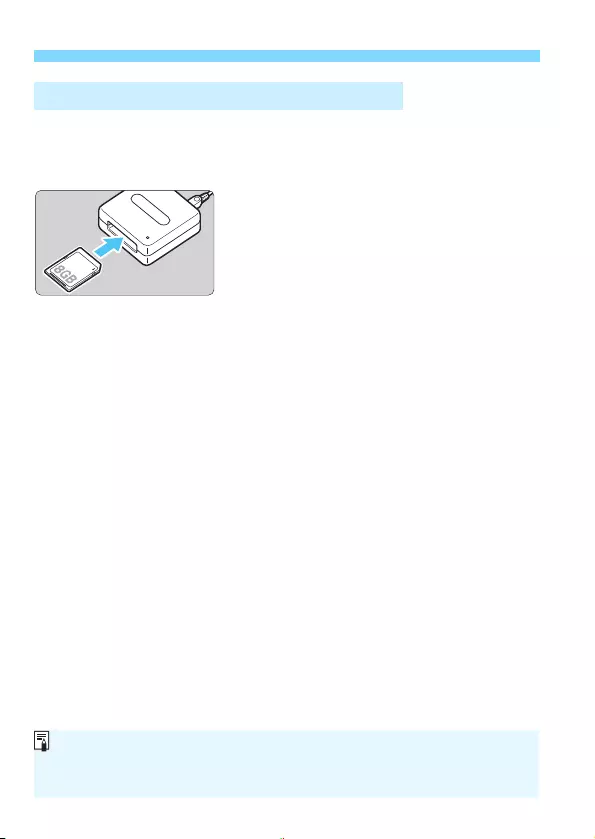
Downloading Images to a Computer
318
You can also use a card reader to download images to a computer.
1Install the software (p.315).
2Insert the card into the card
reader.
3Use Digital Photo Professional to
download the images.
Refer to the Digital Photo
Professional Instruction Manual.
Downloading Images with a Card Reader
When downloading images from the camera to a computer with a card
reader without using EOS software, copy the DCIM folder on the card to the
computer.

319
Index
Numerics
10- or 2-sec. self-timer ..................103
1280x720 (movie) .........................168
1920x1080 (movie) .......................168
640x480 (movie) ...........................168
9-point AF auto selection ................99
A
A (Scene Intelligent Auto)............58
Access lamp....................................38
Accessories.......................................3
Adobe RGB...................................137
AE lock..........................................120
AEB
(Auto exposure bracketing)...118, 260
AF 9 Focusing
AI FOCUS (AI Focus AF)................98
AI SERVO (AI Servo AF) ................98
Ambience-based shots ...................76
Angle of view...................................45
Aperture-priority AE ......................110
Aspect ratio...................................146
Auto Lighting Optimizer...........57, 123
Auto playback ...............................222
Auto power off.........................39, 185
Auto reset......................................189
Auto rotate vertical images ...........192
Autofocus ..................................97, 99
Automatic selection (AF point)........99
Av (Aperture-priority AE)...............110
B
B/W (Monochrome).................96, 128
Background music ........................225
Basic Zone modes ..........................30
Battery.................................34, 36, 40
Beep (Beeper)...............................184
Black-and-white images ... 76, 96, 128
Bracketing ............................ 118, 136
Brightness (exposure) .................. 116
Auto exposure bracketing
(AEB) ............................... 118, 260
Autoexposure lock (AE lock).... 120
Exposure compensation .......... 116
Measurement method
(metering mode)....................... 115
Built-in flash.................................. 104
Function settings...................... 199
BULB (bulb exposure) .................. 114
C
C (Creative Auto) ......................... 64
Cable........ 3, 216, 226, 242, 278, 317
Camera
Clearing the camera settings ... 194
Holding the camera.................... 46
Settings display........................ 193
Camera shake ................................ 46
Cards.................................. 25, 36, 52
Card reminder .......................... 184
Formatting.................................. 52
Low-level formatting................... 53
SD speed class ............................ 5
Troubleshooting ................... 38, 53
Write protection .......................... 36
Center-weighted average
metering ....................................... 115
Charger .................................... 31, 34
Checking depth of field................. 112
Cleaning (image sensor) .............. 204
Clearing the camera settings........ 194
Clipped highlights ......................... 234
Close-ups ....................................... 69
Color saturation ............................ 127
Color space
(color reproduction range) ............ 137

320
Index
Color temperature.........................131
Color tone ............................... 71, 127
Continuous file numbering ............188
Continuous shooting ..................... 102
Contrast ........................................127
Copyright information.................... 190
Creative Auto ..................................64
Creative filters...............................236
M (Creative Zone) icon....................8
Creative Zone modes .....................30
Custom Functions.........................258
Custom white balance .................. 133
D
Date/time ........................................41
Daylight saving time........................42
DC Coupler ...................................270
Depth-of-field preview...................112
Dial..........................................26, 107
Digital terminal ......................242, 317
Dioptric adjustment .........................46
Direct printing................................242
DPOF (Digital Print Order Format)
...251
Drive/Self-timer.........28, 66, 102, 103
Dust Delete Data .......................... 202
E
Erasing images.............................230
Error codes ...................................298
Evaluative metering ......................115
Exposure compensation ...............116
Exposure level increments............260
External flash ................................272
Custom Functions ....................201
Eyecup.......................................... 271
Eye-Fi cards..................................274
Eyepiece cover ....................... 33, 271
F
Faithful ........................................... 96
FE lock ......................................... 121
Feature guide ................................. 55
FEB .............................................. 199
File extension ............................... 189
File name ..................................... 188
File size .......................... 89, 169, 232
Filter effects.................................. 128
Final image simulation ......... 143, 166
Fine (image-recording quality) ....... 28
Firmware ...................................... 283
First-curtain synchronization ........ 200
Fish-eye effect.............................. 238
Flash (Speedlite)
Built-in flash ............................. 104
Custom Functions.................... 201
Effective range......................... 105
External flash ........................... 272
FE lock..................................... 121
Flash control ............................ 198
Flash exposure compensation
... 117
Flash mode .............................. 200
Flash off ......................... 63, 66, 75
Flash sync contacts ................... 26
Flash sync speed ............. 261, 273
Manual flash ............................ 200
Red-eye reduction ................... 106
Shutter synchronization
(1st/2nd curtain)....................... 200
Focus indicator............................... 58
Focus lock ...................................... 61
Focus mode
switch ............................. 44, 101, 156
Focusing
AF method ....................... 148, 176
AF operation .............................. 97
AF point selection ...................... 99

321
Index
AF-assist beam.................100, 264
Beeper ......................................184
Difficult subjects for AF .....101, 152
Manual focusing ...............101, 156
Out of focus ................46, 101, 152
Recomposing..............................61
Focusing point (AF point)................99
Folder creation/selection...............186
Food................................................71
Formatting (card initialization).........52
Frame rate ....................................168
Full High-Definition
(Full HD)................................168, 216
Fully automatic shooting
(Scene Intelligent Auto)...................58
Functions settable by
shooting mode ..............................276
G
Grainy B/W....................................238
Grid display ...........................145, 179
H
HDMI.....................................216, 226
High ISO speed noise reduction ...263
High-Definition (HD) movies
...168, 216
Highlight alert................................234
Highlight tone priority ............177, 263
Histogram (Brightness/RGB) ........234
Hot shoe..................................26, 272
Household power ..........................270
I
ICC profile .....................................137
Image dust prevention ..........202, 204
Image review time.........................184
Image Zone.....................................30
Image-recording quality ..................88
Images
Auto playback .......................... 222
Auto rotation............................. 192
Erasing..................................... 230
Highlight alert ........................... 234
Histogram................................. 234
Image characteristics
(Picture Style)............. 95, 126, 129
Index display ............................ 208
Jump display
(image browsing) ..................... 209
Magnification............................ 210
Manual rotation ........................ 211
Numbering ............................... 188
Playback ............................ 83, 207
Protecting................................. 228
Rating....................................... 212
Review time ............................. 184
Shooting information ................ 232
Slide show................................ 222
Viewing on a TV set ......... 216, 226
Index display ................................ 208
ISO speed ...................................... 92
Automatic setting (Auto)............. 93
ISO expansion ......................... 260
Maximum ISO speed
for ISO Auto ............................... 94
J
JPEG .............................................. 89
Jump display ................................ 209
L
Landscape................................ 68, 96
Language selection ........................ 43
Large (image-recording quality) ..... 28
LCD monitor ................................... 24
Brightness adjustment ............. 185
Image playback.................. 83, 207
Menu display ...................... 50, 280
Screen color............................. 197
Shooting function settings.... 28, 54

322
Index
Lens................................................44
Lock release ...............................45
Peripheral illumination
correction.................................. 124
Lighting/scene-based shots ............80
Live View shooting.................. 62, 139
Aspect ratio .............................. 146
Face detection Live mode
(AF) .......................................... 149
FlexiZone - Single ....................148
Grid display ..............................145
Information display ...................142
Manual focusing (MF).......101, 156
Metering timer .......................... 147
Possible shots ..........................141
Quick Control............................144
Quick mode ..............................154
Long exposure noise reduction.....262
Long exposures ............................114
M
M (Manual exposure)....................113
Macro photography.........................69
Magnification.........................156, 210
Manual exposure ..................113, 162
Manual focusing (MF)...........101, 156
Manual reset.................................189
Manual selection (AF point) ............99
Maximum burst .........................89, 90
Medium (image-recording quality)
...28
Memory cards 9 Cards
Menu............................................... 50
My Menu...................................267
Setting procedure .......................51
Settings ....................................280
3 icon .........................................8
Metering mode..............................115
Metering timer.......................147, 179
MF (manual focusing)...........101, 156
Microphone .................................. 160
Miniature effect............................. 238
Mode Dial ....................................... 30
Monochrome .................... 76, 96, 128
Movies.......................................... 159
AF method ....................... 167, 176
Autoexposure........................... 160
Editing out first and
last scenes............................... 220
Enjoying ................................... 216
File size.................................... 169
Frame rate ............................... 168
Grid display .............................. 179
Information display................... 164
Manual exposure shooting....... 162
Manual focus ........................... 160
Metering timer.......................... 179
Movie recording size................ 168
Playback .................................. 218
Quick Control ........................... 167
Recording time......................... 169
Sound recording ...................... 178
Video snapshot album ............. 170
Video snapshots ...................... 170
Viewing on a TV set ......... 216, 226
Wind filter................................. 179
My Menu ...................................... 267
N
Neutral............................................ 96
Night Portrait .................................. 72
Night scenes ............................ 68, 72
Noise reduction
High ISO speed ....................... 263
Long exposures ....................... 262
Nomenclature................................. 26
Non-Canon flash units.................. 273
Normal (image-recording quality)... 28
NTSC ................................... 168, 284

323
Index
O
ONE SHOT (One-Shot AF).............97
P
P (Program AE)...............................86
PAL .......................................168, 284
Paper settings (printing)................244
Partial metering.............................115
Peripheral illumination correction
...124
Photobook set-up..........................255
PictBridge......................................241
Picture Style....................95, 126, 129
Pixel count ......................................88
Playback .................................83, 207
Portrait ......................................67, 95
Possible shots...................40, 88, 141
Power
Auto power off ..........................185
Battery level................................40
Household power......................270
Possible shots ..............40, 88, 141
Recharge ....................................34
Predictive (AI Servo) .......................98
Pressing completely........................47
Pressing halfway.............................47
Printing..........................................241
Cropping ...................................249
Page layout...............................245
Paper settings...........................244
Photobook set-up .....................255
Print order (DPOF) ...................251
Printing effects..........................246
Tilt correction ............................249
Program AE ....................................86
Program shift...................................87
Protecting images .........................228
Q
Q
(Quick Control)
...48, 74, 144, 167, 214
Quick Control.................................. 74
Quick mode .................................. 154
R
Rating mark .................................. 212
RAW ................................... 28, 89, 91
RAW+JPEG........................ 28, 89, 91
Recharging ..................................... 34
Red-eye reduction ........................ 106
Release shutter without card........ 184
Remote switch.............................. 271
Resizing........................................ 239
Revert to default settings.............. 194
Rotation (image)........... 192, 211, 249
S
Safety precautions.......................... 20
SD, SDHC, SDXC cards 9 Cards
Second-curtain synchronization ... 200
Self-timer ...................................... 103
Sensitivity 9 ISO speed
Sensor cleaning............................ 204
Sepia (monochrome).............. 76, 128
Sharpness .................................... 127
Shooting function settings ........ 28, 54
Shooting information display ........ 232
Shooting modes ............................. 30
Av (Aperture-priority AE).......... 110
M (Manual exposure) ............... 113
P (Program AE).......................... 86
Tv (Shutter-priority AE) ............ 108
A (Scene Intelligent Auto)....... 58
7 (Flash Off) ............................ 63
C (Creative Auto)..................... 64
2 (Portrait) ................................ 67
3 (Landscape)......................... 68
4 (Close-up) ............................. 69
5 (Sports) ................................ 70
P (Food) .................................... 71
6 (Night Portrait)....................... 72

324
Index
Shutter button ................................. 47
Shutter synchronization
(1st/2nd curtain)............................200
Shutter-priority AE ........................108
Single shooting .......................66, 277
Single-image display.......................83
Single-point AF ...............................99
Slide show ....................................222
Small
(image-recording quality) ........28, 240
Soft focus...................................... 238
Speaker.........................................218
Sports..............................................70
sRGB ............................................ 137
Stop down aperture.......................266
Strap ...............................................33
System map..................................278
T
Temperature warning ............157, 181
Time zone ....................................... 41
Tone priority ..........................177, 263
Toning effect (monochrome) .........128
Toy camera effect .........................238
Tripod socket .................................. 27
Troubleshooting ............................ 286
Tv (Shutter-priority AE) .................108
U
USB (digital) terminal............242, 317
V
Video snapshot album ..................170
Video snapshots ...........................170
Video system ........................ 168, 179
Viewfinder ....................................... 29
Dioptric adjustment.....................46
Viewing on a TV set..............216, 226
Volume (movie playback)..............219
W
White balance (WB) ..................... 131
Ambience priority (Q)............ 132
Bracketing................................ 136
Correction ................................ 135
Custom .................................... 133
Personal................................... 134
White priority (Qw)................ 132
Wi-Fi/NFC .................................... 283
Wind filter ..................................... 179

325
MEMO

The descriptions in this Instruction Manual are current as of December 2015.
For information on the compatibility with any products introduced after this date,
contact any Canon Service Center. For the latest version Instruction Manual,
refer to the Canon Web site.
CPX-E173-000 © CANON INC. 2015

